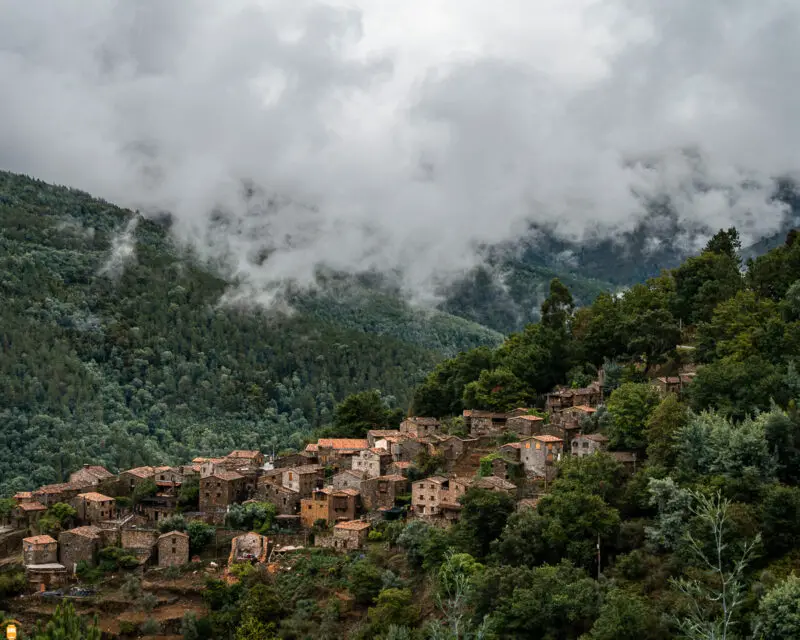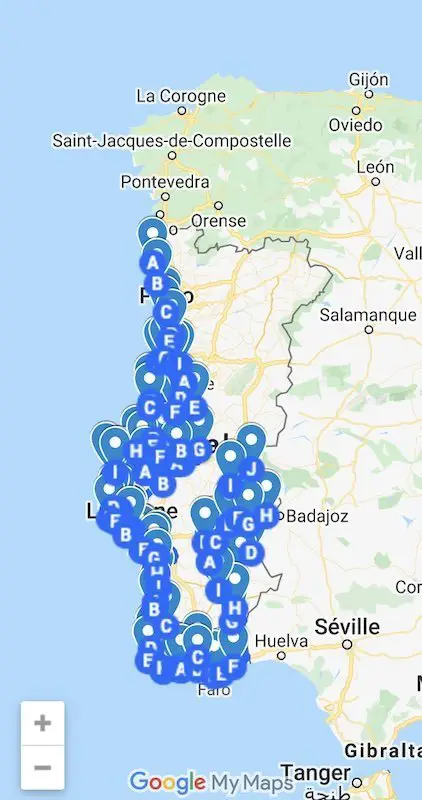Once, there was a small corner in Europe of 92 090 km2, a place which became known as Portugal (1139 A.D.) – D. Afonso Henriques was the founder of this kingdom and its first king.
In the 15th and 16th centuries, during the Age of Discoveries, the Portuguese went on several voyages and maritime explorations, in search of new trade routes.
The Kingdom of Portugal colonised territories in Africa, Asia and South America, becoming the world’s first political, economic and cultural power. The Portuguese discoveries played a major role in shaping the world map. The Kingdom of Portugal was the first global empire and the longest of the modern European colonial kingdoms.
Disclosure: This post may contain affiliate links, meaning i get a commission if you decide to make a purchase through my links, at no cost to you. Please read my disclosure for more info.
Thanks to the Age of Discoveries, Portuguese is one of the most spoken languages in the world: Brazil, Angola, Mozambique, Cape Verde, Guinea-Bissau, São Tomé and Príncipe and East-Timor. Furthermore, there are also Portuguese language speakers in Macao (China) and in Goa (India).

Portugal is a country where the sun shines 300 days in the year, a country with an amazing history, an extraordinary culture, a delicious gastronomy, magnificent landscapes, beautiful beaches, mountains greater than you can imagine and warm people that will make you feel at home.
Despite being a small country (in size), when visiting Portugal, you will not have time to get bored, because there are many wonders (monuments, landscapes, beaches, culture, gastronomy).
Portugal is also one of the few countries in the world that, once visited, is never forgotten. This country awakens in us a very unique feeling, Saudade, when we are far from this wonderful paradise.
In this article, I will show you the 100 most beautiful places to visit in Portugal and an itinerary so that you can easily discover these wonders.
Information: the places below refer only to mainland Portugal. To discover the wonders of the Portuguese islands, I invite you to read the article with the best places to visit in the Azores archipelago and the best places to visit in the Madeira archipelago.
Here are the top 100 of the best places to visit and things to do in Portugal:
1. Santuário de Santa Luzia
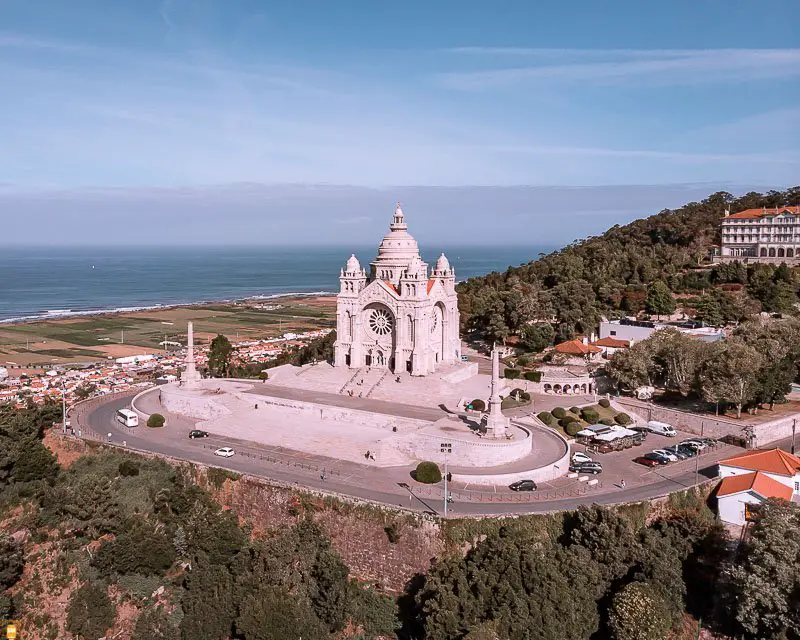
The Temple of the Sacred Heart of Jesus (also known as the sanctuary Santuário de Santa Luzia), built at the western end of Monte de Santa Luzia, in Viana do Castelo, is undoubtedly one of the most famous and emblematic monuments in the country.
This temple is an excellent example of neo-Romanesque and neo-Gothic architecture. The construction of the sanctuary at the top of Monte de Santa Luzia began in 1904 and was completed in 1959, due to the initiative of the brotherhood Irmandade de Santa Luzia.
To reach the Santa Luzia Sanctuary, you can choose to drive there, climb the many steps or use the Santa Luzia elevator, which can transport up to 24 people. The trip is 650 metres, with an inclination of 160 metres and a total duration of six to seven minutes.
For more details about the sanctuary and the city, I suggest you read the article Top 20 of the places to visit in Viana do Castelo.
2. Apúlia
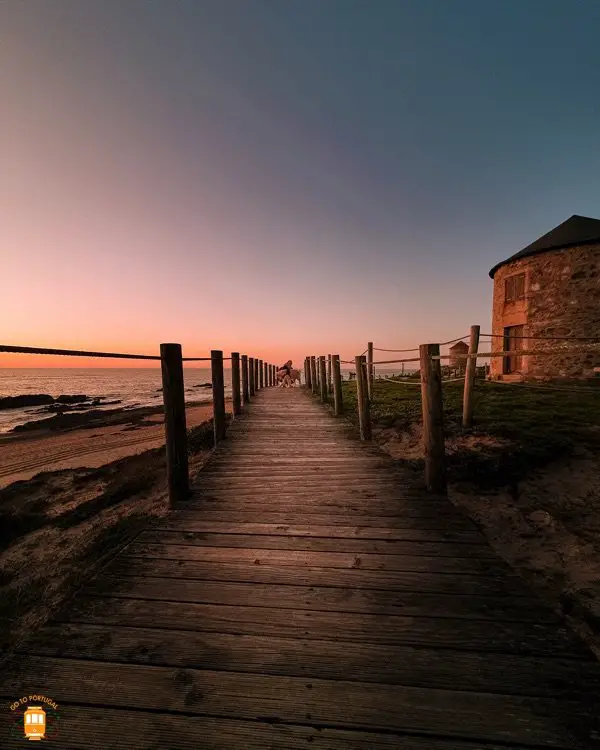
Located in the Protected Landscape Area of the Esposende Coast (35 km from Viana do Castelo), the small town of Apúlia is a very pleasant place due to its natural beauty and authenticity.
Apart from being able to enjoy some relaxing moments on the large beach, take the opportunity to admire the fishermen and their boats and do not hesitate to take a short walk on the wooden walkways to admire the windmills on the dunes.
3. Porto

Porto is the city that gave Portugal its name (Portucale) and the famous Portuguese wine with the same name (Port wine). But the city is not just that, and it is no wonder that it was chosen in 2012, 2014, 2017 as the best European tourist destination.
When visiting Porto, you will discover an amazing city, where the old and new live in perfect harmony, a city that is both cosmopolitan and intimate at the same time.
Porto is a source of inspiration, where visitors always come back!
Here are the places not to be missed during your visit to Porto:
- Clérigos Tower
- Porto Cathedral
- São Bento Train Station
- Bolsa Palace
- São Francisco Church
- Luis I Bridge
- Serra do Pilar Monastery
- Port wine cellars
- Bolhão Market
- Santa Catarina Street
- Ferdinand Wall
- Church of Santa Clara
- Ribeira District
- Lello Bookshop
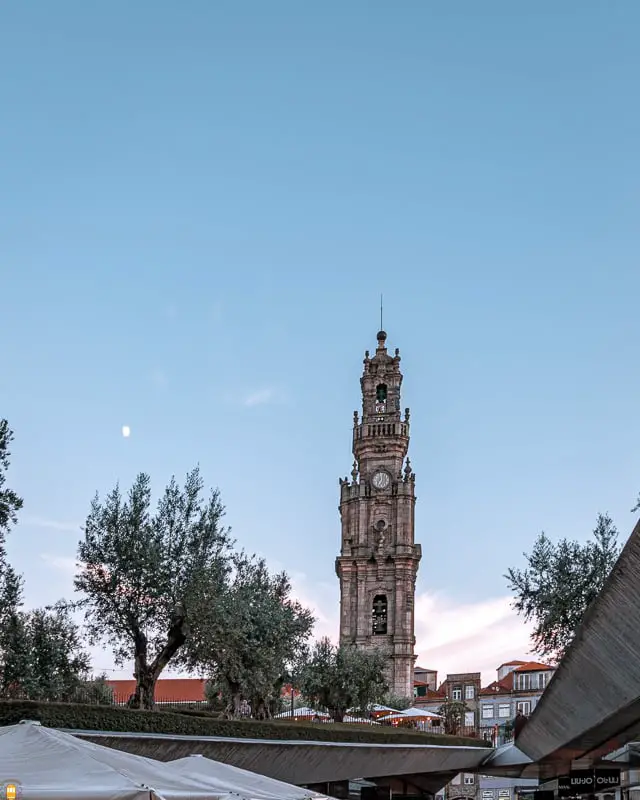
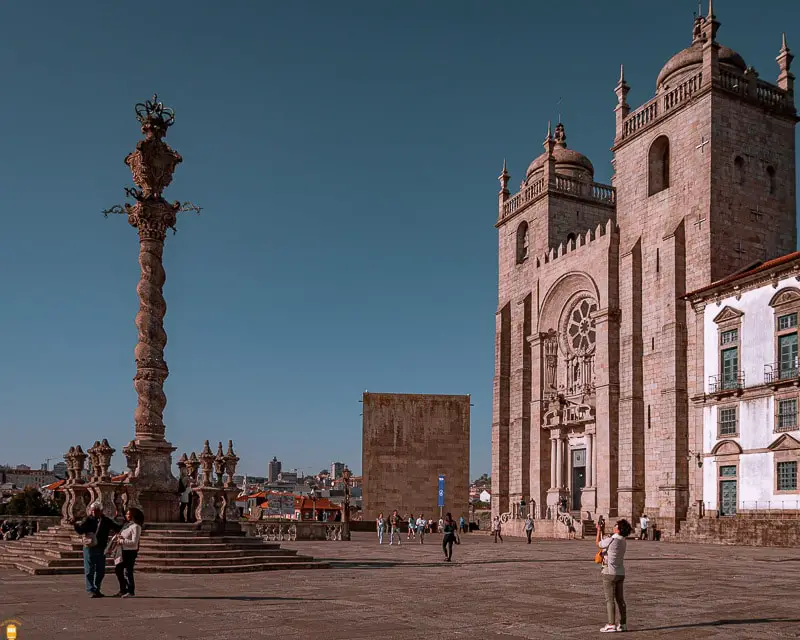
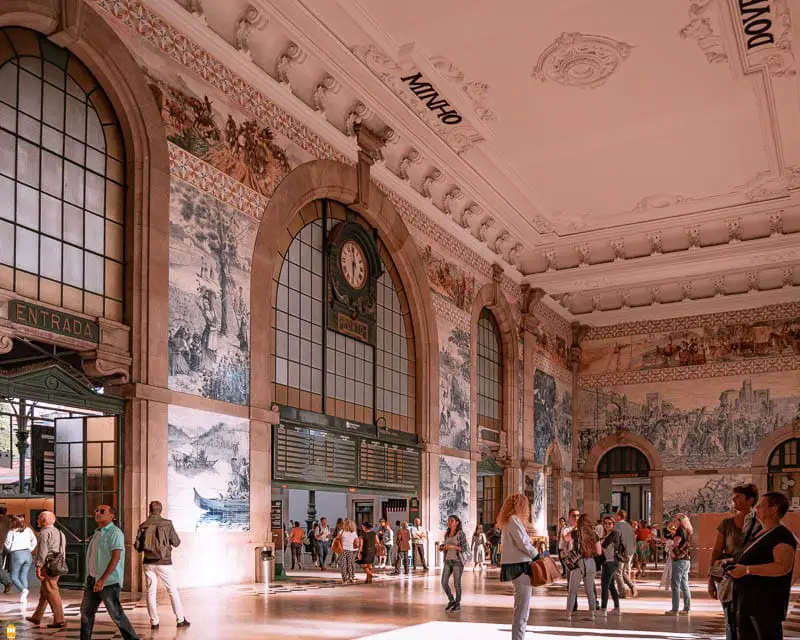
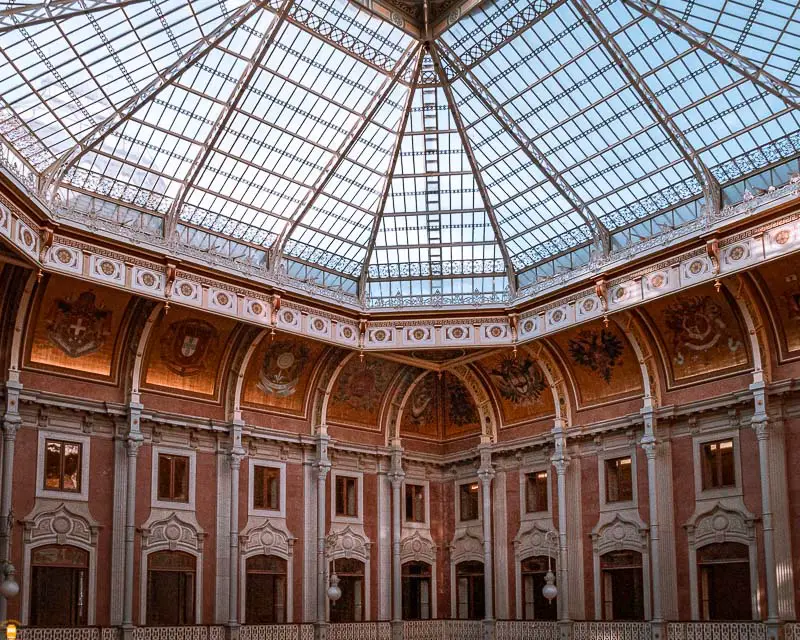


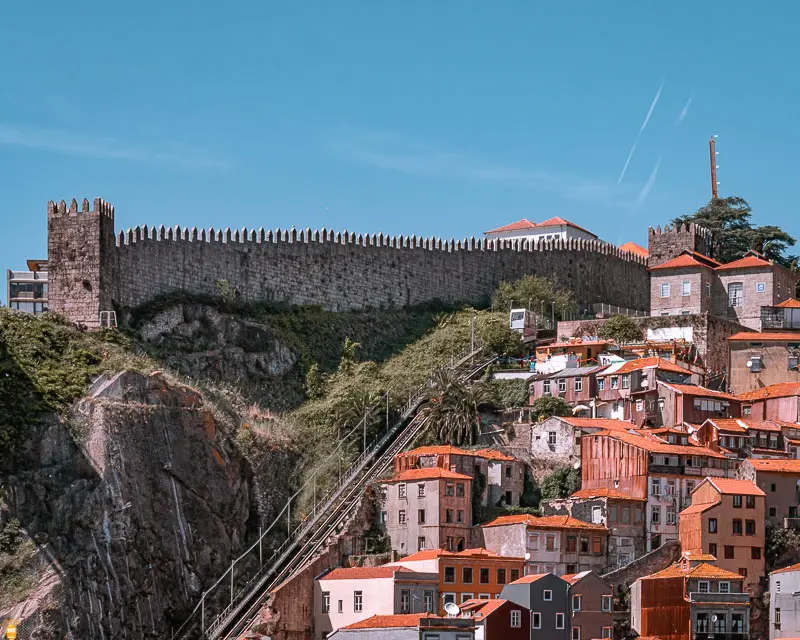
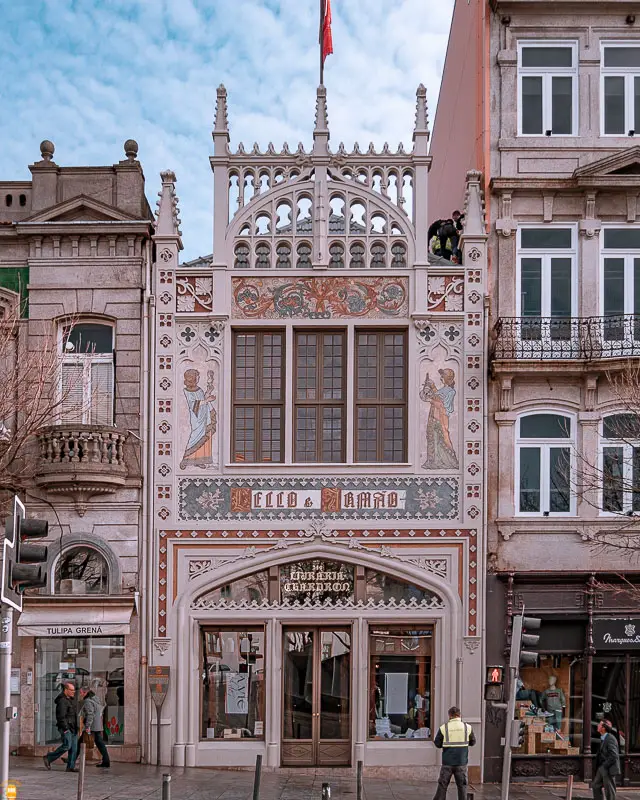
In addition to these wonderful places, there is much more to visit! Read this article for a detailed tour of the city of Porto.
4. Praia do Senhor da Pedra

The Senhor da Pedra beach has as its main attraction the chapel Capela do Senhor da Pedra, from the 18th century, built on some rocks by the sea. On days when the sea is more agitated, the beach is the ideal place for water sports such as surfing and bodyboarding.
5. Castelo de Santa Maria da Feira

Built before the 11th century, the castle of Santa Maria da Feira is older than the Portuguese nation. According to history, it was here that the battle of São Mamede (Guimarães) was prepared, a battle that put the future first Portuguese king Dom Afonso Henriques and his mother Teresa de Leão, who was fighting for present-day Spain, face to face.
During your visit, walk along the ramparts, admire the beautiful keep with 4 towers and the chapel in honour of Nossa Senhora da Encarnação.
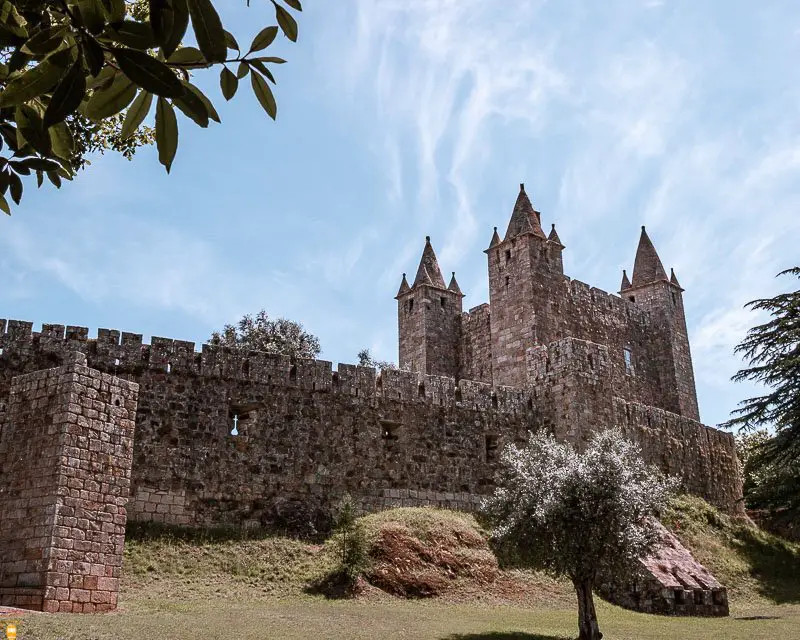
6. Ovar
Known in Portugal for its delicious Pão de Ló (similar to the English sponge cake, or even the French Savoy cake), the municipality of Ovar hides other wonders that I suggest you discover during your visit to Portugal.
In the north of the municipality you’ll find Barrinha de Esmoriz, a lagoon where you can admire the beautiful flora and fauna while walking on the 8 km wooden walkways, created to allow people to explore this natural wonder.
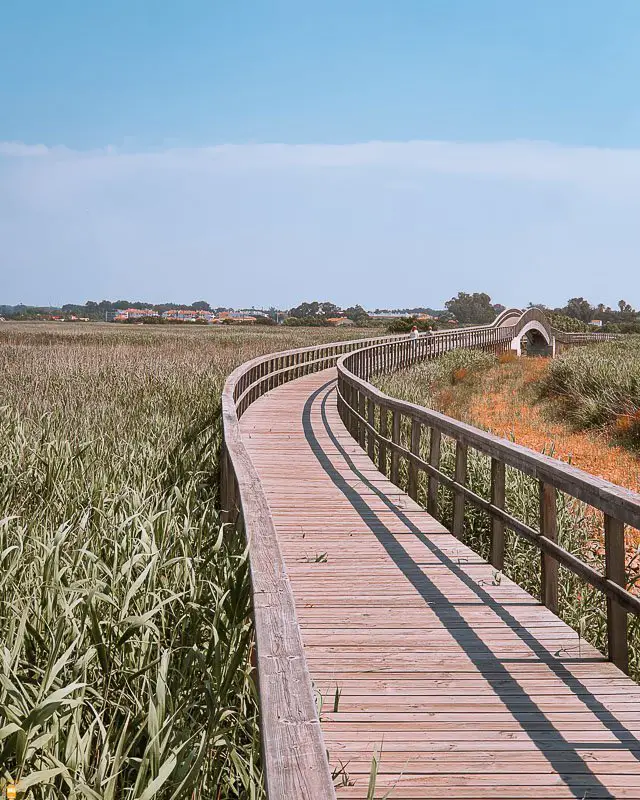
Back to the city of Ovar, you will find many beaches. The most famous are: Esmoriz beach, Cortegaça beach, Furadouro beach and in the south of the city, you will find the Ria de Aveiro (45 km lagoon).
Apart from these natural wonders, this municipality hides two treasures built by human hands, the sumptuous church Igreja Matriz de Santa Maria de Válega and the church Igreja Matriz de Santa Marinha de Cortegaça.

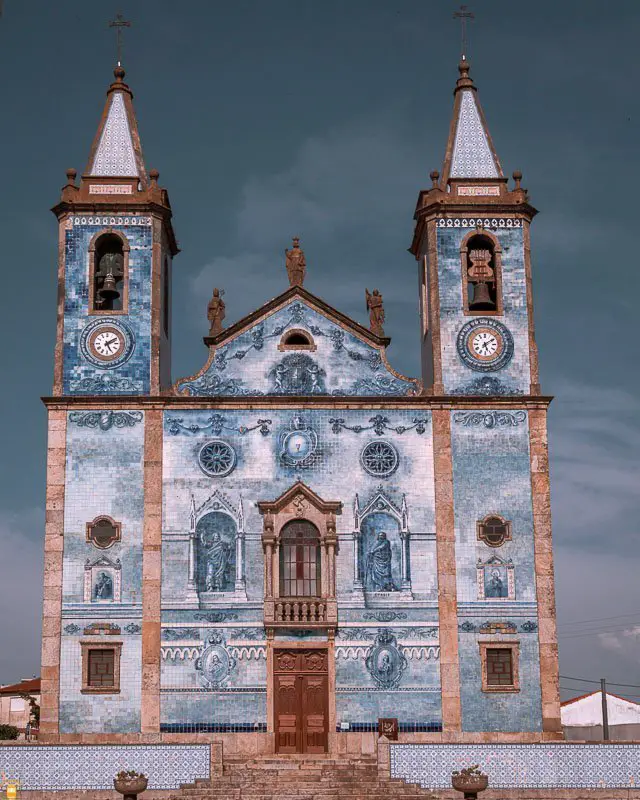
7. Aveiro
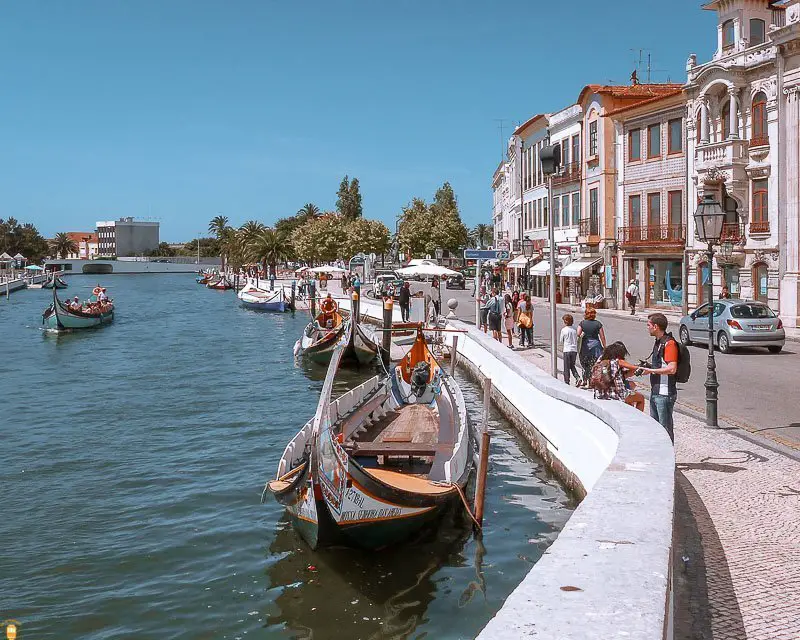
Known as the Portuguese Venice, Aveiro is a thousand years old, of which two hundred and fifty as a city. It was founded due to salt production and maritime trade.
At the end of the 16th century, the instability of vital communication between the Ria and the sea led to the closure of the channel, preventing the use of the port and creating unhealthy conditions, caused by the stagnation of the water in the Ria.
At the beginning of the 19th century, the channel was finally reopened (Barra), beginning a period of great development there.
Aveiro has some incredible places that will make your eyes glow and your visit to this city be worthwhile.
During your visit to the city, do not hesitate to take a short detour to discover the Costa Nova beach and its beautiful fishermen’s houses painted with vertical and horizontal stripes and in different colours, which brings a special charm to this place.

Read my article and discover the top 10 of the places to visit in Aveiro.
8. Umbrella Sky Project

Present in Águeda, from July 1 to September 30 since 2012, the Umbrella Sky Project is a project created by the agency Sexta Feira that aims to bring colour and joy to the city.
In addition to the beautiful umbrellas hanging on the streets of the historic centre (Rua Luís de Camões, as well as on the adjacent streets), the benches, posts and facades are covered with beautiful works of urban art.
This project is such a success that the agency Sexta Feira was invited to recreate it all over the world.
If you come to Águeda during winter, know that in December, the city is lit up with the colours of Christmas with its umbrellas!
9. Pateira de Fermentelos
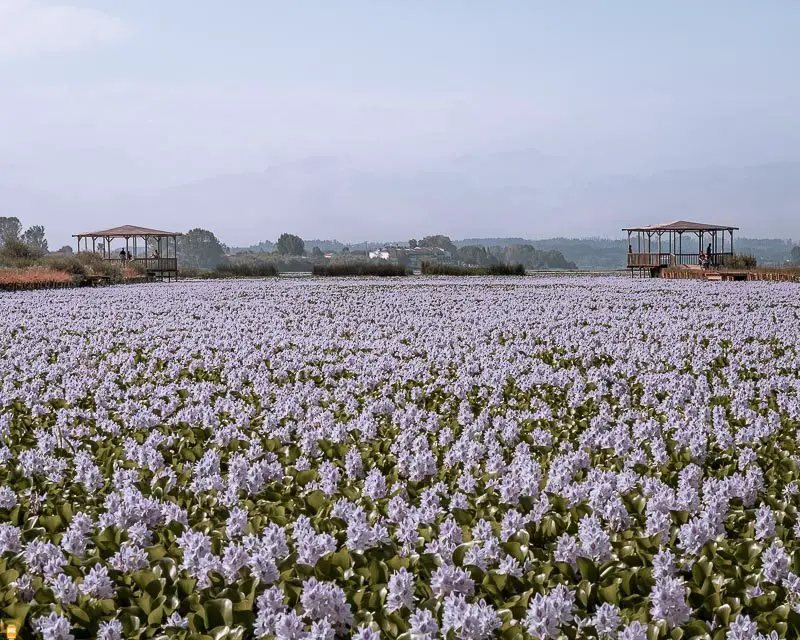
The Pateira de Fermentelos lagoon started to form in the 15th century, after the numerous floods of the Certoma and Águeda rivers, which spread through the neighbouring fields.
Currently, it is the largest natural lake in the Iberian Peninsula, with about 5 km2.
Before visiting this place, I did some research and saw some pictures on the internet. At first glance, it was a beautiful place, but nothing special.
As soon as I visited it and after a few seconds of admiring the Pateira de Fermentelos lagoon, I was speechless with the natural beauty of this place!
Much of the lake had disappeared under a huge carpet of purple flowers, giving this place a breathtaking view.
I don’t remember seeing another place as romantic as this. It has become one of my favourite places across the country!
Do not hesitate to stroll along the banks of the lagoon to the gazebos to contemplate this wonder.
For more information about Pateira de Fermentelos and the Umbrella Sky Project, read the article What to visit in Águeda, the city of the colourful umbrellas.
10. Mata Nacional do Buçaco

The forest Mata Nacional do Buçaco is a protected place, located on the hills with the same name and close to the thermal town of Luso.
This forest was planted by the Order of the Carmelites in 1644 and today has an area of 400 hectares. There, you will find the convent Convento de Santa Cruz do Buçaco, which housed members of this Order from 1628 to 1834, when religious orders were disbanded.
In 1888, construction began on the Royal Palace (which destroyed part of the convent), a sumptuous monument that today houses the 5-star Palace Hotel do Bussaco.
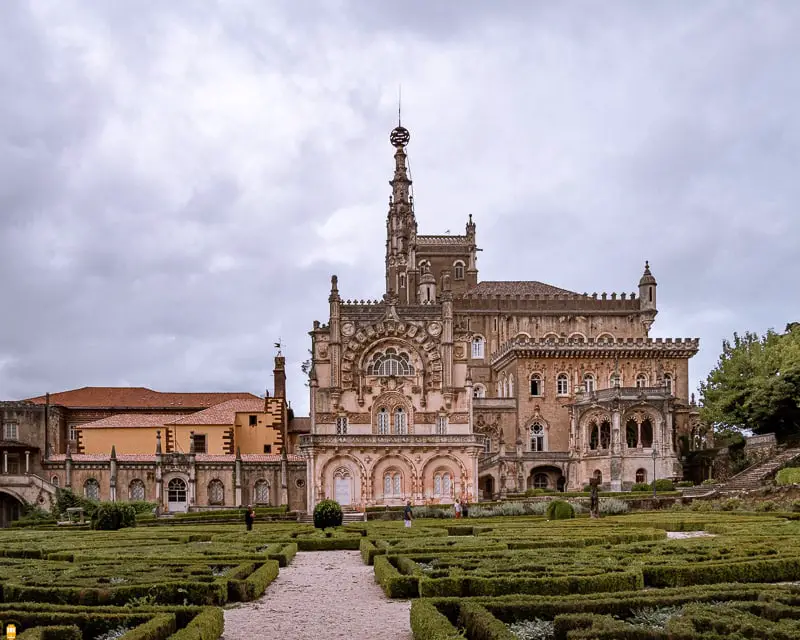
Apart from visiting this magnificent monument, I suggest you explore the gardens and the park that surrounds it, where there are many hermitages and chapels that date back to the time of the Order of the Carmelites. End your visit at the Cruz Alta viewpoint to admire this wonder at sunset!
11. Figueira da Foz
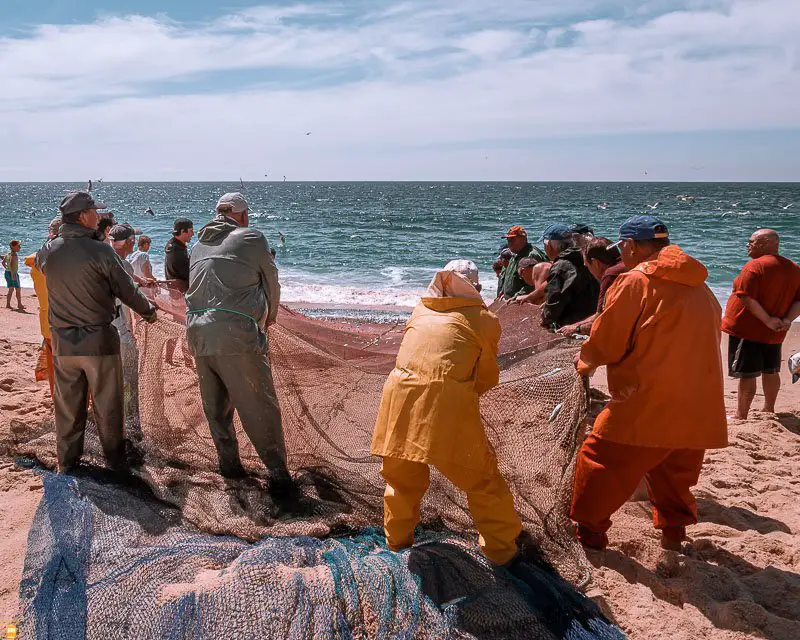
Well known in Portugal for its magnificent beaches, Figueira da Foz will surprise you with its wonders still little known, such as the sumptuous Sotto Mayor Palace.
Figueira da Foz started to be populated in the 11th century by the monastery Mosteiro de Santa Cruz de Coimbra and grew little by little over the centuries. It became a town in 1771. In the 19th century, Figueira da Foz doubled its population thanks to the port and shipbuilding, as well as the arrival of many tourists to enjoy the magnificent beaches.
To accommodate so many people, a new neighbourhood (Bairro Novo) has emerged facing the sea, inspired by the French resorts of Arcachon and Biarritz. It is in this area that the casino and most hotels, restaurants and bars are located.
In 1882, Figueira da Foz went from being a town to being a city, and today it houses more than 62 000 inhabitants (city centre and neighbouring villages).
You can visit this city just to enjoy its beautiful beach, but when you discover the treasures that Figueira da Foz hides, you will discover a city that will surprise you with its authenticity and beauty.
Here are the places you shouldn’t miss:
- Sotto Mayor Palace
- Parish of Buarcos
- Bandeira viewpoint, located in the hill Serra da Boa Viagem
- Costa de Lavos
To discover the wonders of this city in detail, read the article Top of the places to visit in Figueira da Foz.
12. Coimbra
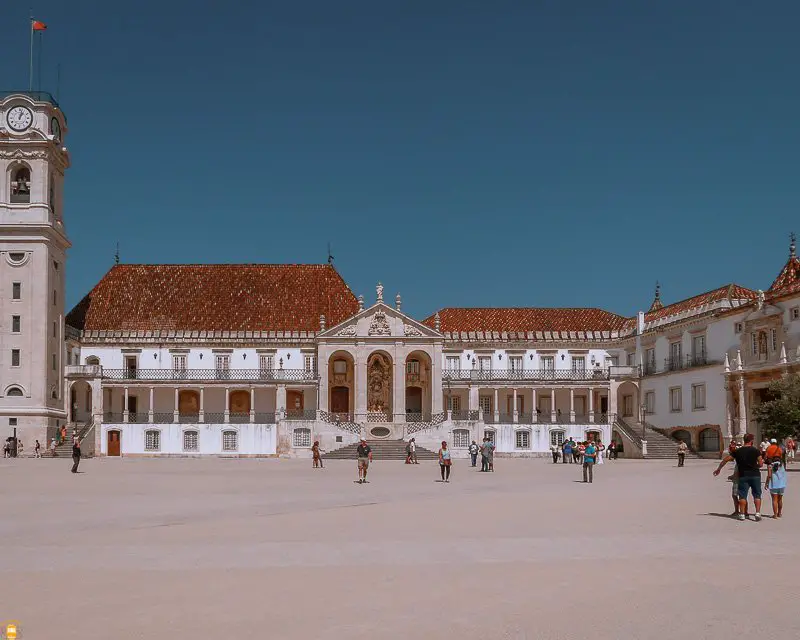
Known in Portugal as the city of students, Coimbra has an incredible history and monuments that you should definitely not miss when visiting Portugal!
One of these monuments is the University of Coimbra Alta & Sofia, listed as a World Heritage Site by UNESCO. Founded in Lisbon in 1290, it was permanently transferred to Coimbra in 1537 and today it is considered one of the oldest universities in Europe.
One of the points of interest that you should not miss when visiting the University of Coimbra is without a doubt the Biblioteca Joanina, considered one of the most beautiful libraries in the world.
To discover the other beautiful places in the city, please read the article Top 10 of the places to visit in Coimbra.
When visiting Coimbra, don’t miss the opportunity to make a detour and discover the best preserved ancient Roman city in Portugal. Conímbriga is located 16 km from Coimbra and offers the possibility to see what a Roman city was like 2000 years ago!
As a curiosity, know that Coimbra adopted its current name, after the abandonment of the city of Conímbriga by its inhabitants, who left to take refuge from the attacks of the Sueves (Germanic people) in the 5th century.
13. Schist Villages
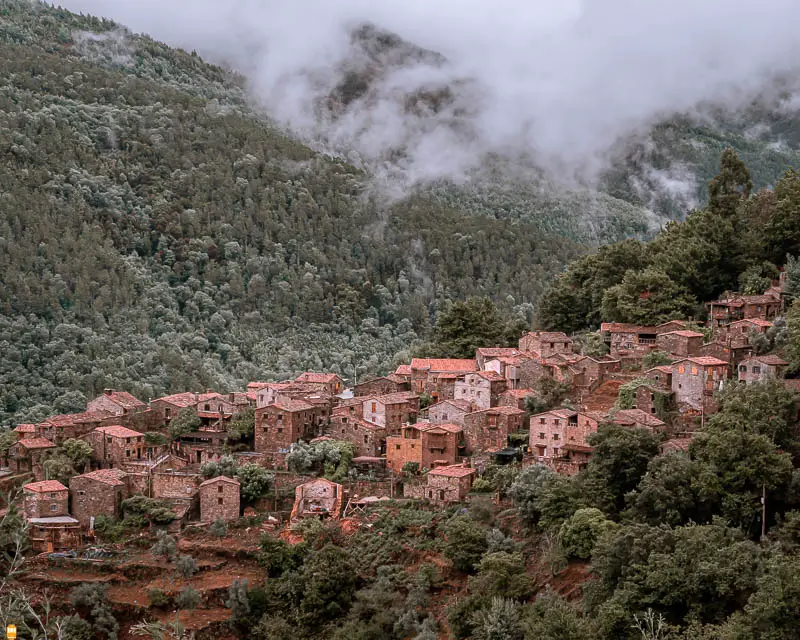
The schist villages are located mainly in the mountain ranges of Lousã and Açor, close to the cities of Coimbra and Castelo Branco.
These villages were built with local materials (schist) that give them a very special character. In addition to being able to admire the beautiful houses and streets, you will find countless walking routes, mountain bike trails and river beaches.
Of the 27 villages belonging to the schist village network, I recommend you discover Talasnal, Casal de São Simão, Cerdeira, Chiqueiro, Candal, Aigra Nova, Álvaro, Pena and Sobral de São Miguel.
For more information and photos of each village, visit the official website of this network (in Portuguese).
14. Buracas do Casmilo
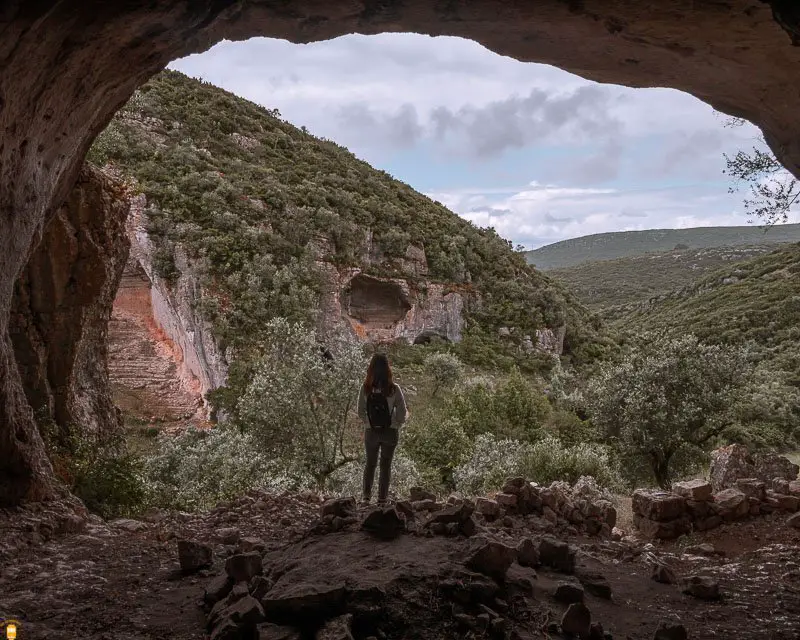
Located 24 km from Coimbra, Buracas do Casmilo is a geological formation that corresponds to what remains of several rooms in a huge cave that collapsed.
This place is very photogenic and it is worth taking a detour when visiting Coimbra. To get there, leave your car at the village of Casmilo and walk 1.5 km on a dirt road. Take the opportunity to enjoy the scenery and take beautiful photos.
15. Penedo Furado

Located in the municipality of Vila de Rei, very close to the N2 road (the longest road in Portugal with 739 km – I will talk a little more about that below), Penedo Furado is a place where you can admire hills covered with pine forests, the Codes creek, the Castelo do Bode dam reservoir, thanks to the viewpoints of Penedo Furado, Fragas de Rabadão and Cristo Rei.
Aside from being able to admire these beautiful landscapes, you will find a river beach very popular amongst those who visit this place and a waterfall accessible by wooden walkways more than 500 metres away.
16. Castelo de Almourol
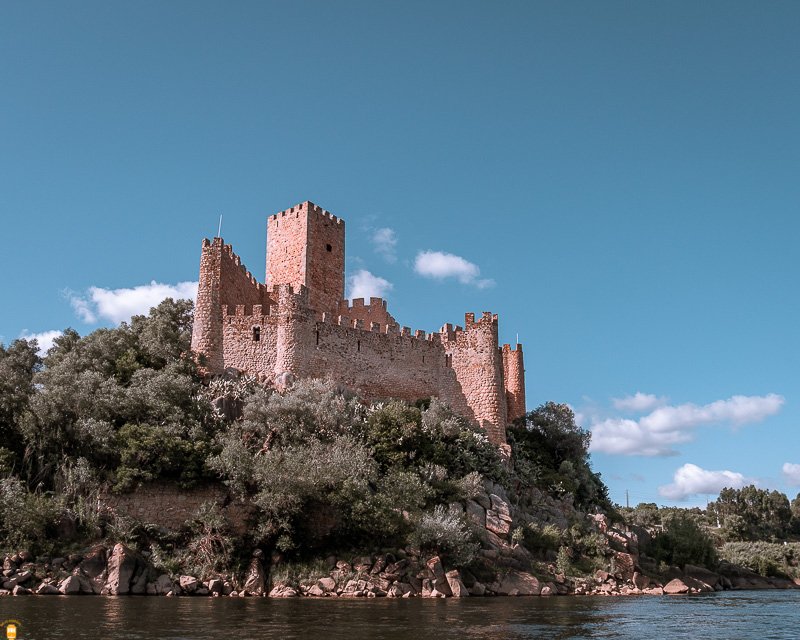
Located on a small island on the Tagus river, this castle was built in the 12th century and belonged to the Knights Templar and the Order of Christ. Undoubtedly one of the most beautiful castles in Portugal!
To visit the Castle of Almourol, you must board a small boat located on the left bank of the river, in the municipality of Praia do Ribatejo. To take beautiful pictures, I suggest you go to the Almourol viewpoint, located on the right bank of the Tagus river.
17. Museu Nacional Ferroviário

The National Railway Museum presents visitors with 160 years of railway history in Portugal. Here, you will find more than 36.000 objects large and small, like locomotives and wagons of the presidential train used for more than a century by presidents, heads of state, kings and popes!
18. Convento de Cristo
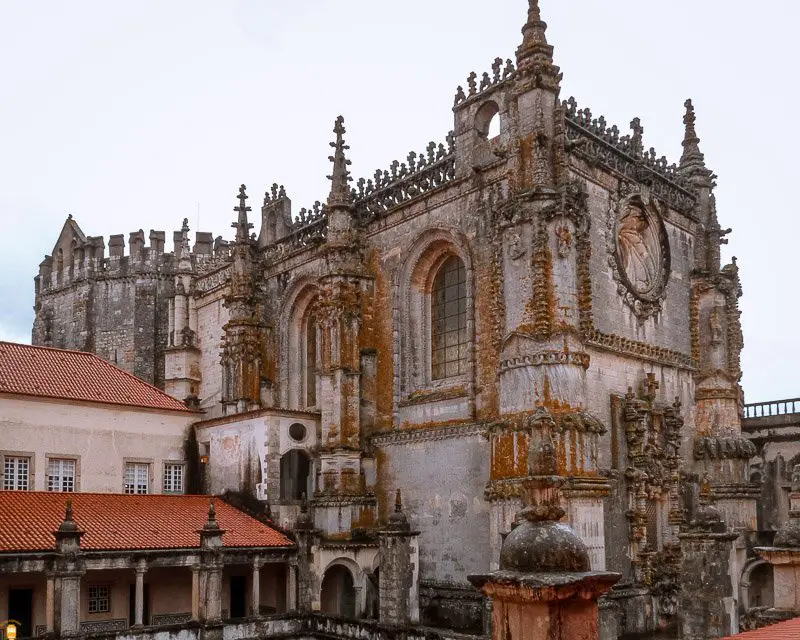
Listed as a World Heritage Site by UNESCO in 1983, the convent Convento de Cristo is today one of the most beautiful Portuguese monuments. It has benefited from the influence of various architectural styles, over several centuries, including Romanesque, Gothic, Manueline and Renaissance styles.
The person responsible for the construction of Convento de Cristo and the castle that surrounds it was the Grand Master of the Knights Templar, Gualdim Pais, in the 12th century. This inheritance was later handed over to the Order of Christ before it became property of the Portuguese state.
The monument offers its visitors several points of interest, such as the castle, the Gothic and Renaissance cloisters, the charola (see picture above) and the Manueline church.
For more information about this monument and other places to visit in Tomar, read the article Visit Tomar and discover the magnificent city of the Knights Templar!
19. Santuário de Fátima
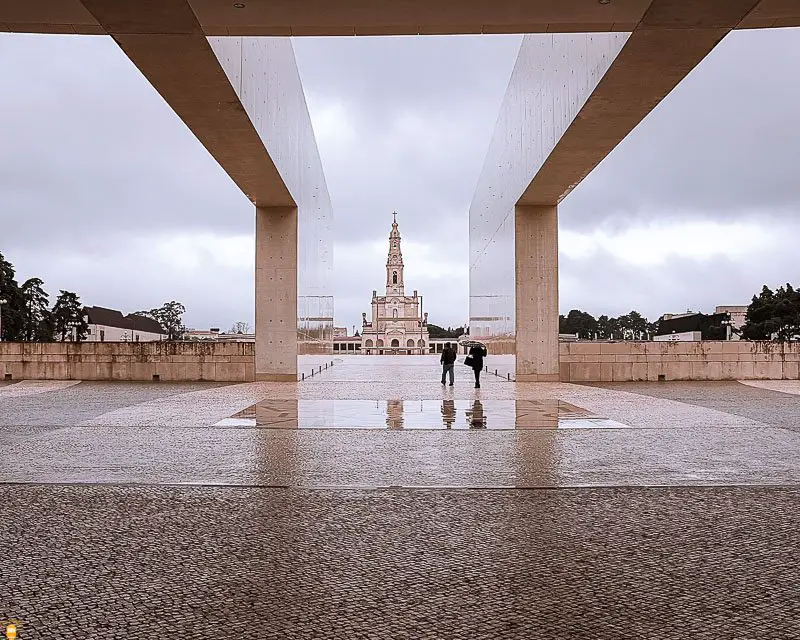
Located in Central Portugal, the small city of Fátima (11.596 inhabitants) has, over the years, become the fourth biggest Catholic pilgrimage site in the world, after the apparition of the Virgin Mary in 1917 to three young shepherds.
On May 13, 1917, Lúcia and her cousins Jacinta and Francisco, 12, 9 and 7 years old, were taking care of their sheep in Cova da Iria, Fátima, when they saw a bright light appear in front of them.
They first thought it was lightning, but then a brighter light illuminated the place. It was then that they saw close to a small tree (holm oak) a lady brighter than the sun.
This lady asked them to come to Cova da Iria on the 13th of each month, at the same time, for 6 months. She promised them to reveal her identity as well as the purpose of her coming.
Throughout the apparitions, this lady made some revelations, such as the end of the First World War, that Francisco and Jacinta would soon go to heaven (Francisco died in 1919 and Jacinta in 1920, due to the Spanish flu).
As the months passed, the crowd grew larger and larger. During the second apparition, 50 people were present; on October 13, during the sixth apparition, there were more than 50.000 people to witness the miracle promised by this lady.
It was on that occasion that the young shepherds discovered that this lady was Our Lady of the Rosary (Nossa Senhora do Rosário).
As nobody saw Our Lady of the Rosary (except for the young shepherds), on October 13, 1917 a miracle occurred so that the crowd could see and believe in the apparition of the Virgin Mary.
This day was very rainy, when suddenly the clouds disappeared to make way for a bright sun with a blue sky.
Then a light phenomenon occurs in the sky called hereinafter “the miracle of the sun” or “dance of the sun”. Do not hesitate to click on the link above to learn more about the “miracle of the sun”.
To discover the places to visit in and around Fátima, I suggest you read the article What to visit in Fátima, the fourth biggest Catholic pilgrimage site in the world!
20. Parque Natural das Serras de Aire e Candeeiros
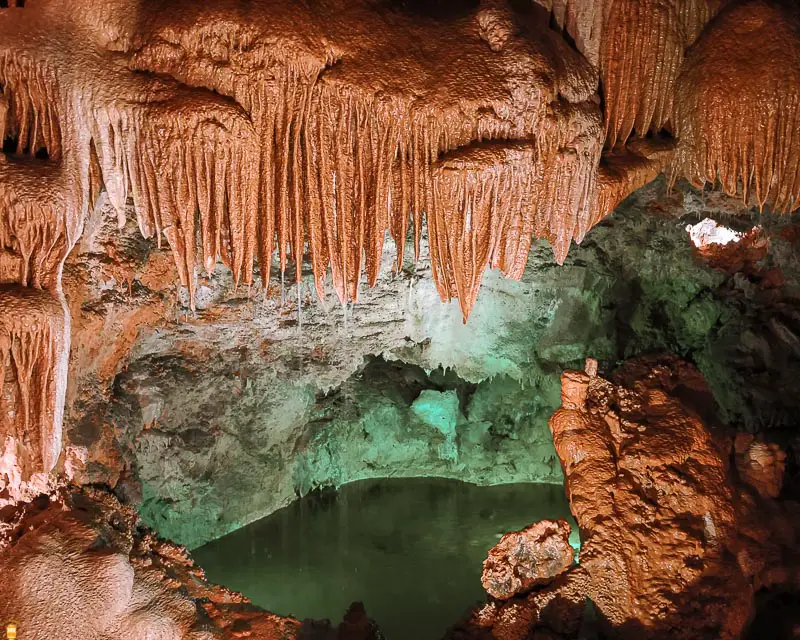
The mountain ranges Serras de Aire e Candeeiros Natural Park, with an area of approximately 35.000 hectares, was created in 1979, covering more than two thirds of the Estremadura limestone massif, which is the most important limestone area in Portugal.
The park consists of two mountain ranges, of which this park was named after, and the plateaus of Santo António and São Mamede.
As you walk through the park, you will see several small stone walls, called “chouços”, which are used to divide properties or to gather herds. You can also find small houses in the middle of the fields, which were previously used to protect the shepherds from the elements.

Apart from the beautiful authentic landscapes, you can discover some of the 1500 incredible caves in the park.
Here are the places you can’t miss in the park:
- Rio Maior Salt Pans
- Porto de Mós Castle
- Mira de Aire Caves
To get to know this park better, I invite you to read the article Serras de Aire e Candeeiros Natural Park: the 9 places you can’t miss!
21. Mosteiro da Batalha
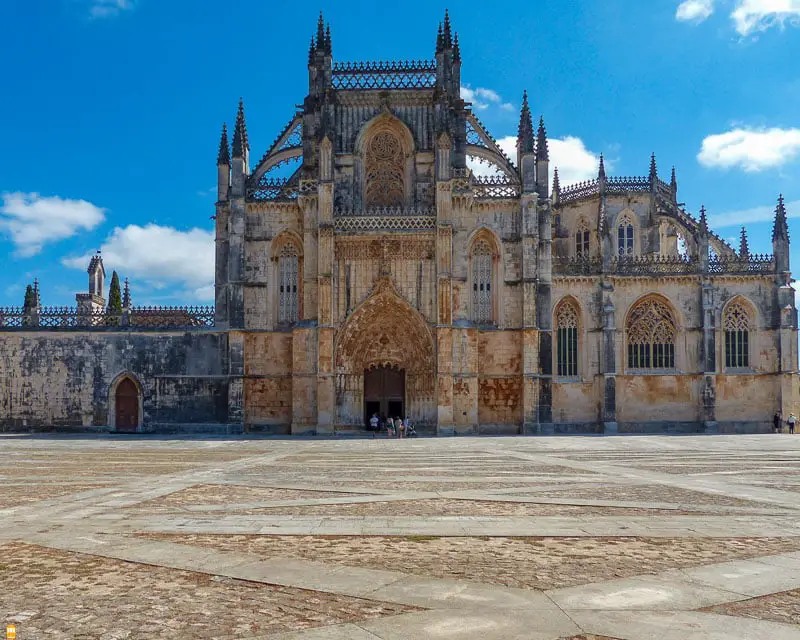
The monastery Mosteiro da Batalha is one of the most beautiful works of Portuguese and European architecture and a World Heritage Site. After the victory against the Kingdom of Castile (region of present-day Spain) in Aljubarrota in 1385, King Dom João I decided to build this monastery to thank the Virgin Mary for having won the battle.
Construction began in 1386 and was completed more than a century later, in 1517. The monastery was donated to the order of the Dominicans who remained there until 1834, the year the religious orders were disbanded in Portugal.
Since then, this magnificent monument belongs to the Portuguese state, which decided to open it to the public.
22. Castelo de Leiria
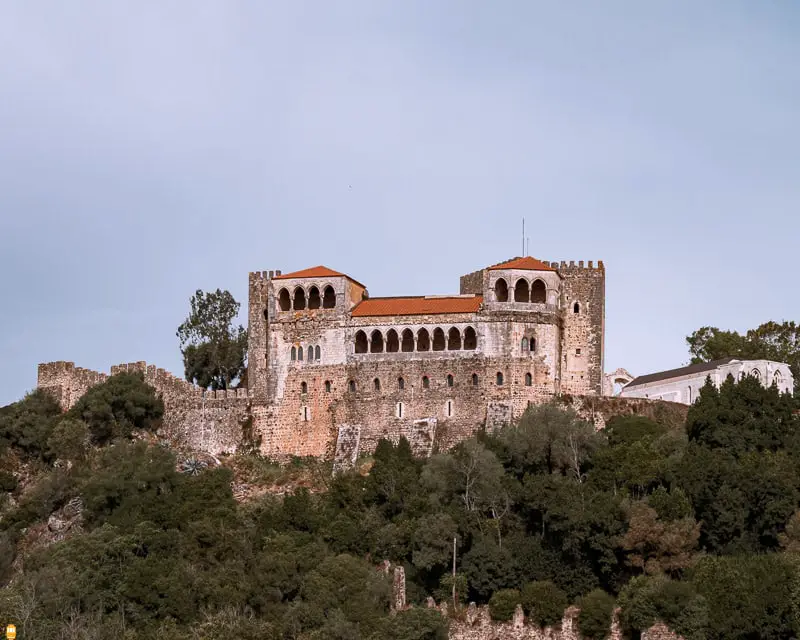
Built in the 12th century to protect the land recovered from the Moors, the Leiria castle is without a doubt one of the most beautiful medieval castles in Portugal!
After numerous attacks over the centuries, the last of which was carried out in the 19th century by Napoleon’s troops, the castle fell into ruins and was abandoned for more than 100 years.
From 1915 onwards, the ruins were rebuilt and today you can visit the keep, the church Igreja de Santa Maria da Pena, the Royal Palace and walk along the ramparts that offer a 360º view of the city.
After visiting the castle, you can also take the opportunity to lose yourself in the streets of the historic centre of Leiria and discover its beautiful monuments, such as the cathedral.
23. Mosteiro de Alcobaça

After the capture of the city of Santarém from the Moors, King Dom Afonso Henriques promised the Order of Cistercians to build the monastery Mosteiro de Alcobaça to thank them for their support.
The construction of the monastery began in 1178, following the model of the Abbey of Clairvaux, the mother house of the Order of Cistercians in France, and was completed in 1252, the year of its inauguration by King Dom Dinis.
In 1810, Napoleon’s troops stole much of the monastery’s wealth and what was left was stolen in 1834, when religious orders in Portugal were disbanded.
Discover, during your visit, the dormitory, the chapter house, the refectory, the Dom Dinis cloister, the incredible kitchen, the Hall of Kings and the church (free part).
24. Nazaré
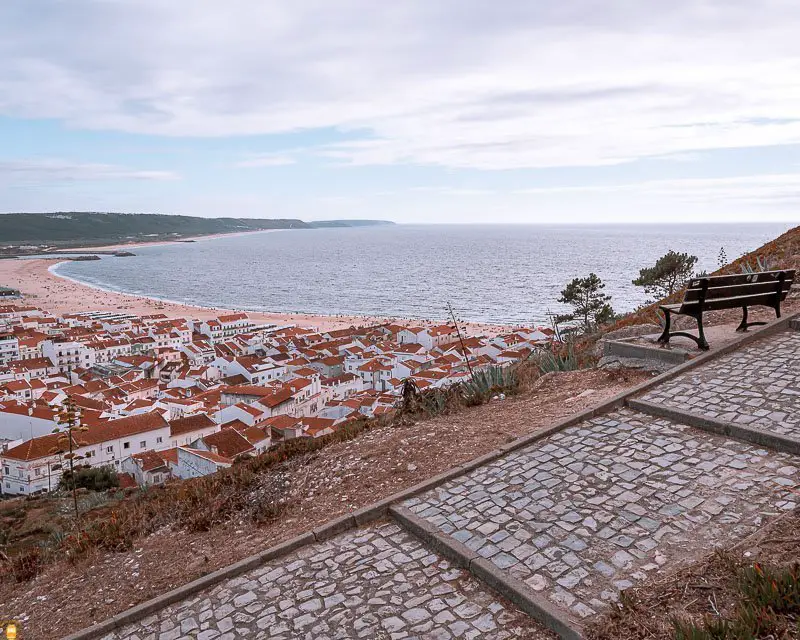
The beautiful Nazaré is a city unlike any other in Central Portugal! From traditions that have endured for many years and which are intrinsically linked to fishing, to the giant waves that have made this city such a great tourist spot, there are many reasons why you should visit this place.
Although considered a municipality since the 16th century, it was only in the 20th century that the current name was first used. Until then, the municipality was called Pederneira, currently a neighbourhood in Nazaré. There, traces of the medieval period can still be found.
In fact, Nazaré is divided into three distinct areas: the lower part, by the sea, Pederneira, the inner part of the city, and the Sítio, located on the Nazaré promontory.
Although Nazaré owes a lot to fishing, this city developed mainly from the 20th century onwards and especially in the 21st century, thanks to tourism and its beautiful and pleasant beaches. In addition, the city became world famous after Garrett McNamara broke the world record for the biggest wave ever surfed in 2011. This record was broken by 61 centimetres in 2017 by Brazilian Rodrigo Koxa, setting the record at 24.38 m.
To discover this city and its surroundings, I invite you to read the article Top 20 of the places to visit in Nazaré and its surroundings.
25. Peniche
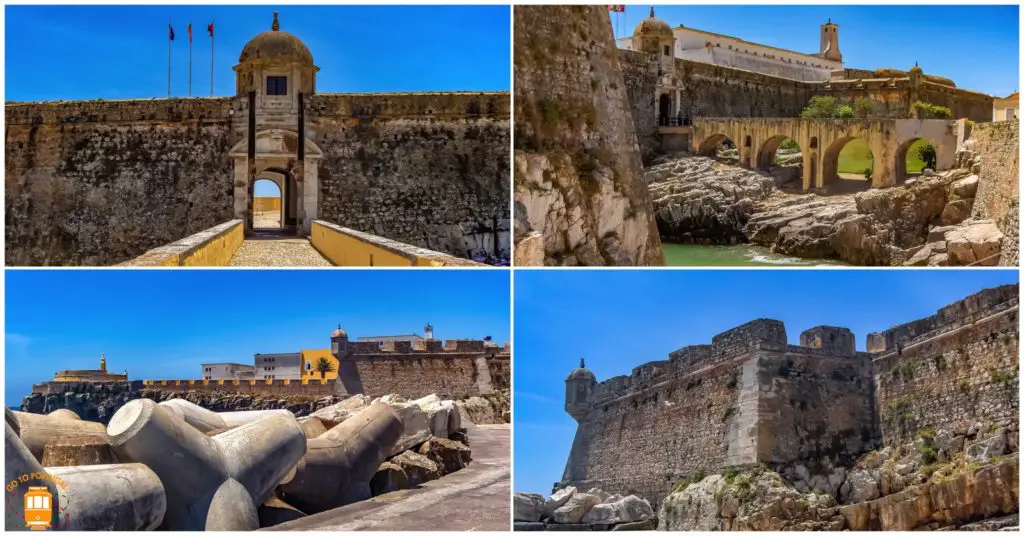
Considered the westernmost city on the European continent, Peniche is one of the places to visit during your stay in Portugal.
This town is located on a peninsula with a small piece of land that connects it to the continent, making it unique in Portugal.
Although it was recently elevated to the category of city (in 1988), Peniche has always been of particular importance in the country, especially at the maritime and fishing areas. The port of Peniche remains one of the most important Portuguese fishing ports.
One of the places that you should not miss during your visit is the city fortress, which dates back to the 16th century. Located on top of cliffs, this fortress was considered by King Dom João IV as the “main key to the kingdom by the sea” due to its location, one of the westernmost points in Portugal.
The Peniche Fortress was the main fortification of the defensive complex called Praça-Forte de Peniche, which was listed as a Portuguese monument in 1938 due to its historical importance.
Apart from the defensive functions it performed until the end of the 19th century, this fortress fulfilled several functions, some of which are more worthy than others.
The fortress served as a political prison during the dictatorship of the Estado Novo (a dictatorship that only ended in 1974, after the Carnation Revolution). It temporarily hosted Portuguese families who came from the former African colonies. Since 1984, it houses the City Museum of Peniche.
To discover all the places to visit in Peniche, read the article What to visit in Peniche – from the paradise of Berlengas to the fantastic beaches.
26. Arquipélago das Berlengas
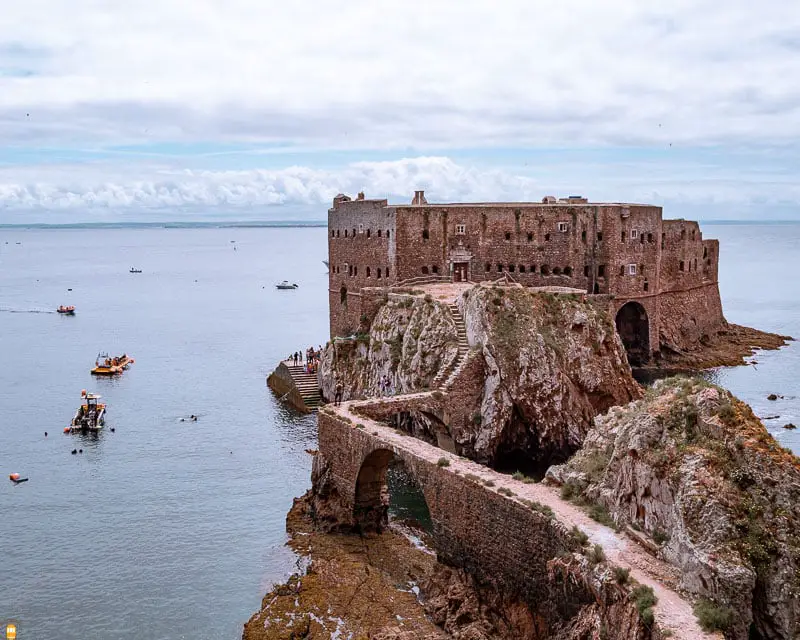
Listed in 2011 as a World Biosphere Reserve by UNESCO, the Berlengas Natural Reserve was the first protected area in Portugal, decreed by King Dom Afonso V, who banned hunting on the largest island of this archipelago, Berlenga Grande (1.5 km long and 800 m wide).
The human occupation of this island began several centuries ago with the passage of Viking and Muslim navigators, as well as French and English privateers.
In the beginning of the 16th century, Queen D. Leonor asked some monks of the Order of São Jerónimo to settle on this island in order to facilitate navigation and help the victims of the frequent shipwrecks that occurred there.
Despite the good intentions, the truth is that the monks did not stay long due to the constant attacks by the privateers and the unfavourable conditions of the island.
During your visit, you can enjoy the beautiful beach for a few hours, stroll through the Bairro dos Pescadores (Fishermen’s Quarter), admire the lighthouse of Duque de Bragança and enter the most photogenic place in Berlenga Grande, the fort Forte de São João Batista das Berlengas.
In the article about the city of Peniche, you will find all the information about this archipelago, as well as the necessary information to get there.
27. Óbidos

The beautiful village of Óbidos is very touristy, but definitely worth visiting. It was conquered from the Moors by the first king of Portugal, Dom Afonso Henriques.
One of the most interesting places in Óbidos is without a doubt the ramparts and the castle that protect the citadel.
While there, take the opportunity to explore the citadel, admire the castle, walk along the ramparts, the alleys with their beautiful houses and travel back in time imagining being a resident of this town during the Middle Ages, a unique experience!
Do not leave Óbidos without trying the famous ginjinha de Óbidos, a very popular liquor in this region and throughout the country.
Outside the citadel, admire the beautiful Usseira Aqueduct, which was originally 3 km long, and also the sanctuary Santuário do Senhor da Pedra.
28. Santarém

With several centuries of history, Santarém is a city that was occupied by several peoples. The city was populated by Phoenicians, Greeks, Carthaginians and Moors until 1147, when the city was finally conquered by the Portuguese, led by their first king, Dom Afonso Henriques.
Once known as the Gothic capital of Portugal, in the historic centre of Santarém, you will find several architectural styles that make this city a place not to be missed.
Currently, Santarém is not as important as it was a few centuries ago, but its heritage is immense and, in that sense, I invite you to discover this city during your visit to Portugal.
To discover the wonders of this beautiful city, read the article What to visit in Santarém, capital of the Gothic in Portugal.
29. Mafra
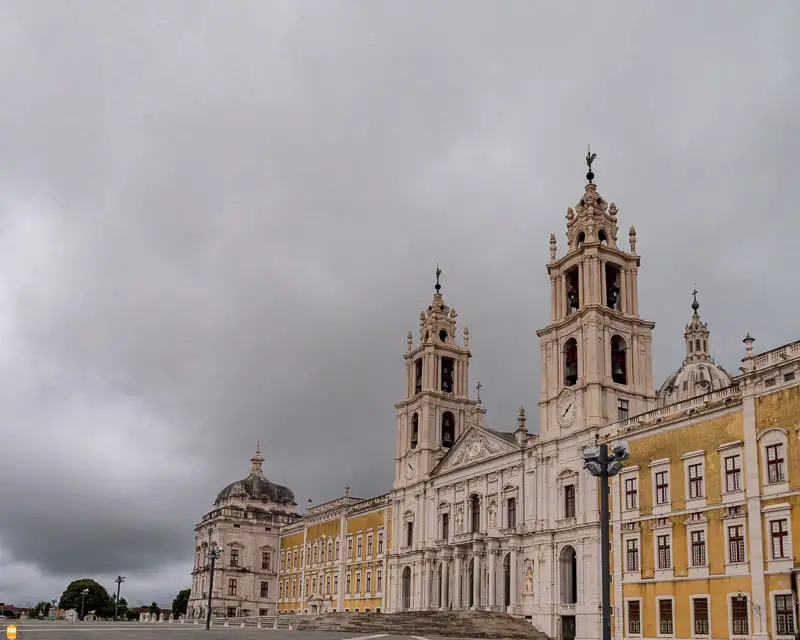
Located just 39 km from Lisbon, the municipality of Mafra has many treasures that are worth visiting during your stay in Portugal.
The most notorious is the National Palace of Mafra, listed in 2019 as a World Heritage Site by UNESCO (palace, basilica, convent, garden of Cerco and the hunting park, better known as Tapada Nacional de Mafra).
The palace is an old royal residence built during the reign of King Dom João V, in 1717, following a promise made by the king. The building occupies an area of approximately 4 hectares, with 1200 rooms, 4700 doors and windows.
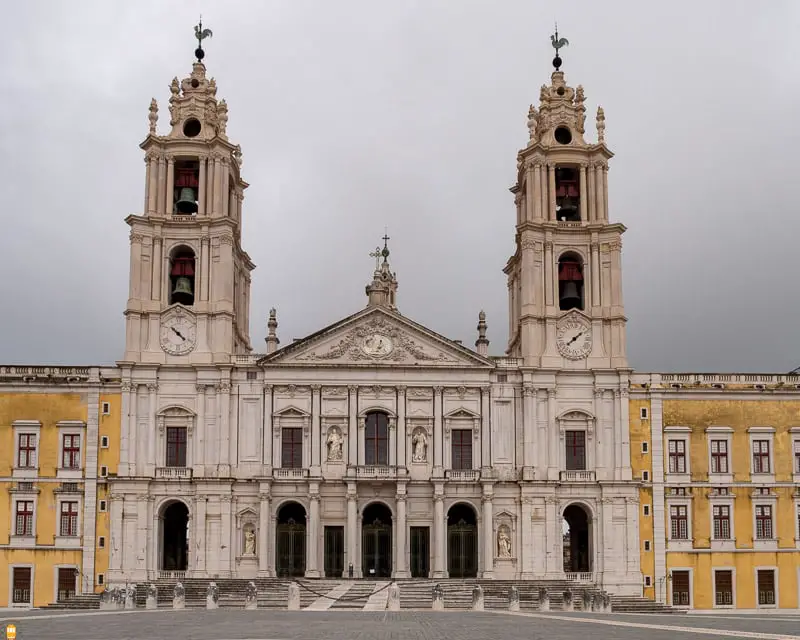
During your visit, discover, in addition to the palace, the basilica, the convent, one of the most beautiful libraries in Europe and the garden of Cerco, located at the back of this wonder.
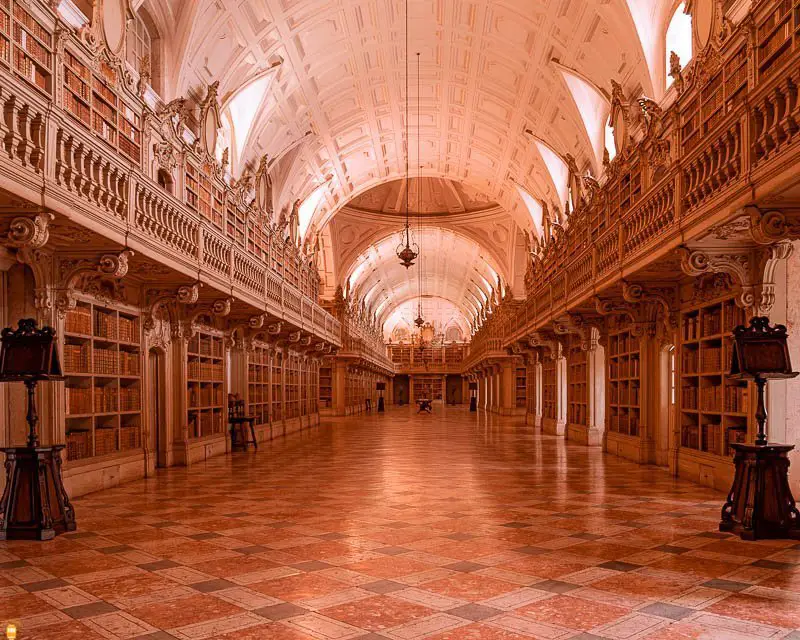
Another place to be discovered in the municipality of Mafra is Tapada Nacional (entrance located 7 km from the centre of the town), an 833-hectare forest protected by a 21 km wall, created in 1747 by King Dom João V after the construction of the convent and palace. The forest was used as a leisure and hunting park by Portuguese monarchs.
When you visit Tapada Nacional de Mafra (paying entry), you’ll have the opportunity to admire the flora but also wild animals like deers, boars, eagles and much more.
30. Ericeira
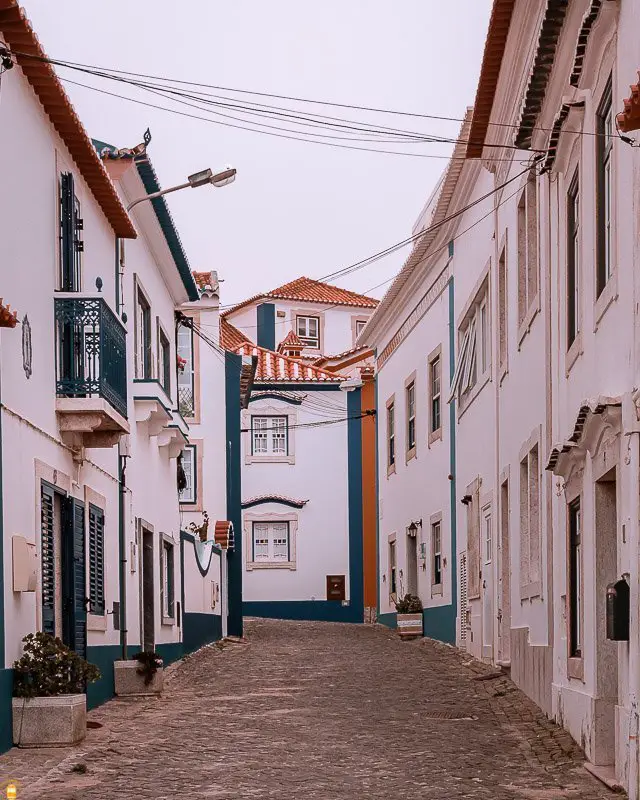
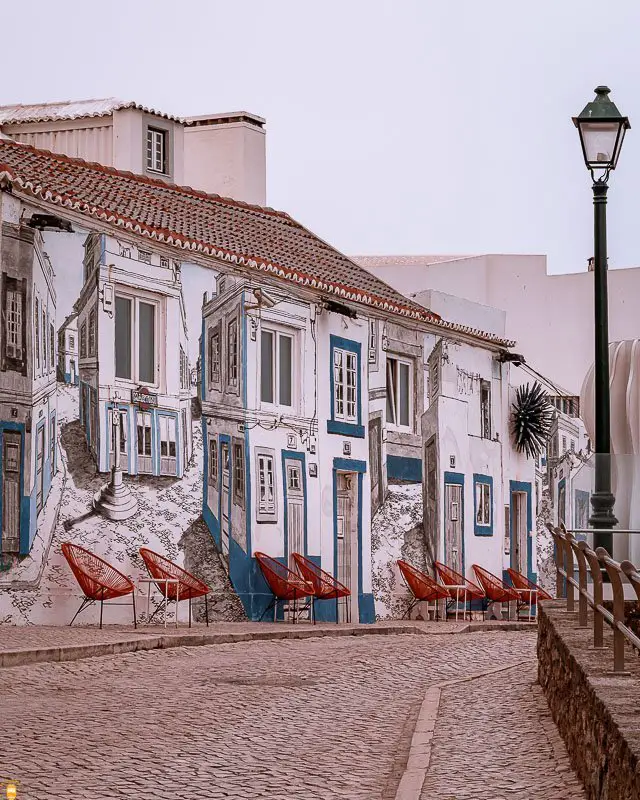
Located 8 km from Mafra, the small town of Ericeira is basically a fishing village that has grown over the years thanks to its quality of life and its magnificent beaches, very popular amongst surfers.
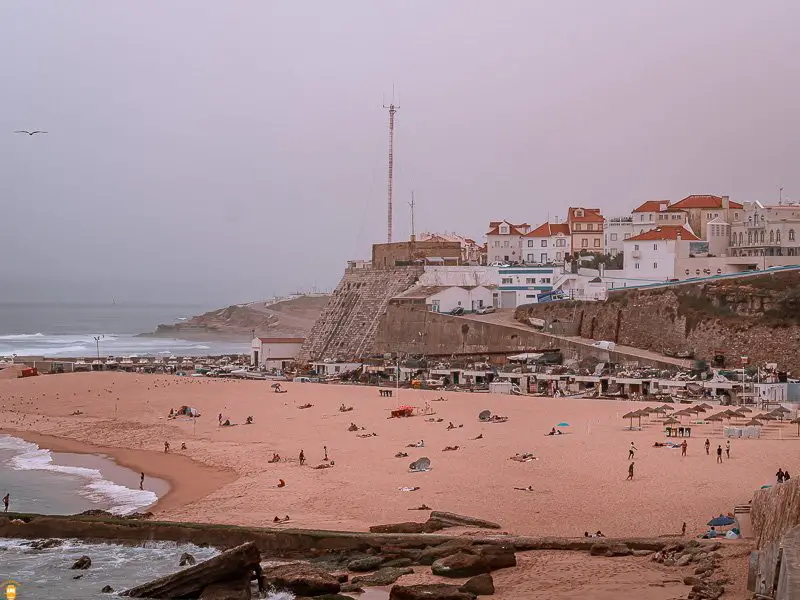
Aside from discovering the beautiful beaches, lose yourself in the alleys of the historic centre to experience the authenticity of the town and its inhabitants
Historical fact: it was from here that the last Portuguese king, Dom Manuel II, fled on October 5, 1910 to Gibraltar on board the royal ship Amélia, after the proclamation of the first Portuguese Republic.
31. Azenhas do Mar
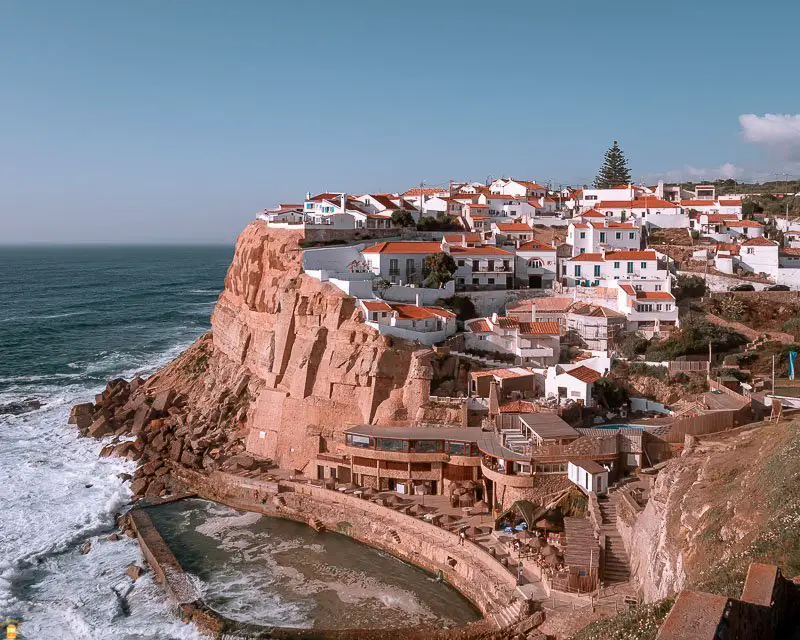
Located 14 km from the historic centre of Sintra, the picturesque village of Azenhas do Mar is one of the most photogenic places in Portugal!
There, you can enjoy the natural pools and viewpoints that offer stunning views of the village and the Atlantic Ocean.
Do not hesitate to eat at the restaurant just above the pool to enjoy a good Portuguese dish while enjoying an incredible view.
32. Sintra

Visiting Sintra is like entering a romantic kingdom, where majestic palaces, a fairy tale castle and fascinating mansions emerge between hills and lush forests.
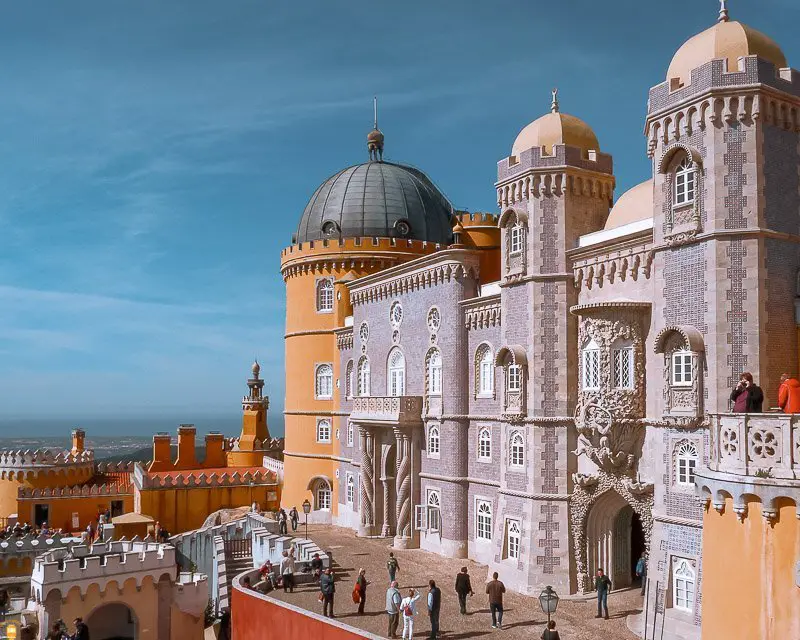
Even though this town is very touristy, I recommend you explore it, as this place is full of wonders not to be missed, such as the Pena National Palace, Quinta da Regaleira and the Monserrate Park and Palace. It’s not by chance that the cultural landscape of this town has been listed as a World Heritage Site by UNESCO.
For more information about this town, I invite you to read the article Top 10 of the places to visit in Sintra.
33. Lisbon
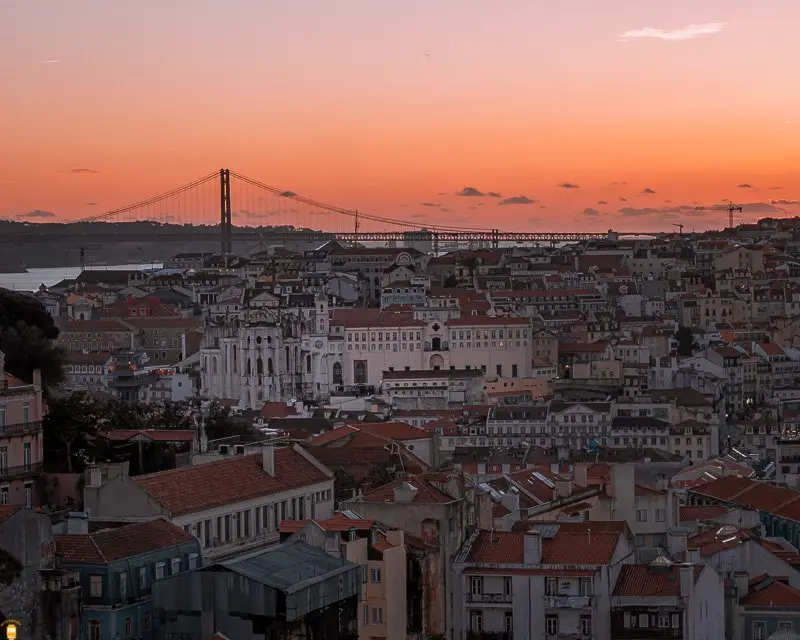
Capital and biggest city in Portugal, Lisbon appears at the top of the list amongst the most popular tourist destinations in Europe.
The city of the seven hills has won the hearts of visitors from all over the world, thanks to a sumptuous blend of tradition and modernity. Ideally located, you can visit Lisbon and discover its many faces during a weekend.
Here are the places you should not miss during your visit to Lisbon:
- Alfama quarter
- Bairro Alto
- Bica Elevator
- Mouraria quarter
- Viewpoint of Senhora do Monte
- Praça do Comércio square
- Jerónimos Monastery
To discover all the wonders and have all the necessary information for an unforgettable stay, I invite you to read the articles Top 20 of the places to visit in Lisbon and Weekend in Lisbon: discover the places to visit in 2 days.
34. Cristo Rei
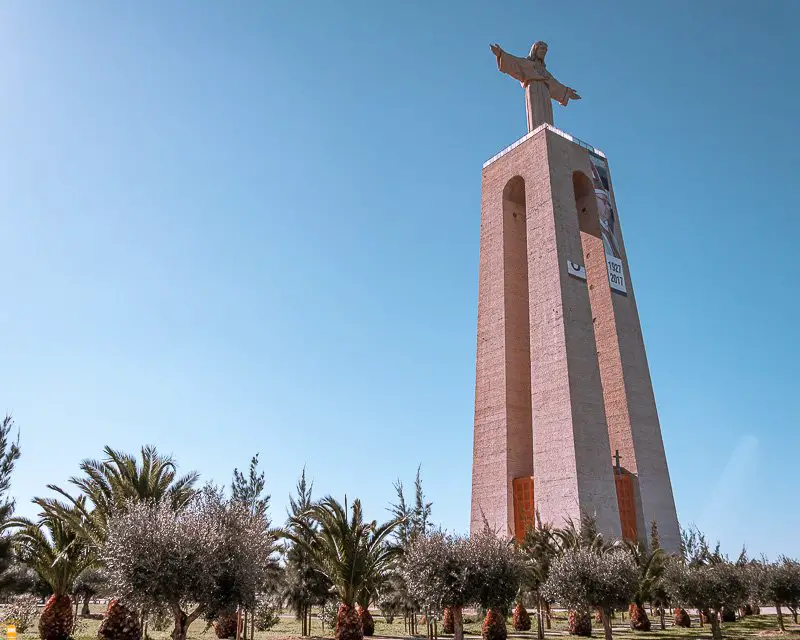

Located in the municipality of Almada, on the south bank of the Tagus river and facing Lisbon, Cristo Rei is a sanctuary and religious monument that represents the Sacred Heart of Jesus. Inspired by Christ the Redeemer, in Rio de Janeiro, this 110 metre high building was inaugurated in 1959.
This sanctuary and the statue, in particular, welcome those who wish to visit Lisbon and its region with open arms. Here, you can enjoy one of the most beautiful views of the beautiful Portuguese capital.
35. Costa da Caparica

The city of Costa da Caparica is a place you can’t miss when visiting the surroundings of the Portuguese capital.
Known in Portugal for its beautiful beaches, the city hides a natural treasure that completely fascinated me, the Protected Landscape of the Fossil Cliff of Costa da Caparica (Paisagem Protegida da Arriba Fóssil da Costa da Caparica).
If, like me, you enjoy big sandy beaches, walk in the midst of stunning landscapes, admire the fishermen working and discover their authentic villages, Costa da Caparica will surprise you!
To discover its wonders, read the article Costa da Caparica, Lisbon’s paradise.
36. Parque Natural da Arrábida

The Arrábida Natural Park is undoubtedly one of the most beautiful places in Portugal. It’s not by chance that I consider it a Portuguese paradise!
When visiting this park, you will discover paradisiacal beaches (you don’t need to go to the Caribbean), viewpoints that offer breathtaking views and ancient castles with many stories to tell.
To discover its wonders, read the article Serra da Arrábida, the Portuguese paradise!
37. Cais Palafítico da Carrasqueira

Carrasqueira’s Palafitic Pier, located very close to Comporta, a fishing village very popular amongst the international jet set, is a very photogenic place used since the 50s and 60s of the 20th century by fishermen to reach their boats without being conditioned by the tides.
38. Praia da Galé – Fontainhas – Melides

Located 10 km from the town of Melides, Galé beach is one of the most beautiful in Portugal! With several kilometres of extension, this beach has incredibly beautiful cliffs!
The main access is through the campsite Parque de Campismo da Galé, but if you pay attention, you will find another access next to the houses. So that you can discover this wonder, I put here the exact location of the path to be used.
Once there, take the stairs on the left side of the house and walk along the campsite wall. You will find stairs that will take you to the beach. Don’t forget to turn around to admire the magnificent cliffs.
39. Praia da Samoqueira
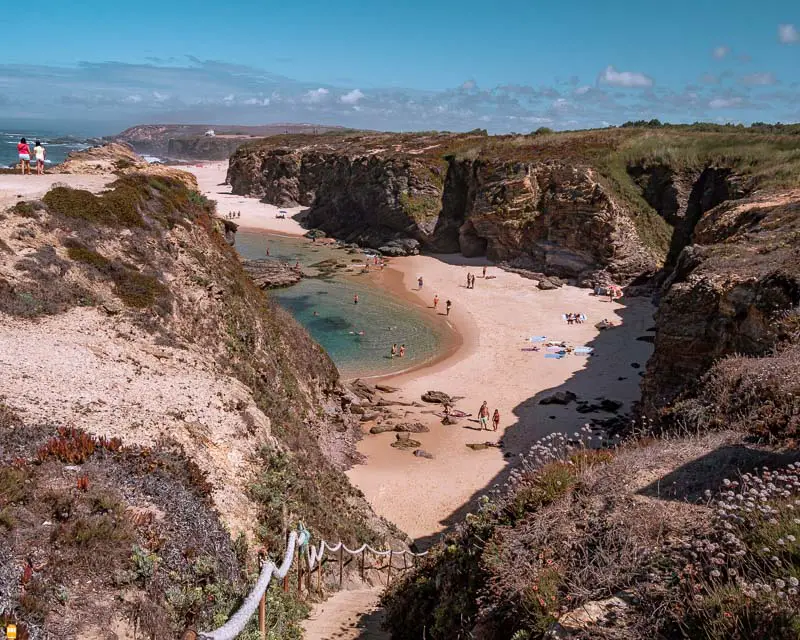
Samoqueira beach is composed of a small mantle of sand covered with stones, which creates almost intimate environments. It is located in the Southwest Alentejo and Vicentine Coast Natural Park, less than 3 km from the parish of Porto Covo.
To admire the same landscape in the photo above, leave your car in the beach parking lot and walk 500 metres towards Porto Covo.
40. Rota Vicentina
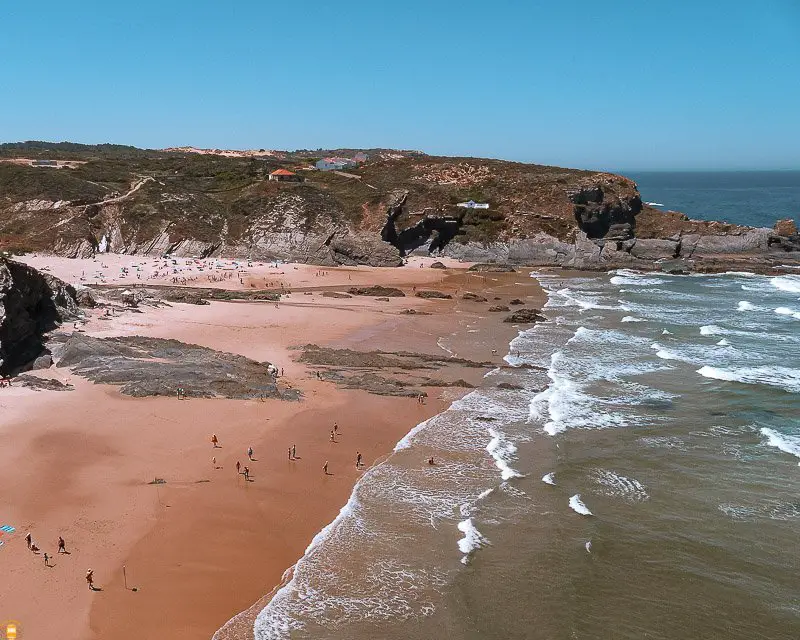
The Rota Vicentina is a 400 km network of walking trails that can be covered on foot.
This network of walking routes is part of the Southwest Alentejo and Vicentine Coast Natural Park and is divided into 3 parts: the Historical Way, the Fishermen’s Trail and the Circular Routes.
The Historical Way begins in Santiago do Cacém and stretches all the way to the cape Cabo de São Vicente, in Algarve (230 km), through mainly rural paths, passing through towns and villages with several centuries of history.
Unlike the Historical Way, the Fishermen’s Trail is a 120 km route that follows the cliffs, the sea and the sandy paths that locals use to access beaches and fishing locations.
The Circular Routes (departure and arrival at the same location) are ideal for those who want to discover the wonders of the Rota Vicentina without travelling many kilometres.
Information: the best time to hike in the Rota Vicentina is from September to June. The months of July and August are very hot (temperatures above 30 °C). In these 2 months of intense heat, I suggest you choose a circular route and hike early in the morning.
To have all the necessary information to prepare for your next hike in the Southwest Alentejo and Vicentine Coast Natural Park, visit the Rota Vicentina website.
41. Praia de Monte Clérigo
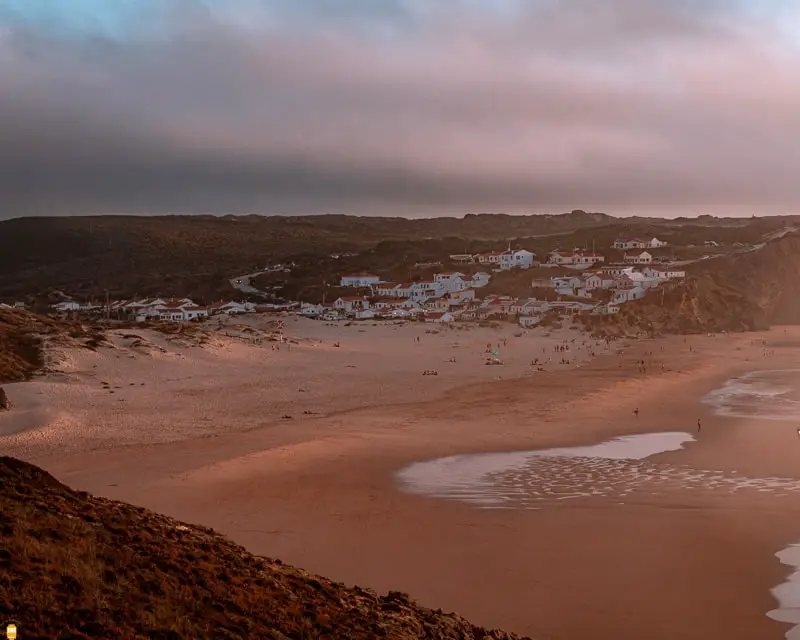
Monte Clérigo beach is one of my favourite places across the country! Located 8 km from Aljezur, it offers magnificent landscapes. Before heading to the beach, stop at the top of the hill to enjoy the view and take beautiful pictures.
Do not hesitate to take the road on your right for 800 metres to the bar / restaurant Taberna do Gabriel II to enjoy the view of Amoreira beach. Even though you can drive there, I recommend that you go on foot to enjoy this magnificent place.
42. Praia da Bordeira
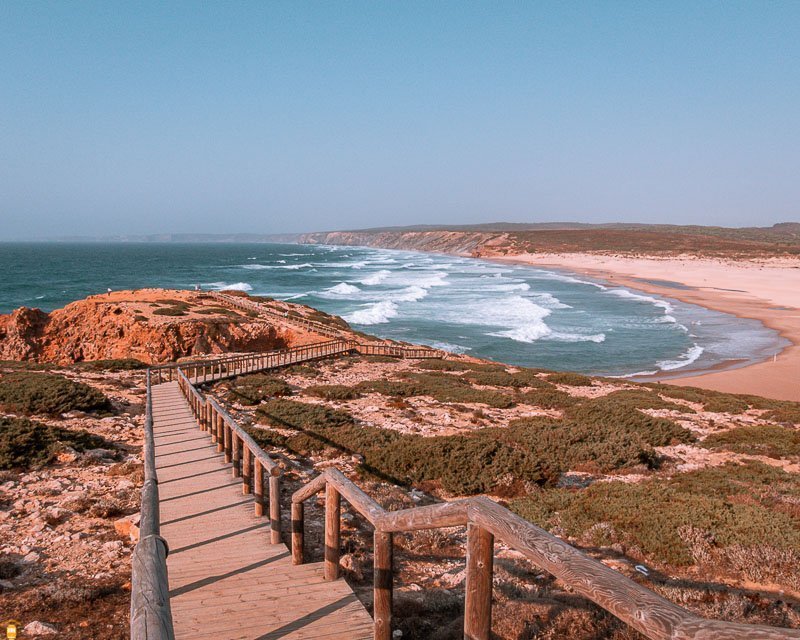
Never crowded, Bordeira beach invites you to spend relaxing holidays away from touristy places. Three kilometres long and located in the Southwest Alentejo and Vicentine Coast Natural Park, the beach is very popular amongst nature lovers and families.
The best access to the beach is located south of the beach. Next to the parking lot you will find a wooden walkway that will allow you to cross a small creek by the beach without any problem.
43. Lagos
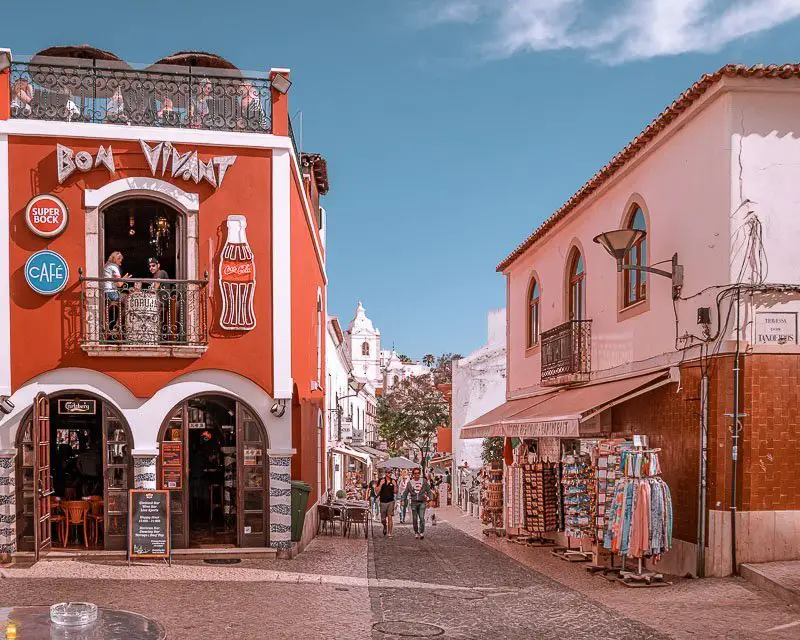
Lagos is a city with a great historical richness, which has kept its authenticity and which has natural wonders considered to be amongst the most beautiful in the world!
As in other places in southern Portugal, the first peoples settled here more than 2000 years ago and there have been many influences since then. The most important peoples to occupy this region were the Carthaginians, the Romans and the Moors until it finally became a Portuguese city in the 13th century.
Since then, due to its great economy and privileged location, Lagos has undergone an enormous development and was considered the “capital of Algarve” for two centuries.
In fact, Lagos played an important role during the Portuguese Discoveries, as it was from this city that many boats left in search of new worlds and in which navigators such as Gil Eanes became famous.
The city went through a period of great changes until 1755, when Lagos was devastated by an earthquake. It was at this moment that it lost the status of “capital of Algarve” to Faro.
In addition to the historic side, Lagos will surprise you with its magnificent beaches considered as some of the most beautiful in the world!
To discover its historic centre and magnificent beaches, read the article What to visit in Lagos, one of the most beautiful cities in Algarve!
44. Ferragudo
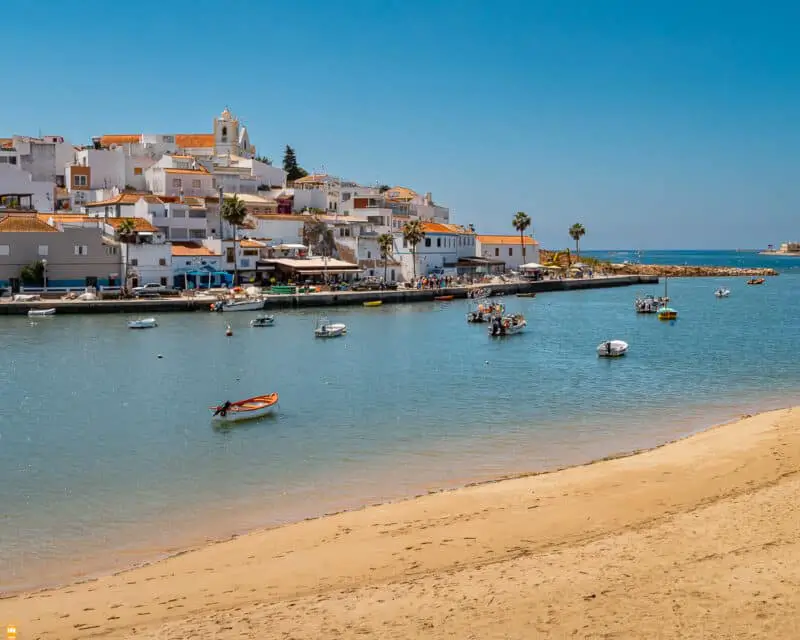
This small town has a charm like few in Algarve. Stroll along the river and enjoy the beautiful beaches where you can admire the small, but beautiful Castle of São João de Arade, built in the 15th century.
Apart from the castle and the beautiful beaches, enjoy your visit to Ferragudo and lose yourself in the beautiful typical streets that will surely amaze you!
To get to know this small town better, read the article What to visit in Portimão, one of the wonders of Algarve!
45. Percurso dos 7 Vales Suspensos
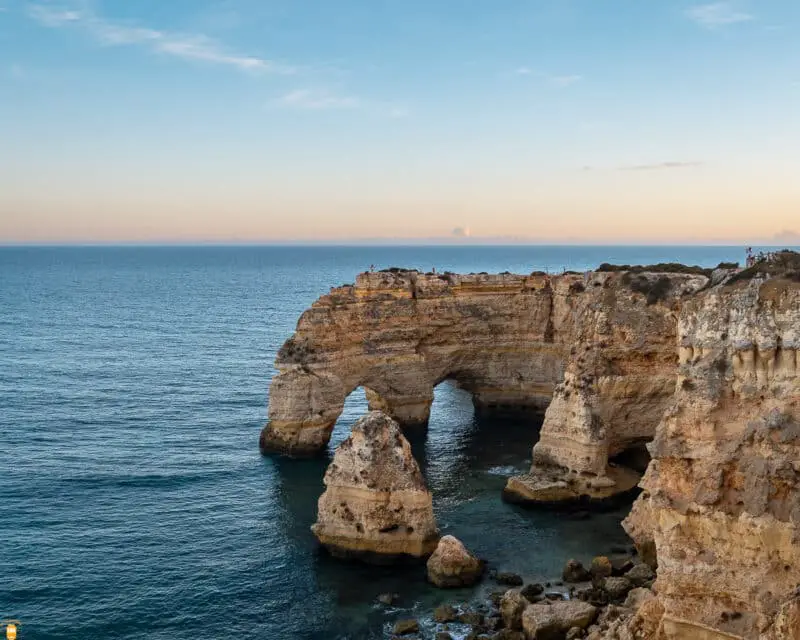
If, like me, you enjoy beautiful landscapes, you can’t leave Algarve without taking the 7 Hanging Valleys Route.
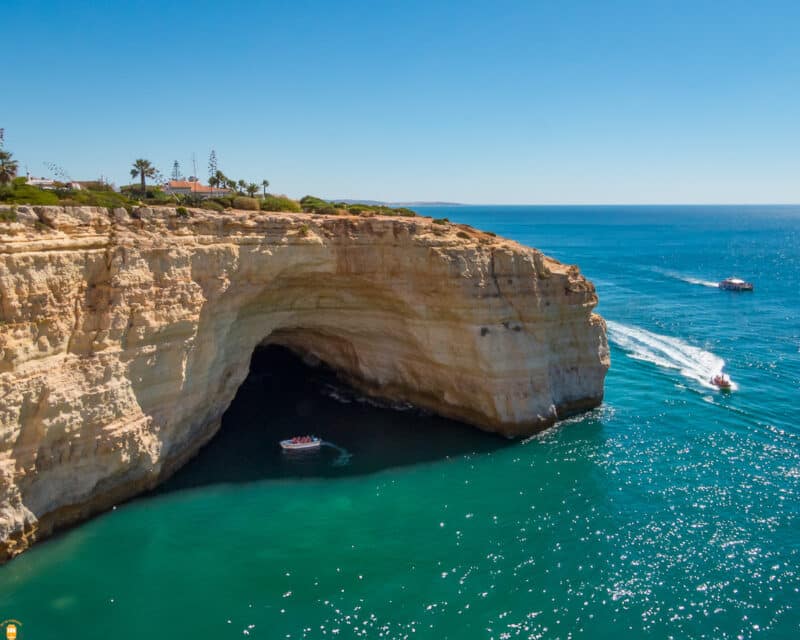
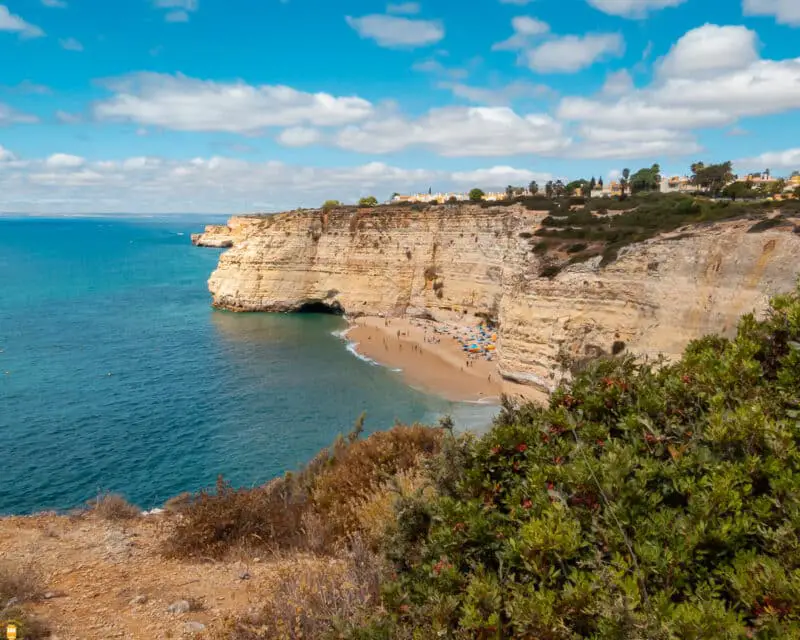
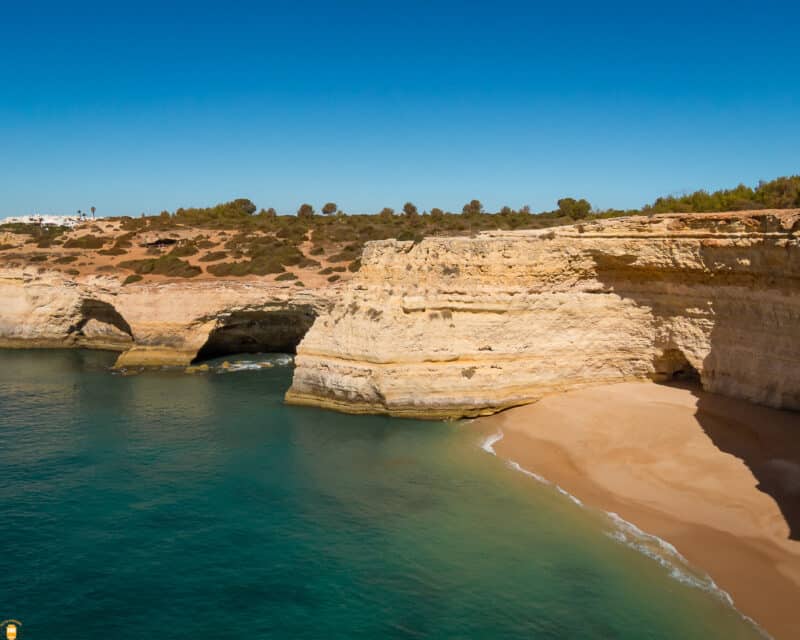
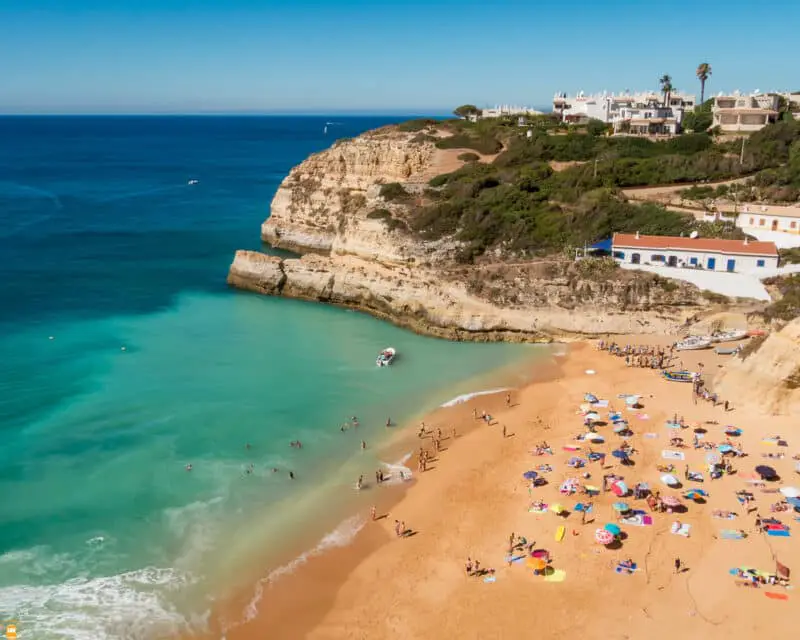
This pedestrian trail follows the cliffs between Marinha beach and Vale Centeanes beach for 5.7 km (11.4 km round trip), which will allow you to admire incredible landscapes and you can even take a break on one of the 3 beaches (Marinha, Vale Centeanes and Benagil).
46. Praia da Marinha

Marinha beach is of great natural beauty, considered one of the most beautiful in Portugal and is also amongst the 100 best beaches in the world. Before heading to the beach to appreciate the beauty of the rocks and natural tunnels, be amazed with the view from the top of the cliff.
47. Praia da Falésia
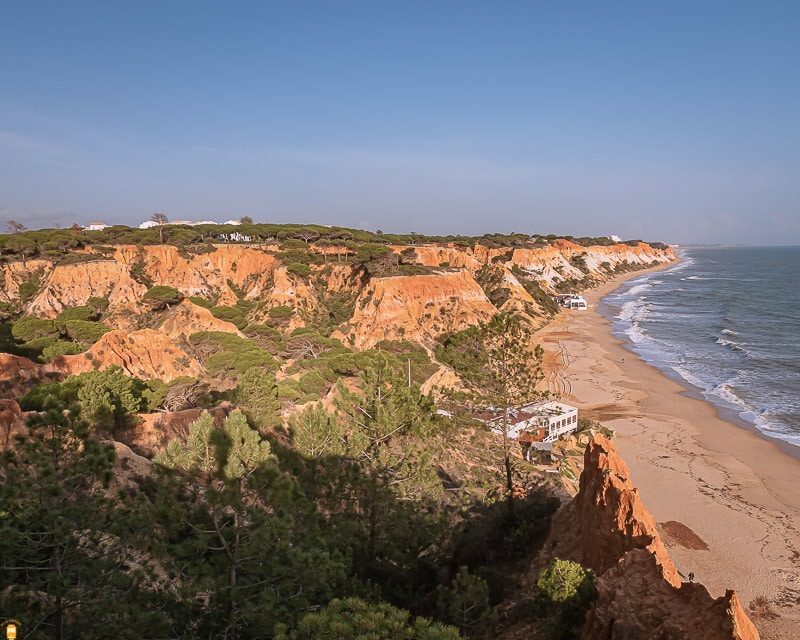
Like Galé beach in Melides, Falésia beach will surprise you with the beauty of its cliffs. It is located in Olhos de Água, in Algarve (between Vilamoura and Albufeira).
To be amazed by this place, go to the Falésia viewpoint at sunset. That’s when the cliffs offer their most beautiful colours!
48. Alte
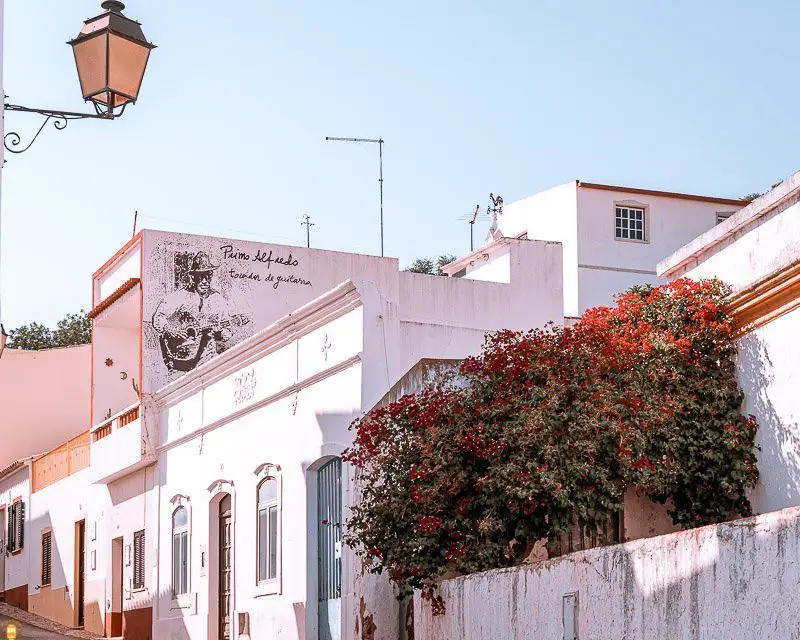
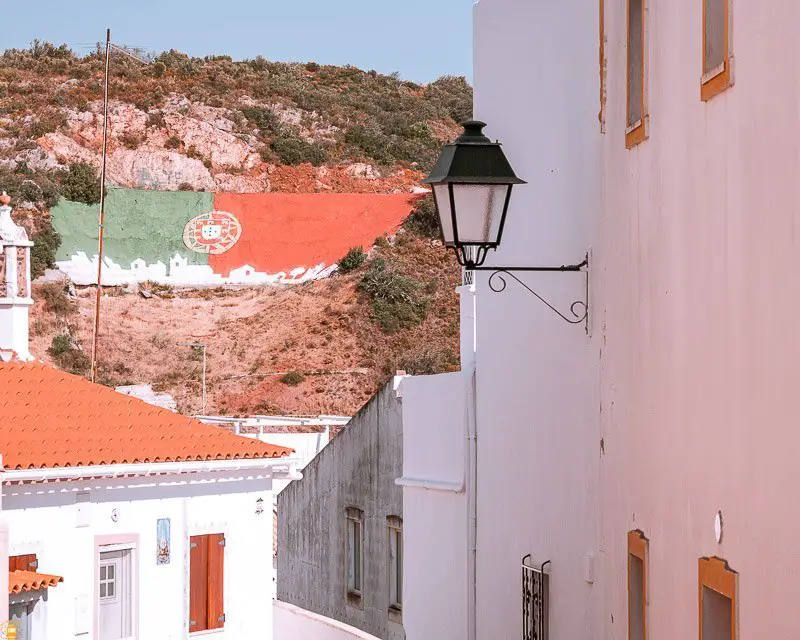
Located literally in the centre of Algarve, the village of Alte is another little-known treasure to discover during your visit to Algarve.
Lose yourself in the narrow streets of this town and admire the whitewashed houses until you reach the beautiful church Igreja de Nossa Senhora da Assunção, built in the 13th century and remodelled over time. Here, you can admire the Manueline style window and its interior with beautiful glazed tile panels.
If you visit this village in the summer, know that 500 metres from the church you can enjoy the refreshing waters of the waterfall Queda do Vigário or, at the other end of the village, the river beach of Fonte Grande.
49. Faro
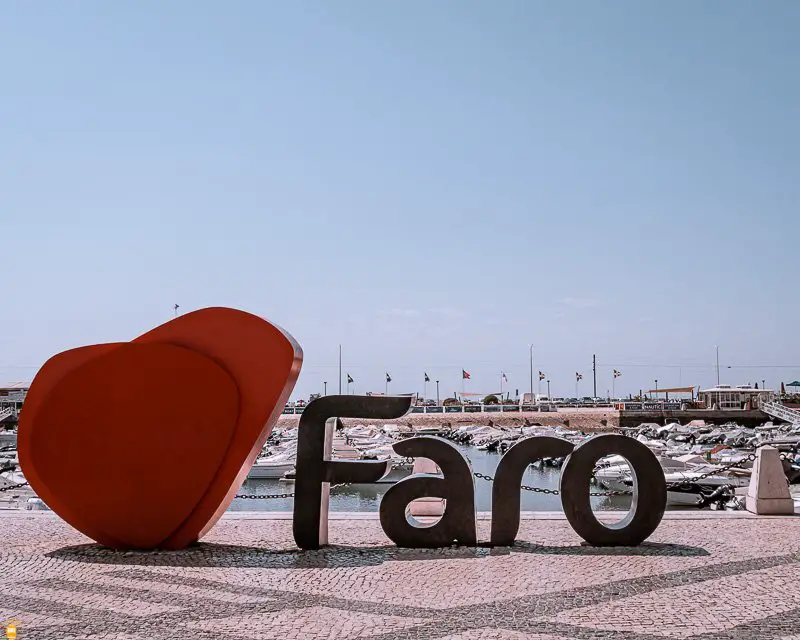
The city of Faro is the gateway for those visiting Algarve by plane, but it is often ignored by visitors who go directly to seaside resorts.
Located just 6 km from the airport, the historic centre of Faro will conquer you with its narrow and timeless streets and its beautiful cathedral from which you will have an incredible view of the Ria Formosa Natural Park.
The picturesque Old Town and medieval walls, the winding pedestrian streets, the attractive marina, the well-kept parks and squares, the museums and the churches are reason enough to visit Faro and discover this unknown city.
For more information about this city, read the article Top 16 of the places to visit in Faro.
50. Parque Natural da Ria Formosa
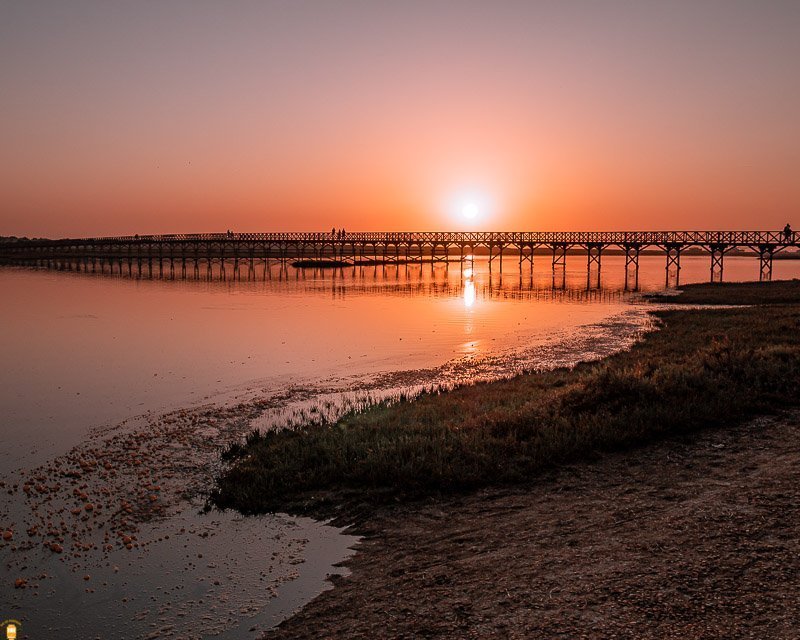
Natural reserve since 1978 and natural park since 1987, Ria Formosa has a significant biodiversity that extends for more than 60 km and more than 18 000 ha in total. This place, formed mainly by islands, swamps and canals, offers a unique show in the world.
For more information on each island and how to get there, read the article Ria Formosa: come and visit the natural paradise of Algarve.
51. Tavira
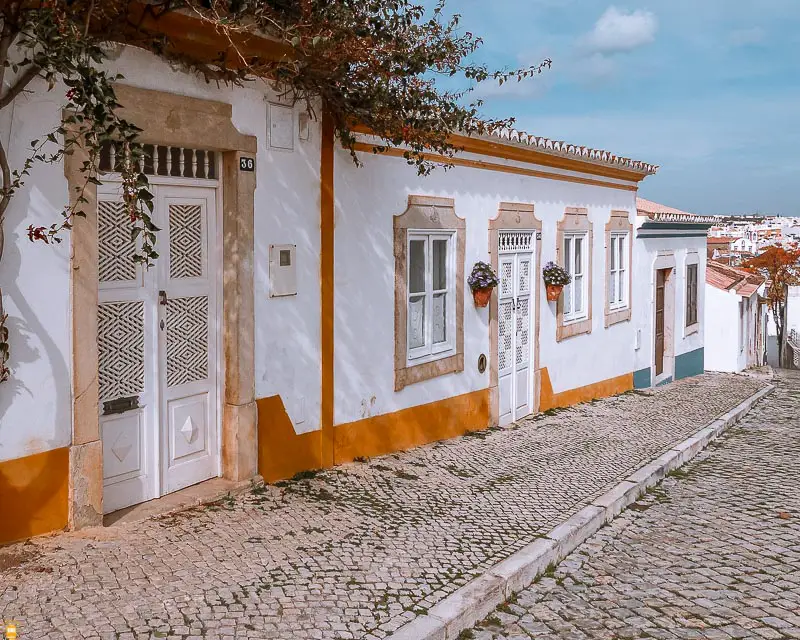
Tavira is without a doubt the most picturesque city in Algarve. Of Roman origin, it was during the Moorish occupation that it gained importance and until the 17th century, when Portugal had to give up its possessions in North Africa.
When visiting Tavira, you will discover a city with 21 churches, an old Moorish quarter, the ruins of a castle with a beautiful view of the city, a bridge of Roman origin and alleys where you will enjoy to lose yourself.
52. Mértola
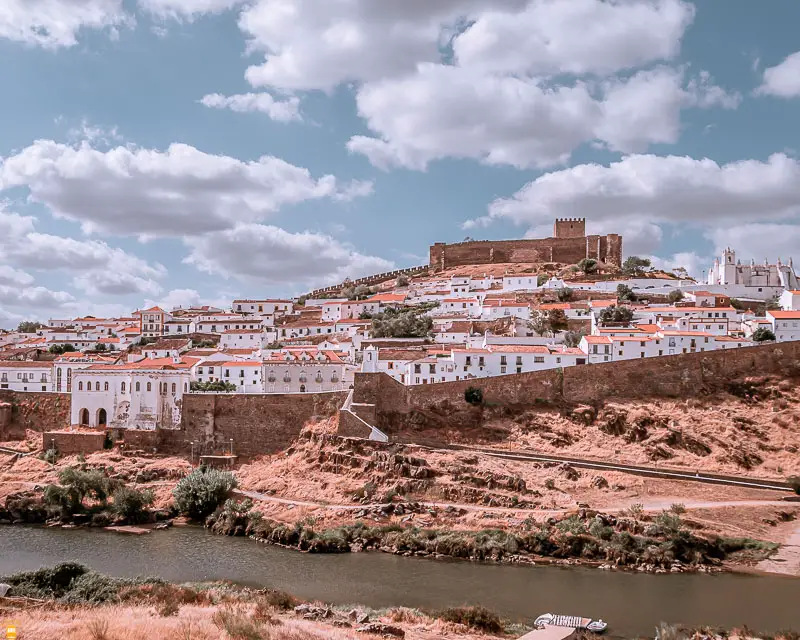
The beautiful town of Mértola is located in the Guadiana valley, in Alentejo, and just 20 km from the Spanish border and Algarve.
Mértola is a town with centuries of history, with traces dating back to the Neolithic period. During your visit, you will be able to see traces of Roman, Visigothic and Muslim times. For several centuries, it was an important river port and was the capital for some years, in the 11th century, of a small independent Islamic emirate, Taifa de Mértola.
Lose yourself in the beautiful alleys of the town to admire the view over the Guadiana river, visit the castle, the church Igreja Matriz de Mértola built in an old mosque and the town museum.
On the outskirts of Mértola, discover one of the most relevant waterfalls in southern Portugal, Pulo do Lobo, as well as the São Domingos mine, used until 1965 for copper extraction. There, you can go for a hike on the 14 km circular route of Rota do Mineiro to admire this place.
53. Castelo de Beja

Improved over the centuries, the Castle of Beja owes its origin to the Roman occupation. During your visit, walk along the ramparts and go to the keep to have a beautiful view of the city of Beja and its surroundings. Take the opportunity to discover the historic centre of Beja (cathedral, Évora gate, pillory), a city founded in 400 BC.
54. Viana do Alentejo
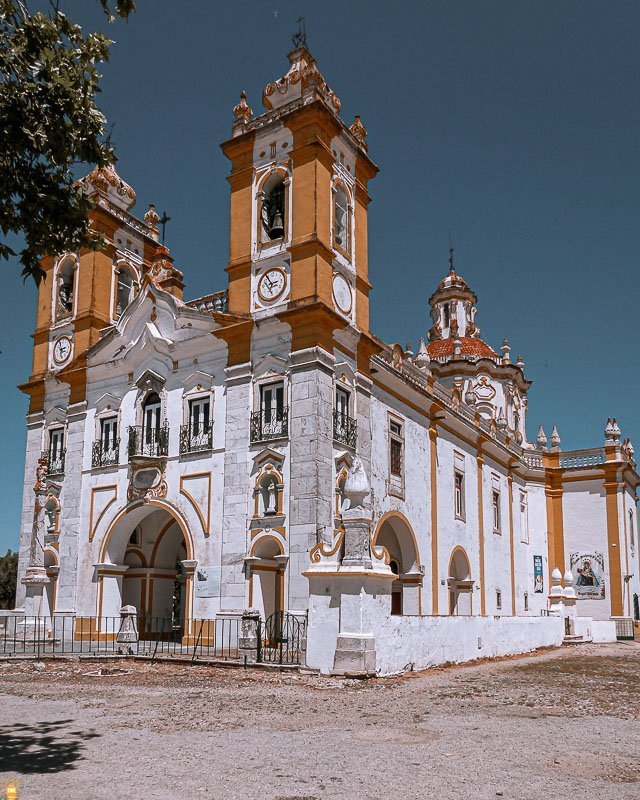
A town since the 14th century, Viana do Alentejo will take you to the deep and authentic Alentejo. You will discover a colourful town with white houses with yellow edges, a pentagonal castle with five cylindrical towers, several churches (the most beautiful is inside the castle), incredibly beautiful fountains and a sanctuary like few in Portugal (Santuário de Nossa Senhora d’Aires).
55. Cromeleque dos Almendres
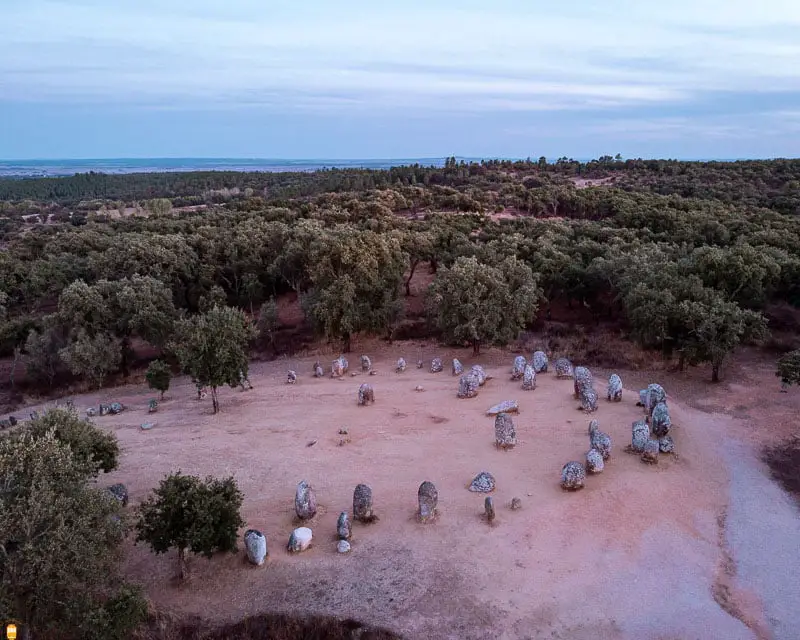
Located 17 km from the historic centre of Évora, the Cromeleque de Almendres is the most important megalithic complex in the entire Iberian Peninsula and one of the most important in Europe. Its construction took place between 6000 and 3000 BC.
56. Évora
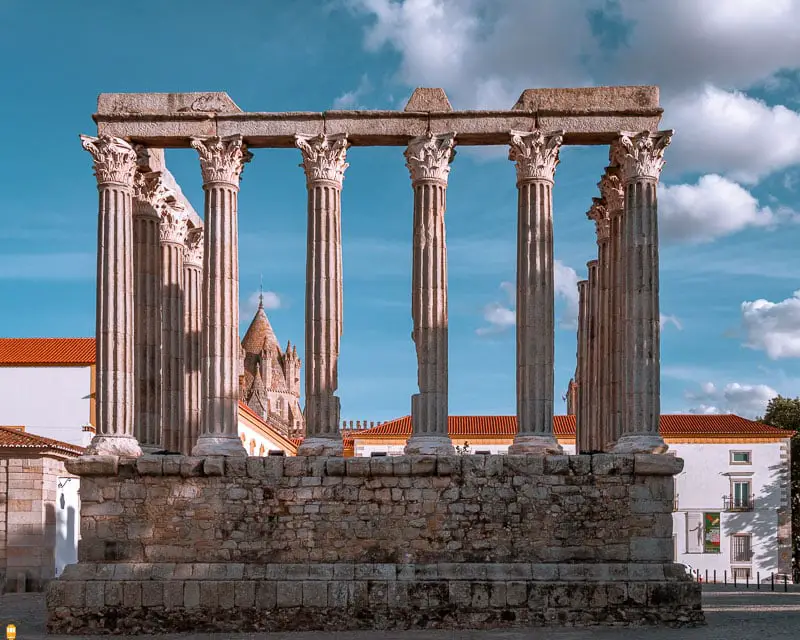
Listed as a World Heritage Site by UNESCO since 1986, Évora is also considered a “museum city” because of its monuments, some of which dating back to Roman times.
Évora lived several lives: Roman until the 5th century, belonged to the Visigoths until the 8th century, to the Moors for four centuries and, finally, to the Portuguese since 1165.
Click here to discover my visit to the sublime city of Évora and discover the places not to be missed.
57. Monsaraz
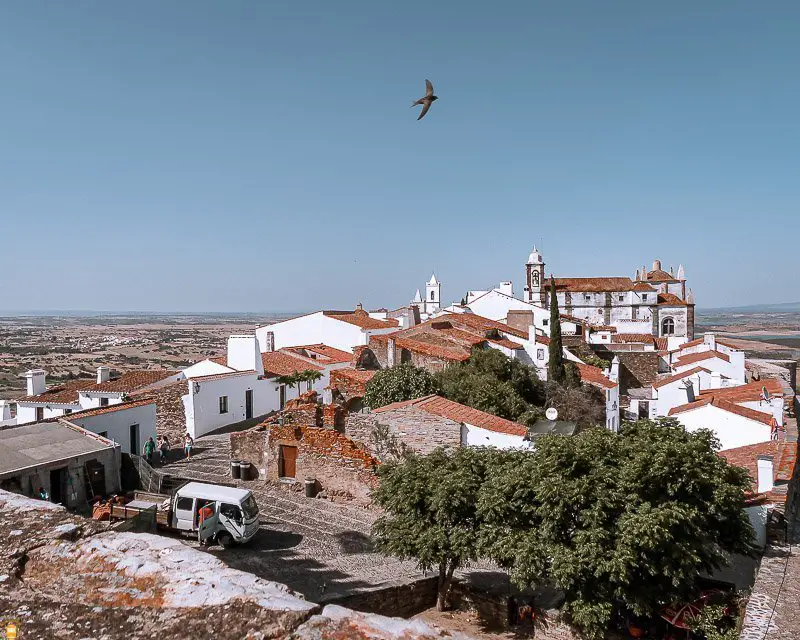
Located on the top of a hill, Monsaraz is one of the most beautiful towns in Portugal. Apart from admiring the splendid view over the valley and Lake Alqueva, one of the largest artificial lakes in Europe, you can also stroll through the picturesque streets lined with white houses.
Conquered by the Moors in the 8th century, later reconquered in 1232 by King Dom Sancho II, this town became definitively Portuguese in 1640, when it was fortified.
58. Castelo de Évora Monte
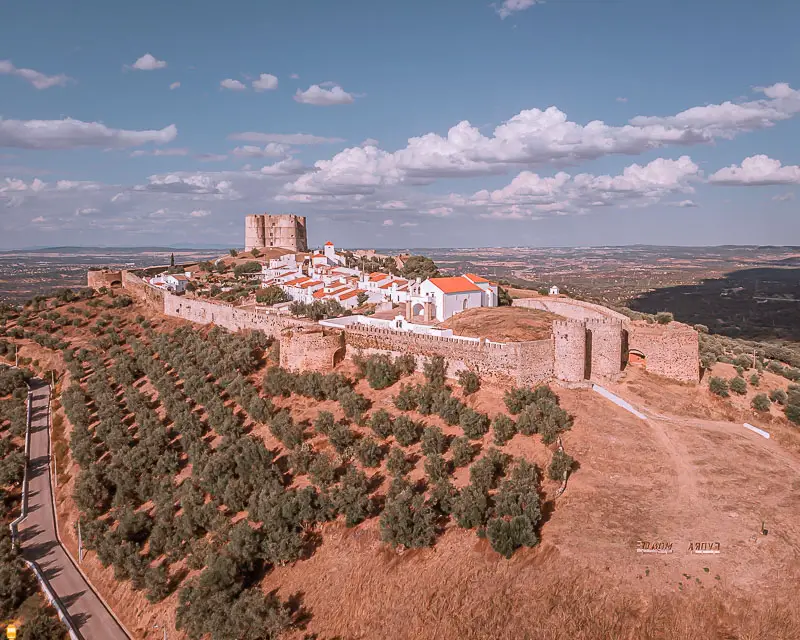
This castle dates from the Portuguese reconquest of Évora Monte from the Moors in 1160 and is one of the most unusual in Portugal.
Located at the top of the mountain range Serra de Ossa, in Alentejo, it presents a square shape with 4 circular towers at each end. Its Gothic style is mixed with elements of the Italian inspired Renaissance style.
59. Estremoz
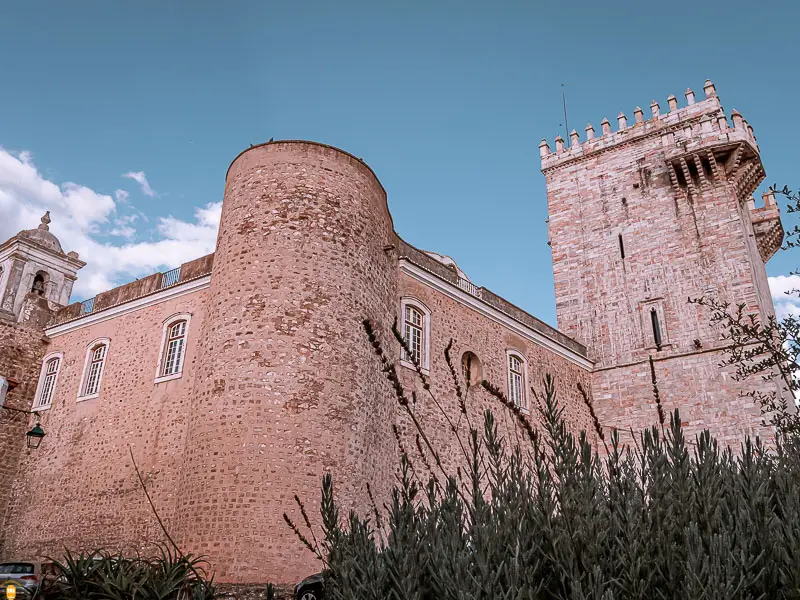
Estremoz is undoubtedly one of the cities to visit in Alentejo, due to the old city that surrounds the castle. Its 28 metre high keep is one of the most beautiful in Portugal! This castle was built with marble extracted in large quantities in the region (Portugal is the second largest exporter of marble in the world).
In the old city, located inside the ramparts, visit the fortress (don’t forget to climb to the top to have a superb view of the surroundings), the castle that dates from the 12th century and where you can sleep (Pousada do Castelo de Estremoz, affiliated link ), the chapel Capela de Santa Isabel, the church Igreja Matriz de Estremoz and the palace Paço do Concelho.
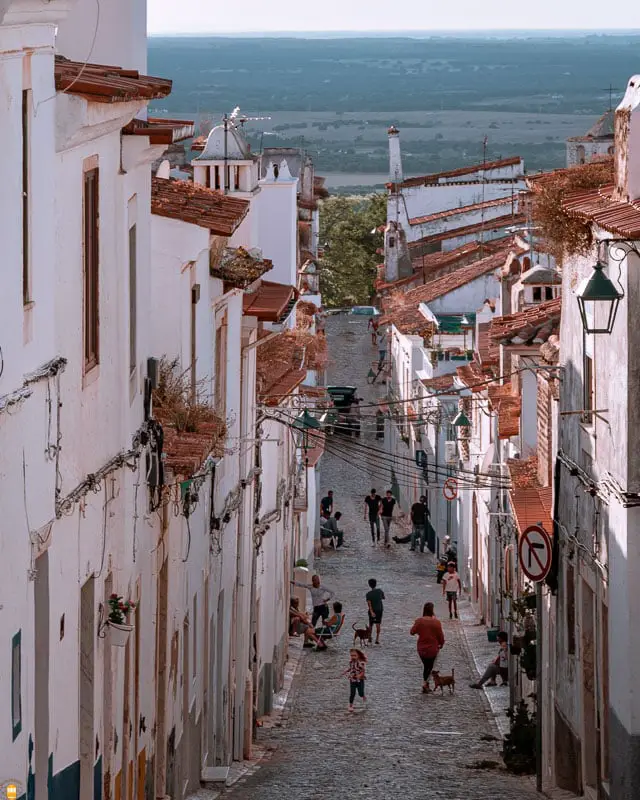
In the “new city”, visit the Centro Ciência Viva de Estremoz, an interactive and educational museum located in a former convent.
Admire the beautiful façade of the church Igreja do Convento dos Congregados de Estremoz and that of the Águias d’Ouro café / restaurant.
60. Vila Viçosa
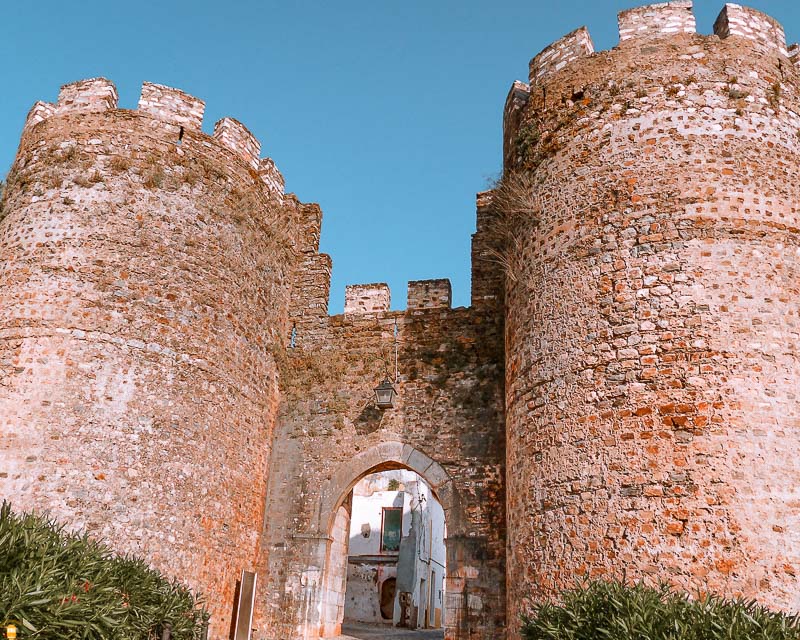
The princess of Alentejo became a museum town in 1910 with the proclamation of the First Republic and the end of the monarchy.
First Roman, then Muslim until 1217, Vila Viçosa became one of the most important towns in Portugal from 1461 onwards, with the arrival of the Dukes of Bragança, the most powerful noble family after the Royal House.
It is also known worldwide for its marble extracted from dozens of quarries in the region.
During your visit, make sure to go to the majestic palace Paço Ducal, former residence of the Dukes of Bragança, the Castle of Vila Viçosa, built in the 13th century, the sanctuary Santuário de Nossa Senhora da Conceição and the beautiful church Igreja de São João Evangelista.
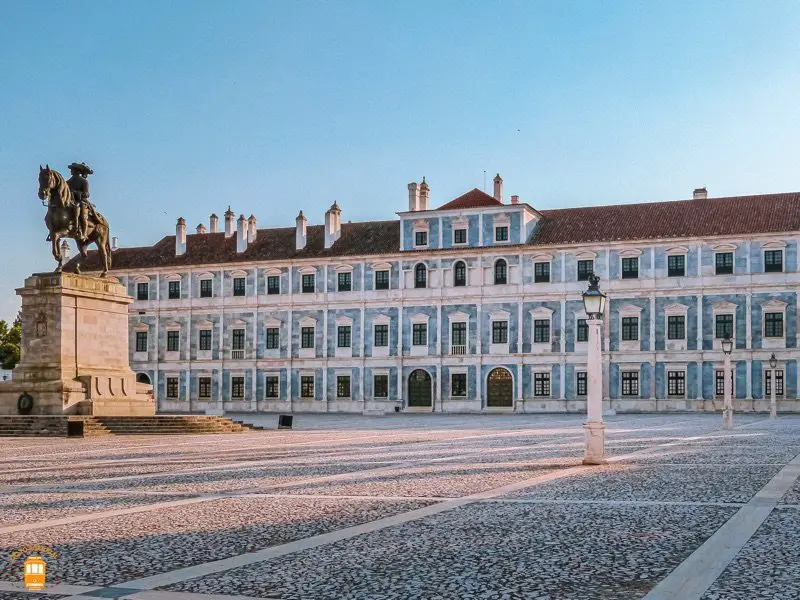
61. Elvas
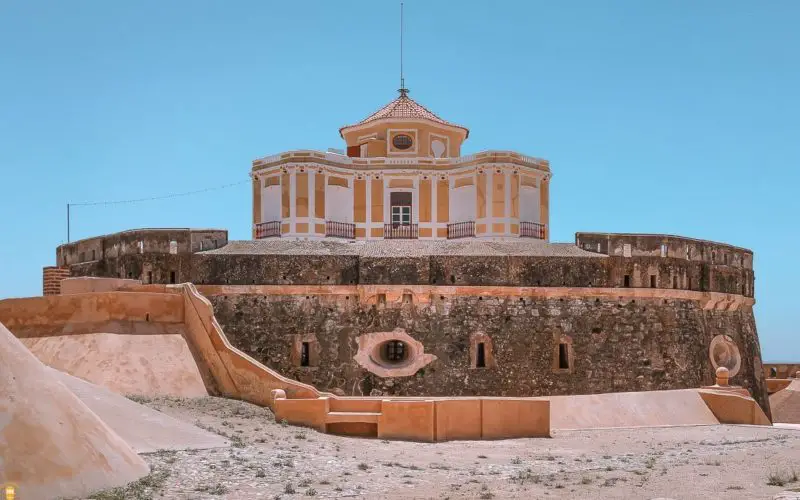
Listed as a World Heritage Site by UNESCO, Elvas is for me one of the most beautiful cities in Portugal. It was heavily fortified after 1640, during the restoration of the Portuguese independence, to protect itself from attacks from neighbouring Spain.
To withstand a long siege and supply the city with water, an aqueduct composed of 843 arches and 7 km long was built by the same architect who built the Torre de Belém in Lisbon.
To discover all the wonders of Elvas, read the article Discover Elvas, the biggest fortified city in Europe.
62. Coudelaria de Alter
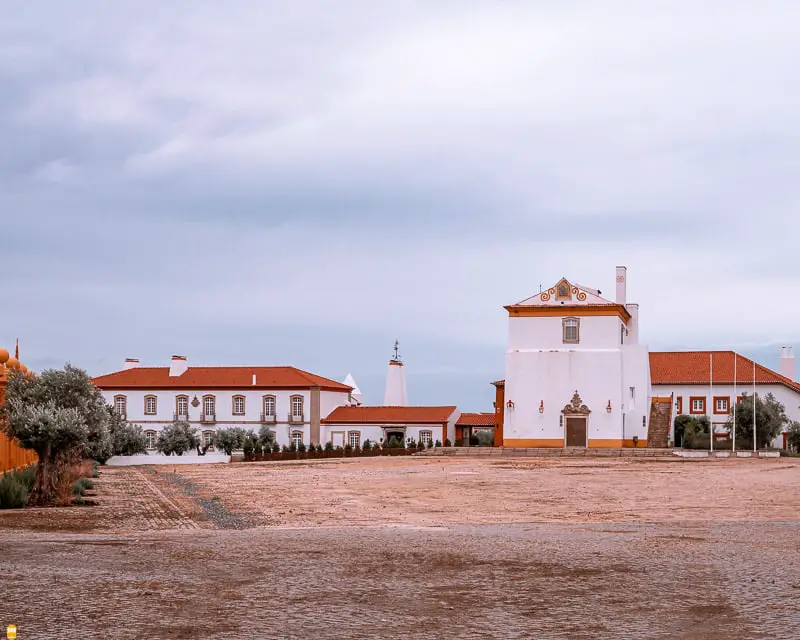
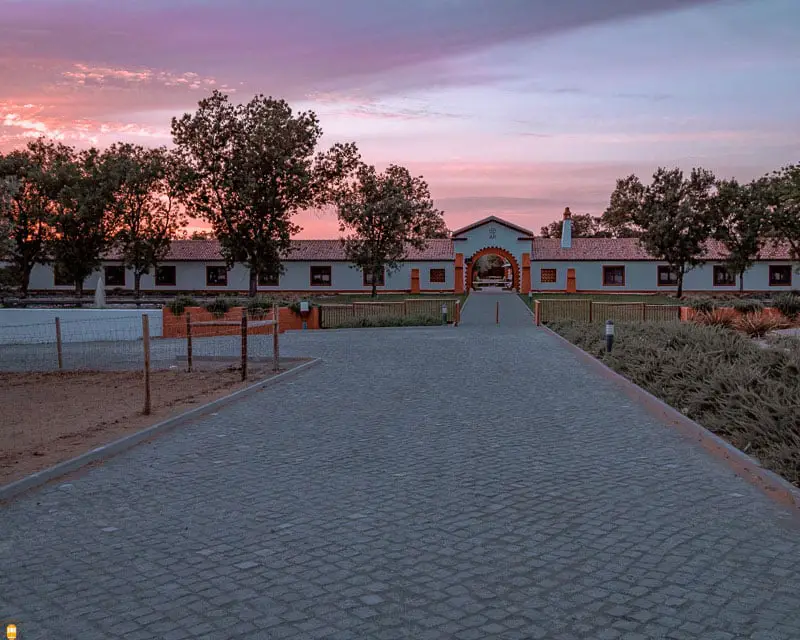
The Alter Stud Farm, located very close to the town of Alter do Chão (hence the name), was founded in 1748 to develop the Lusitanian breed of horses. It is the oldest Portuguese stud farm and the oldest active stud farm in the world.
When you arrive at the stud farm, you can learn more about its history, visit the stables, the museum, take horseback riding lessons and see the daily tour of the mares that go to the pasture.
For visiting hours, prices and exact address, click here.
63. Marvão
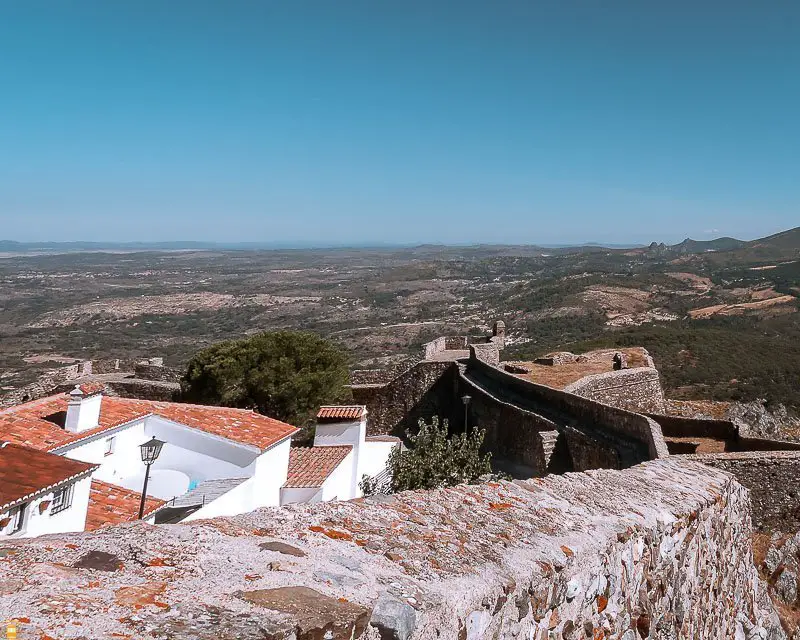
This small town is one of the postcards of Alentejo! Marvão is proudly high on the cliffs of the mountain range Serra do Sapoio, at an altitude of 860 metres. With a unique history and rare beauty, this place is on the list of candidates for UNESCO World Heritage.
During your visit, lose yourself in the narrow streets, protected by ramparts. Explore every corner and go to Marvão Castle. Here, you can admire the landscape that stretches for tens of kilometres and imagine what it would be like to live in this place hundreds of years ago.
Information: take the opportunity to discover one of the most beautiful cathedrals in Portugal, the Cathedral of Portalegre.
64. Castelo de Vide
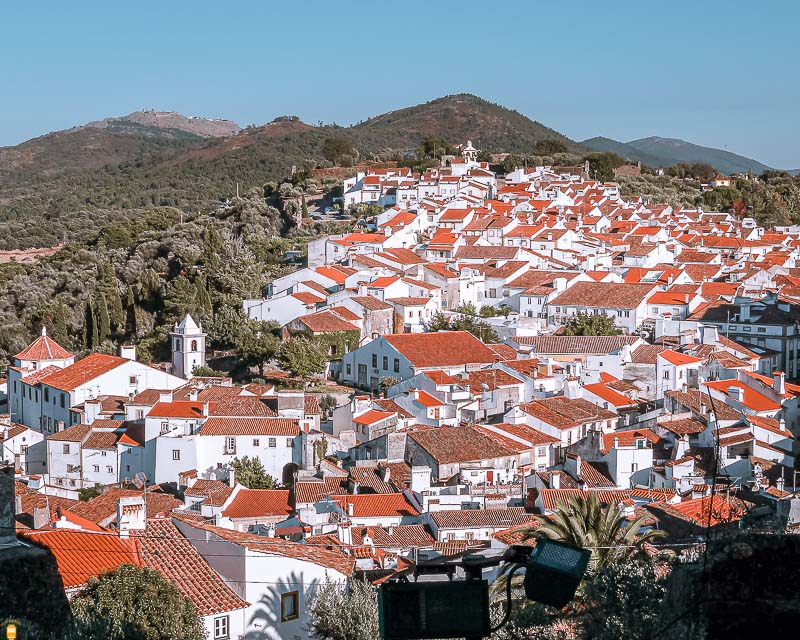
The beautiful town of Castelo de Vide is a jewel of the Alentejo, an incredible place where you will find traces of medieval times.
With centuries of history, this village has several points of interest that are worth your visit. Do not hesitate to spend some time walking through the narrow streets of the city and visiting these places:
- Castle
- Judiaria (old Jewish quarter)
- São Roque Fort
- Renaissance fortifications (17th century)
65. Belver
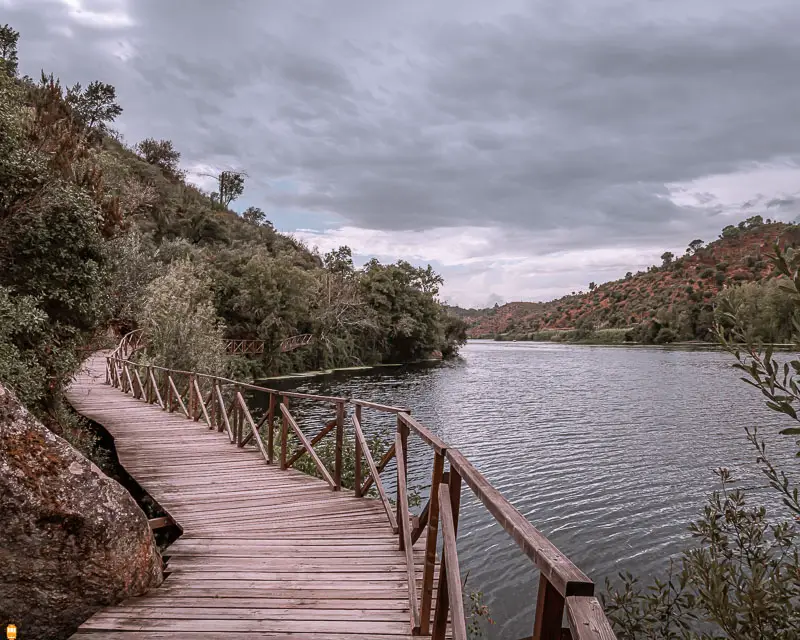
Located on the north bank of the Tagus river, the village of Belver is a very photogenic place. To fully enjoy Belver, leave your car on the river beach of Alamal and stroll along the wooden walkways placed by the river, over a 2 km stretch.
While hiking, take beautiful photographs of the river and the Belver Castle, built in the 13th century. Get back in your car, cross the Bridge of Belver and explore the village. Visit the castle, the soap museum (Museu do Sabão) and the Belver Museum of Tapestries (Núcleo Museológico das Mantas e Tapeçarias de Belver).
66. Historic Villages
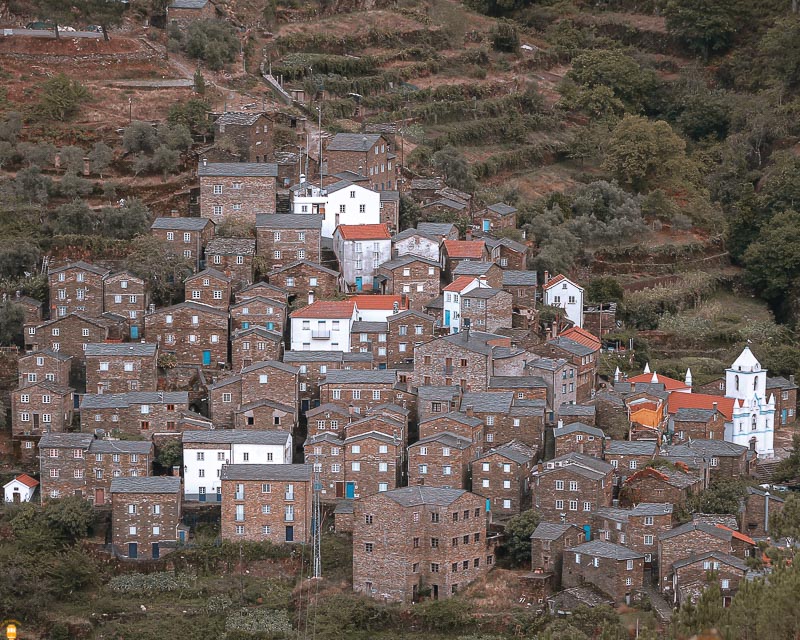
Visiting the historic villages means discovering a network of 12 villages dating back to medieval times, where part of Portugal’s history unfolded.
These villages are the result of the resettlement by the Portuguese of lands recovered from Muslims and to protect the borders with neighbouring Spain.
Aside from discovering part of the Portuguese history, when visiting these villages, you can admire an authentic Portugal, houses built with material from the region, often protected by a castle, and greet the elderly who live there!
If you don’t have time to visit the 12 villages, I recommend that you visit at least Monsanto, Sortelha, Marialva and Piódão.
For more information on these villages, read the article Discover the 12 historic villages of Portugal.
67. Penha Garcia

Located very close to the Spanish border, Penha Garcia has, like many villages and towns near the border, a castle built in the Middle Ages to protect the population from attacks by the kingdom of León (today Spain) in the east and Muslims in the south.
From the castle, you will have a beautiful view over the village that you should also visit, the dam on the Pônsul river, the water mills and the river beach (pool) of Pego.
68. Serra da Estrela
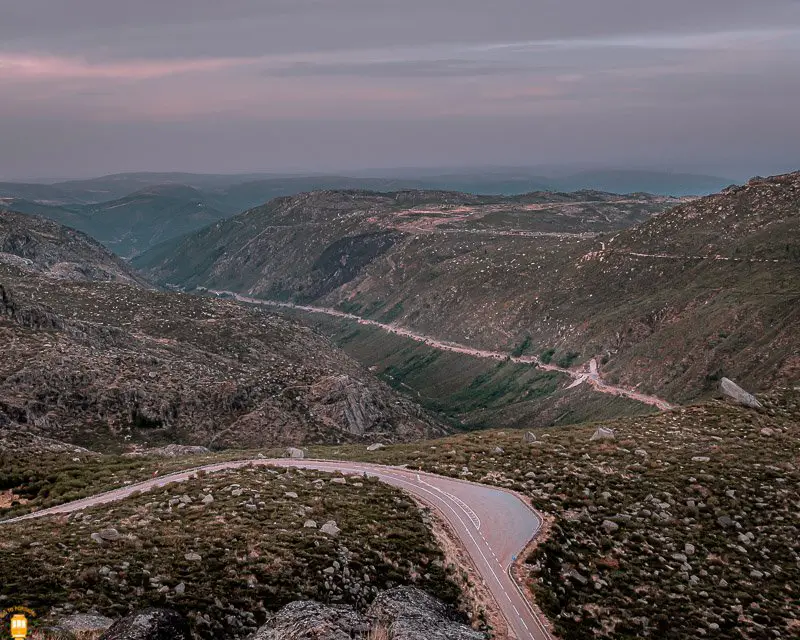
The Serra da Estrela Natural Park is the largest protected area in Portugal, with 101.000 hectares. When visiting the park, you can go hiking in the midst of incredible landscapes, discover the highest point in mainland Portugal with 1993 m (Torre) and ski on the only ski slope in Portugal.
Be sure to try the cheese Queijo da Serra and discover places like Sabugueiro, Linhares da Beira, Loriga, the cities of Covilhã and Guarda and natural wonders such as Lagoa Comprida, Covão dos Conchos and the Zêzere Glacier Valley.
69. Viseu

Viseu is a city unknown to tourists (foreigners), but it has added value that few cities have in Portugal! It is not by chance that it was chosen as the best city to live in Portugal on several occasions.
Viseu is a city with origins that go back to the Iron Age. It was conquered by the Romans, after strong resistance from the Lusitanians (the ancestors of the Portuguese people).
After a few years under the control of the Visigoths, Viseu became part of the Muslim empire in the year 716.
The city became Christian again in 1058, with the victory of King Fernando I of Leão, and in 1123 Viseu became part of the Portucalense County. After this integration, the city was attacked several times by troops from Castile (Spain).
To protect the city, King Dom João I of Portugal built a defensive wall throughout the city, of which two of the original seven gates still remain (Porta do Soar and Porta dos Cavaleiros).
As you can see, Viseu has a rich history, but the city does not live only from its past, it was able to modernise and today offers an exceptional quality of life. It is no coincidence that the population went from 33.000 people in 1801 to more than 99.000 in 2011 (last census).
During your visit, admire the Cathedral of Viseu, the Porta do Soar and Porta dos Cavaleiros and enjoy the many works of urban art scattered throughout the city.
During your visit to Viseu, take the opportunity to walk or cycle in the Ecopista do Dão, located on the old Dão railway line (deactivated in 1988). You can discover 49 km (98 km round trip) of beautiful landscapes, old stations, tunnels, bridges, the Dão and Paiva rivers and a steam locomotive from 1885.
For more information about this city and the places to discover in the surroundings, read the article What to visit in Viseu, the best city to live in Portugal.
70. Pinhel
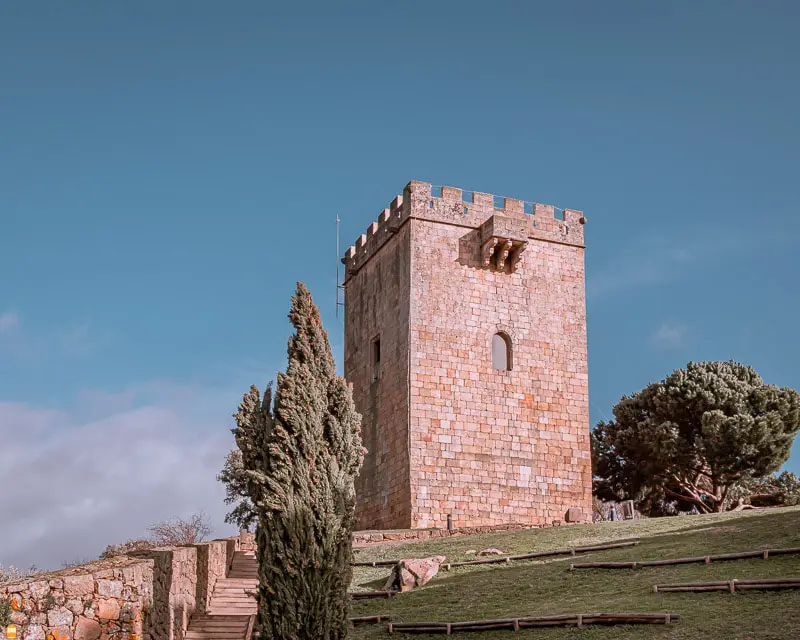
Close to several historic villages (Almeida, Castelo Rodrigo, Trancoso), Pinhel deserves a small detour to discover the historic part of the city located within the ramparts built in the Middle Ages (at the same time as the castle) to protect Portuguese borders from attacks by the Kingdom of León.
71. Castelo de Penedono
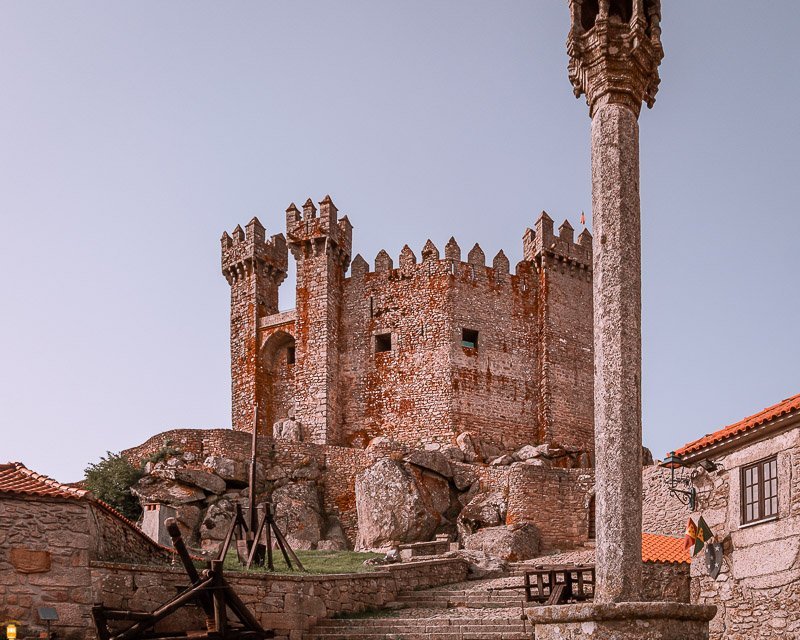
This castle, located in the town of Penedono, is for me one of the most beautiful castles in Portugal! Even though it dates back to the 10th century, its current structure was built in the 14th century.
72. Freixo de Numão
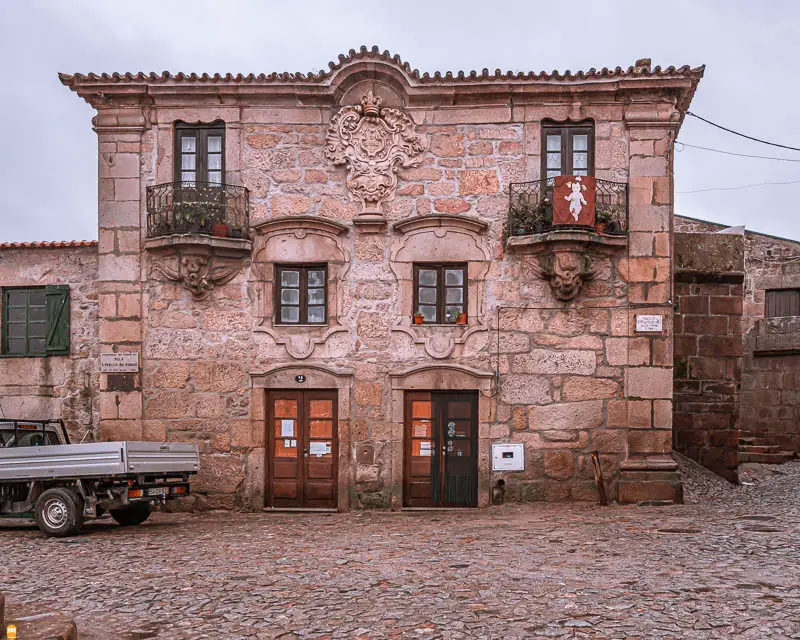
Just 12 km from the Douro, Freixo de Numão is a parish in the municipality of Vila Nova de Foz Côa, surrounded by beautiful landscapes composed of vineyards, olive and almond trees.
During your visit, lose yourself in the alleys of the village where you’ll find a beautiful pillory, visit the Casa Grande Museum, located in a beautiful 18th century mansion (manor house), once inhabited by the region’s nobles.
You can admire many objects used in the local culture and economy (pastoralism, wine, olive oil, almonds) and a section dedicated to archaeology.
In the vicinity you can visit Castelo Velho, an archaeological site where the ruins of a fortified building from 3000 to 2000 BC are located and the archaeological site of Prazo, where you can admire the ruins of a Roman city.
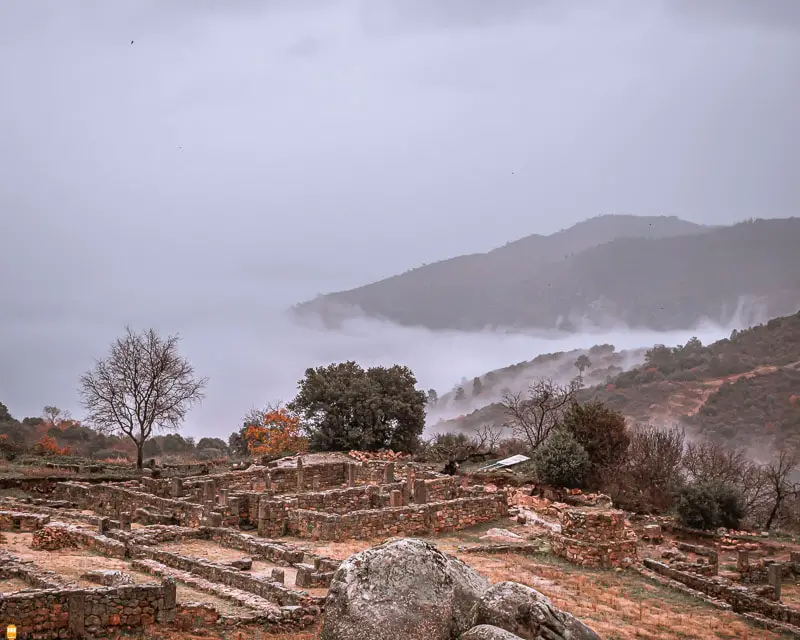
73. Parque Arqueológico do Vale do Côa
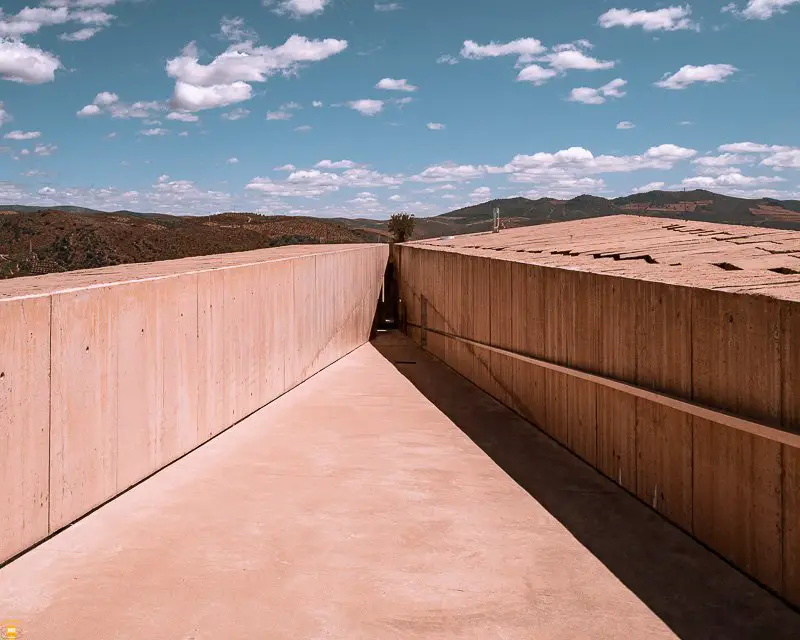
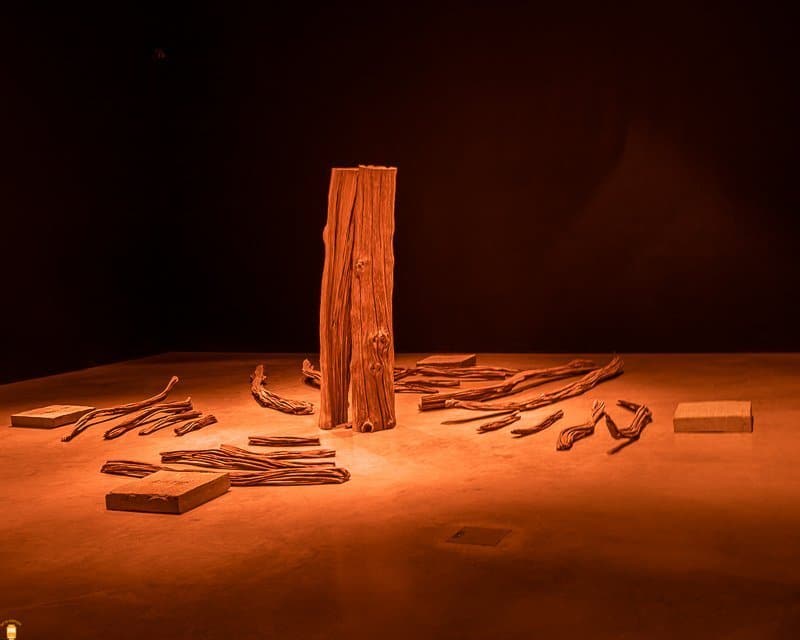
Listed as a World Heritage Site by UNESCO, the prehistoric rock art site of the Côa river valley is the most important outdoor Paleolithic rock art site in all of Europe.
This exceptional place was almost submerged by the waters of a dam that was going to be built nearby. Decided in 1991, it was only in 1995 that the Portuguese government stopped its construction to save this historic treasure.
During your visit to the Vale do Côa Archaeological Park, start by going to the Côa Museum, inaugurated in 2010, to show in detail the rock art. In this modern building, which combines perfectly with the surrounding nature and offers stunning views of the Côa and Douro rivers, you can see the permanent exhibition and temporary exhibitions on this special art.
In addition to your visit to the Côa Museum, you can and should take a guided tour to discover one of the three rock art centres (website in Portuguese): Penascosa (departing from the village of Castelo Melhor), Ribeira de Piscos and Canada do Inferno (departing from the museum).
Information: in the Côa Museum building, there is the Côa Museu restaurant, where I suggest you have lunch or dinner while enjoying a superb view over the Douro and Côa valley.
74. Miradouro de Penedo Durão
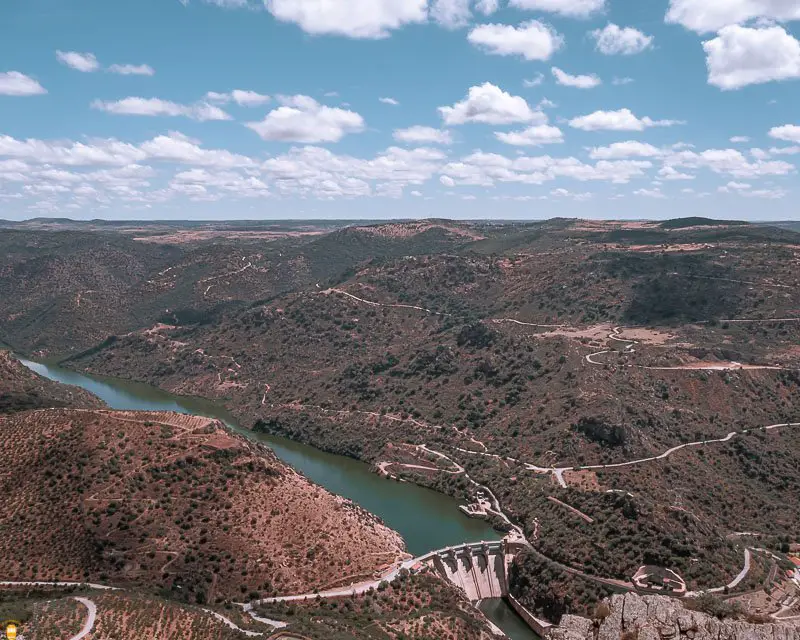
For me this viewpoint is one of the most beautiful in the Douro Valley! Here, you can enjoy the beautiful Portuguese and Spanish landscapes (on the other side of the river) of this beautiful valley, a dam and, without a doubt, you will have the opportunity to see many birds of prey (Egyptian vulture, golden eagle, peregrine falcon).
While in this region, take the opportunity to discover the town of Freixo de Espada à Cinta, located about 12 km from the viewpoint of Penedo Durão. There, explore the historic centre, in particular:
- Tower Torre do Galo
- Ramparts of the old castle
- Church Igreja Matriz
75. Miradouro de Picote

The Picote viewpoint is another viewpoint that offers magnificent views over the Douro valley. It is located in the village of Picote, in the Douro International Natural Park, 18 km from Miranda do Douro, a city with 2 official languages: Portuguese and Mirandese.
76. Bragança
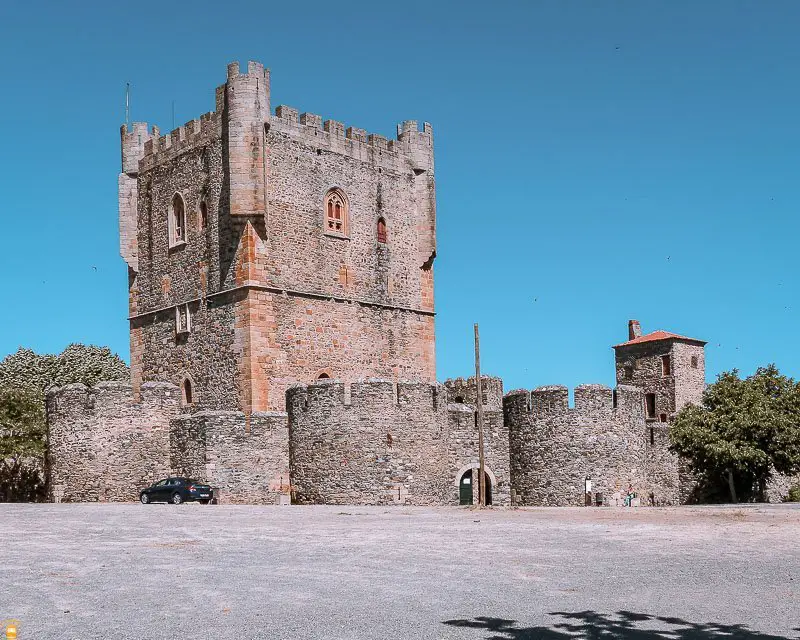
Founded in the 2nd century BC, Bragança is a city to visit during your stay in Portugal, especially for its beautiful citadel. There, you will find the church Igreja de Santa Maria, the Domus Municipalis built in the 12th century, which was used as a cistern and later as a city hall, the pillory, the beautiful castle of Bragrança, in addition to the Iberian Mask and Costume Museum (Museu Ibérico da Máscara e do Traje).
Outside the citadel, in the current city centre, visit the Abade de Baçal Museum, the church Igreja de São Vicente, then take the N217-1 road and stop at the Cidadela viewpoint to take beautiful photographs of the citadel of Bragança.
77. Parque Natural de Montesinho

The Montesinho Natural Park is one of my favourite places in Portugal due to its authenticity, beautiful landscapes and villages frozen in time.
With more than 75.000 hectares, the park is home to approximately 9000 inhabitants dispersed in 92 villages, of which one (Rio de Onor) is divided in two by the Spanish border.
In addition to Rio de Onor, visit the villages of Montesinho, Gondesende, Dine, Moimenta, Guadramil and the Biological Park of Vinhais, where you can admire around 23 breeds of animals, such as deer, wild boar, eagles, donkeys, etc.
78. Favaios
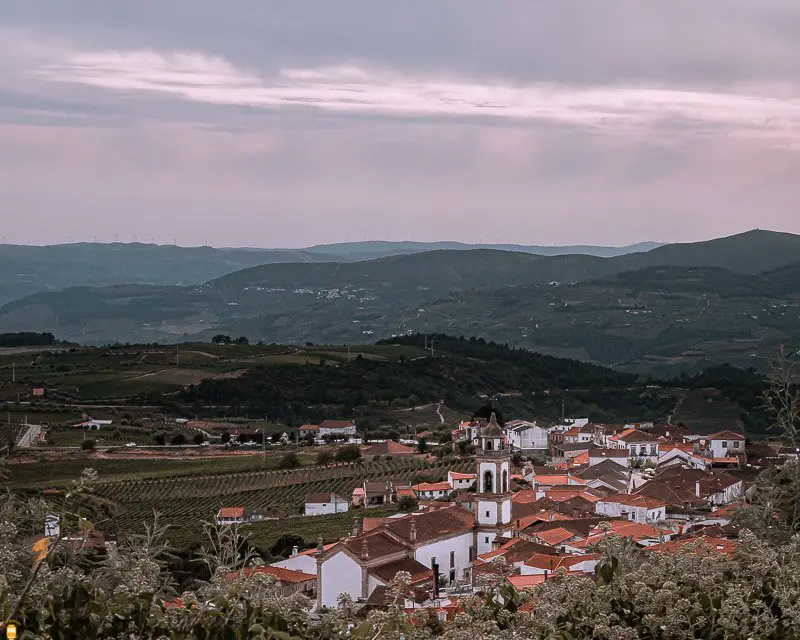
Favaios is a wine-growing village located in the Douro Wine Region (listed as a World Heritage Site by UNESCO) that I invite you to visit when you come to this beautiful Portuguese region.
The village is known for its delicious muscat wine, a grape variety originally from Greece or Egypt, produced in Portugal on the Setúbal peninsula, south of Lisbon, and in Favaios.
During your visit, go to the Capela de Santa Bárbara viewpoint to have a beautiful view of the valley, visit the village centre surrounded by vineyards, the Museum of Bread and Wine (Núcleo Museológico de Favaios, Pão e Vinho) and also the Adega Cooperativa de Favaios.
There, you will discover how muscat wine is produced, where it is stored and you will also have the possibility to taste this delicious wine.
79. Miradouro do Ujo
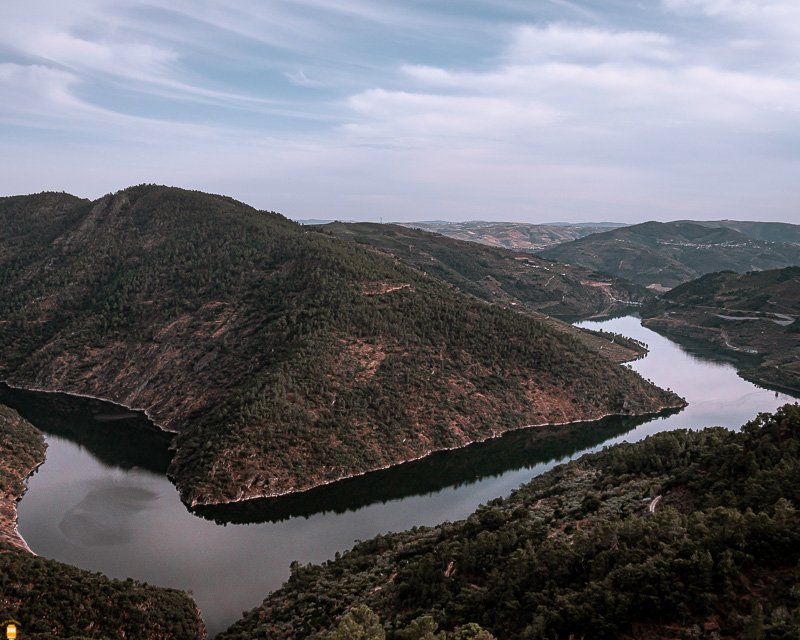
From this viewpoint, you’ll have a breathtaking view over the Tua Valley and the river that will flow into the Douro river.
80. Miradouro Olhos do Tua

On the south side of the Tua valley, this viewpoint also offers incredible views of the river and the valley. During your visit to this region, go to the Interpretation Centre of Tua Valley (Centro de Interpretação do Vale do Tua), located at the Tua train station, facing the Douro river.
Be sure to try the Calça Curta or Tua Mercearia, very popular restaurants amongst those who come here!
81. Pinhão
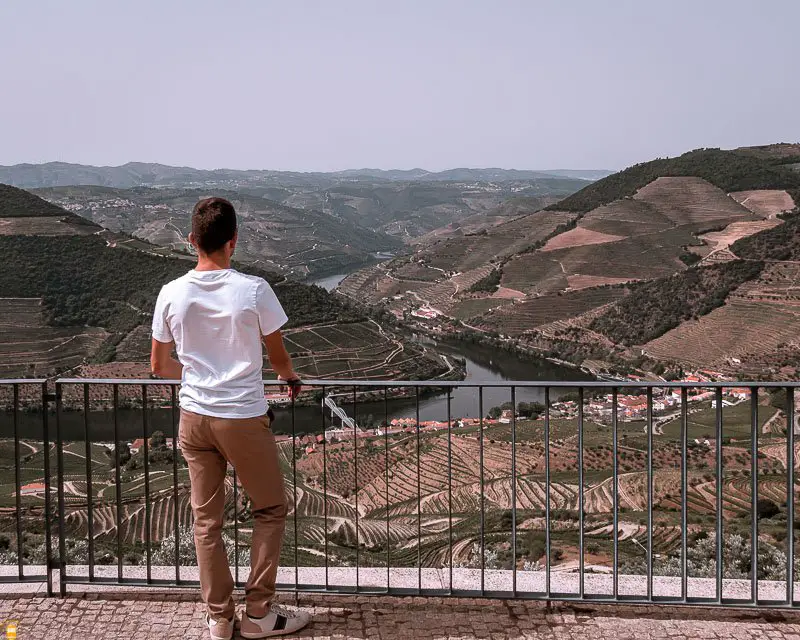
In the centre of the Douro Wine Region, Pinhão is undoubtedly one of the most famous villages in the Douro Valley, due to its beautiful train station, with 24 tile panels representing Douro’s landscapes and scenes of the vintage.
Surrounded by vineyards, there are also wine estates where Port wine is produced and which you can visit to discover all the details of the production process of this amazing wine. Amongst other wine estates, I recommend you visit Quinta do Bomfim, Quinta do Seixo or Quinta das Carvalhas.
Do not leave Pinhão without taking a cruise on the Douro river in a traditional boat that used to transport wine to Porto. This cruise takes at least 1 hour and will introduce you to the most beautiful part of the Douro Valley from a different perspective.
The village is also surrounded by fabulous viewpoints, such as the Casal de Loivos viewpoint and the Torguiano de São Cristóvão do Douro viewpoint.
If you want to discover all the secrets of this magnificent valley, I invite you to read the article Itinerary to visit the Douro Valley and Porto in 7 days.
82. Miradouro de São Leonardo de Galafura
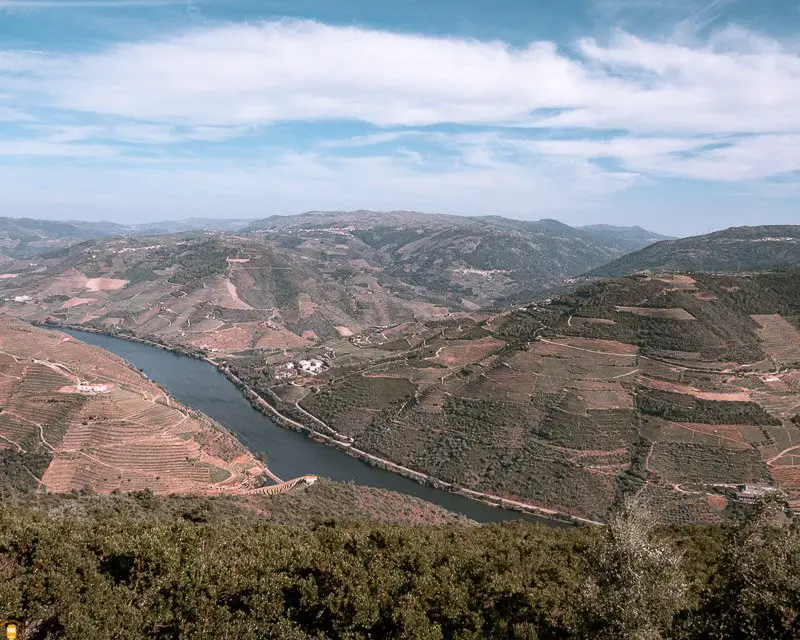
Located about 20 km from Peso da Régua, the São Leonardo de Galafura viewpoint offers exceptional views. From here, you can admire the Douro river, terraced vineyards and the rest of the landscape – the characteristics of which make Douro Wine Region a World Heritage Site.
83. Palácio de Mateus
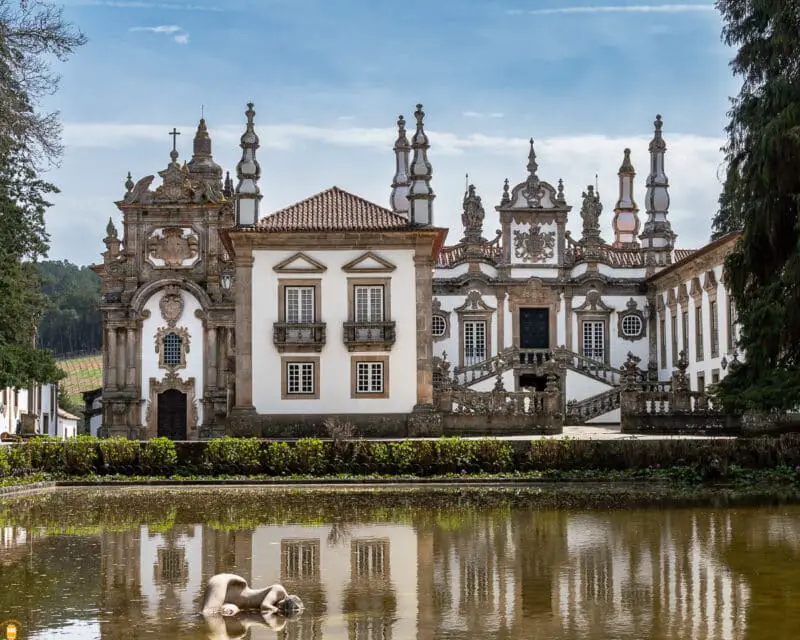
This magnificent 18th century palace, designed by Nicolau Nasoni, is characterised by the Baroque style and the surrounding beauty of its gardens, lakes, forests and vineyards. While visiting the Douro Valley don’t miss the opportunity to discover this national monument, as well as its winery and chapel.
Site: www.casademateus.com
84. Estrada Nacional 2
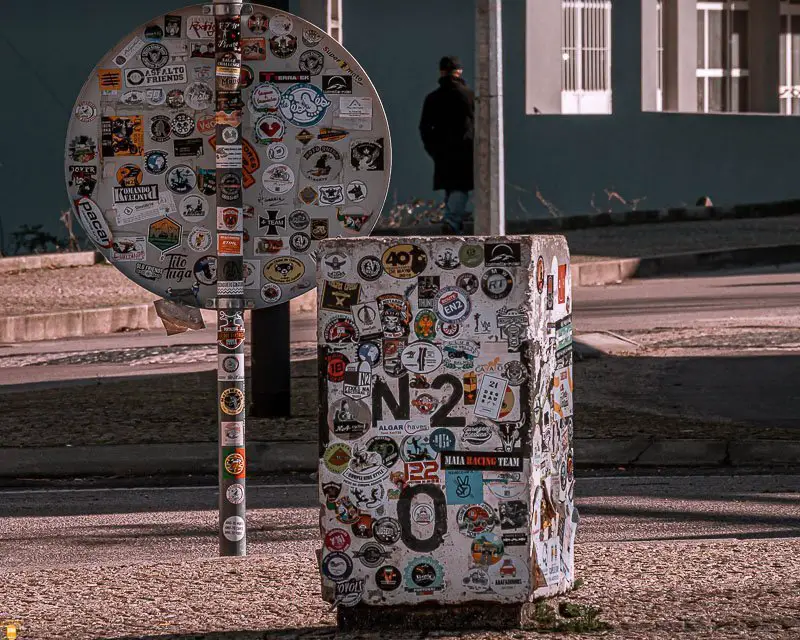
The 739 km long Estrada Nacional 2 is the longest Portuguese road and the only one in Europe that crosses a country along its entire length (there are only 3 in the world: Route 66 in the United States, Route 40 in Argentina and N2 in Portugal).
Its route starts in the city of Chaves, close to the Spanish border (northern Portugal) and crosses the countryside to Faro, capital of Algarve.
By following this route, you can discover many places mentioned in this article, see the different landscapes of northern and central Portugal, admire the plains of the Alentejo and go all the way to Algarve.

85. Lamego
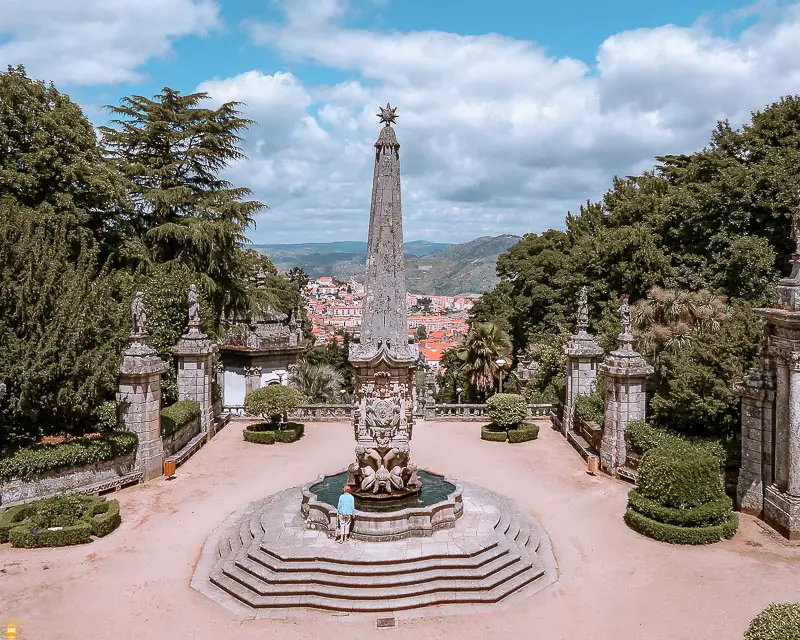
A millenary city, Lamego is located in the Douro Wine Region and has many monuments to visit when exploring this part of Portugal.
In the city centre, visit the beautiful cathedral Sé Catedral de Lamego, built in the 12th century, the Lamego Museum, the castle from which you will have a beautiful view of the city and the surrounding alleys.
Climb to the sanctuary Santuário de Nossa Senhora dos Remédios, built from 1750 to 1905 with characteristics of the Baroque and Rococo style. Drive there or go up the long and beautiful tile-decorated stairs that start in the city centre.
86. Drave
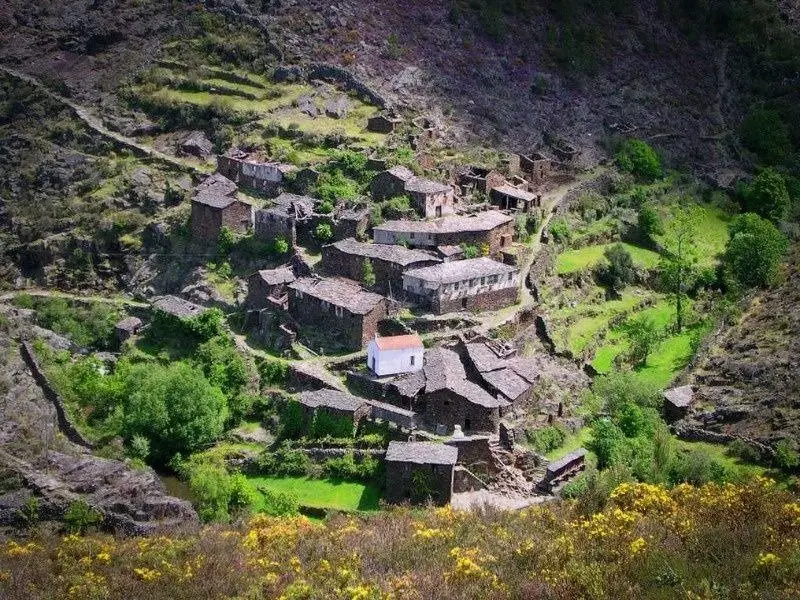
The village of Drave is one of the most isolated in the whole country. It is located at the bottom of a valley between several mountains 35 km from the city of Arouca.
Inhabited for many centuries, the village of Drave is now abandoned (the last inhabitant left in 2000) and to get there, you need to walk 4 km (2 hours) from the village of Regoufe.
To the south of the village, there is a forest dirt path that will take you a few metres from the village, but I do not recommend that you drive the 3 km of that path. Do this only if you have a jeep.
87. Miradouro Frecha da Mizarela
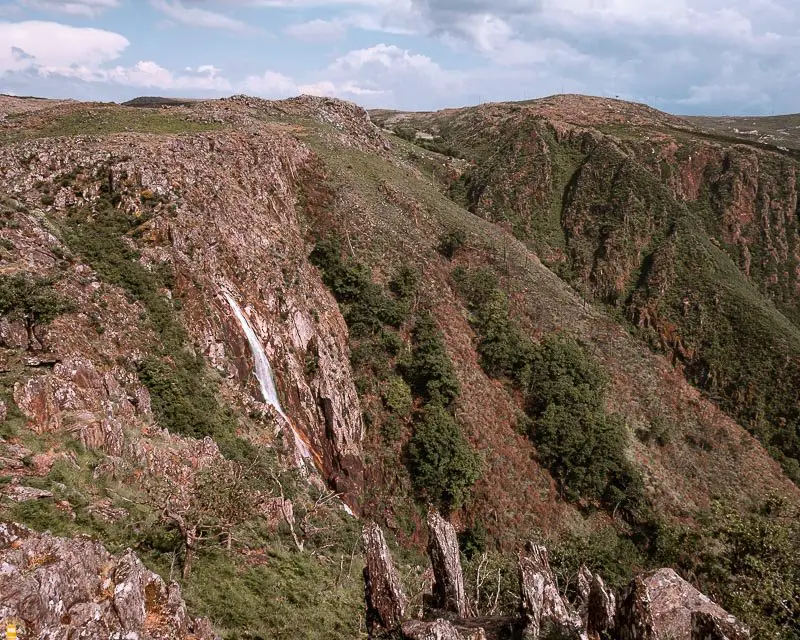
The Frecha da Mizarela viewpoint offers an incredible view of the 60 metre high waterfall with the same name. If you want to get close to the waterfall, you can take the PR7 walking route of approximately 9 km (6 hours).
You can also admire this waterfall and have a panoramic view of this beautiful part of Portugal if you climb to the top of the Arouca weather radar.
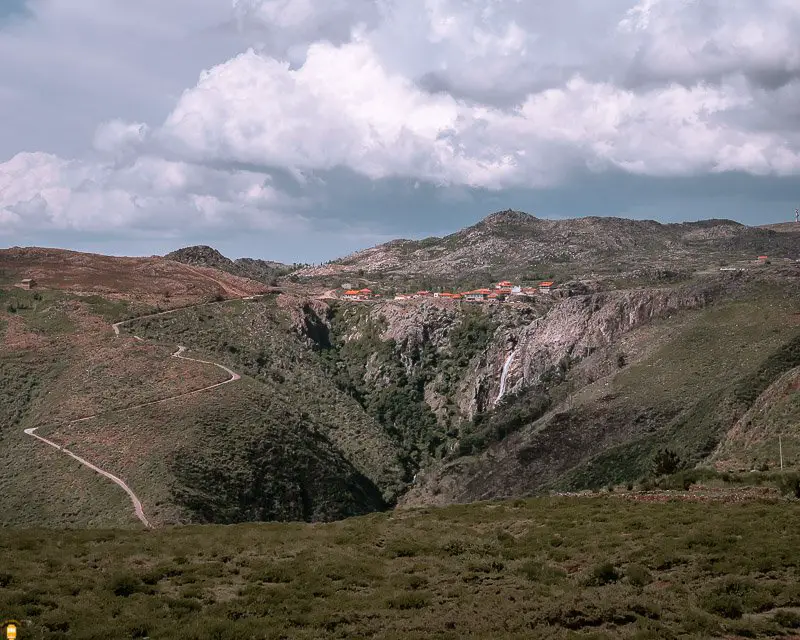
88. Miradouro do Detrelo da Malhada

Located in the Arouca Geopark, like the previous viewpoint, the Detrelo da Malhada viewpoint offers an amazing panoramic view of the Freita mountain range and the Arouca valley.
89. Passadiços do Paiva
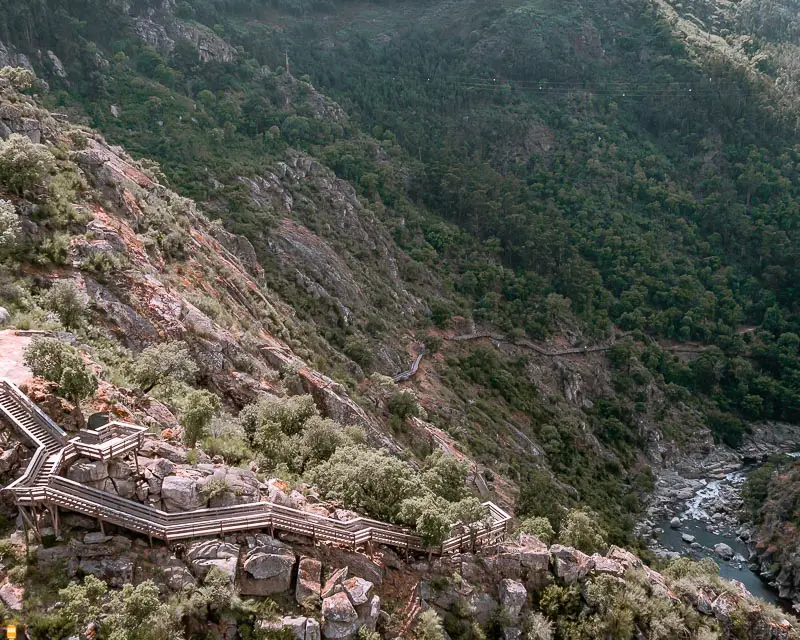
The Paiva Walkways are an 8 km walking path located 14 km from the city of Arouca. Most of the route is made on wooden walkways (hence the name of the route) in the valley that accompanies the Paiva river, a river that flows into Douro.
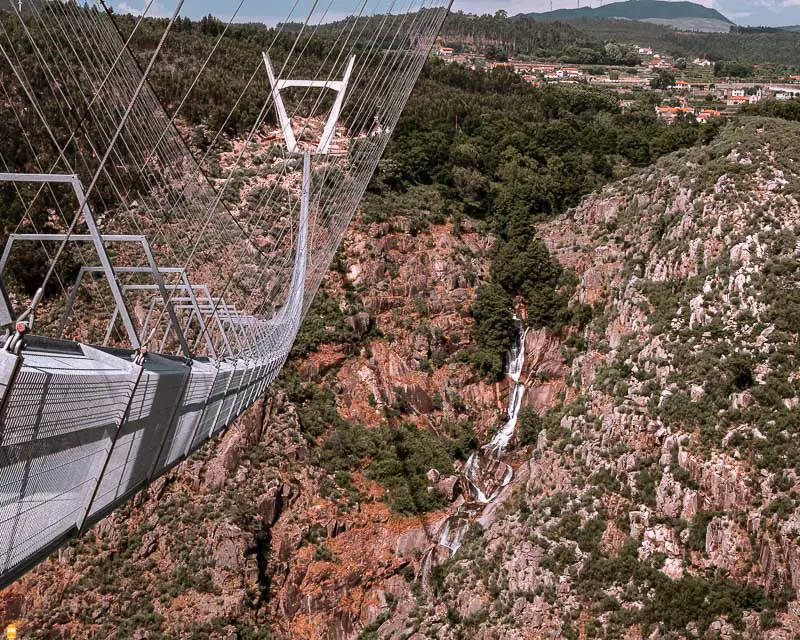
This walking route was inaugurated in June 2015 and has since become one of Portugal’s main attractions. In the first year, almost 8000 people visited this site every day.
To avoid the harmful effects of a very large number of people going there, the route is now limited to 3500 people per day and an entrance fee of at least 2 euros must be paid to be used to pay for the maintenance of the route.
On the way, you will find SOS terminals, 3 river beaches (one in the middle and the other two at the ends), a bar on each side and, of course, fabulous views.
The route is considered difficult, remember that if you cannot make the round trip (16 km), you will find taxis that will take you to the starting point for around € 15.
I invite you to visit the official website to obtain all the necessary information (GPS coordinates, map, timetables, purchase of tickets).
Information: in late 2020 or early 2021, the largest suspended pedestrian bridge in the world, 516 metres long and 175 metres above the Paiva river, will be inaugurated. Without a doubt, it will be a must-see attraction for years to come!
90. Igreja de São Martinho de Soalhães
At first glance, the church Igreja de São Martinho de Soalhães, located 20 km from Amarante and the Douro river, is nothing out of the ordinary, but don’t be fooled by appearances!
Built in the 12th century, in a Romanesque style, the interior of the church will impress you, especially if you like beautiful tiled decorations.
It can be visited by appointment or during the two weekly masses (17:30 on Saturdays and 21:15 on Sundays). For complete details about the church and to schedule a visit, visit the Rota do Românico website.
91. Amarante
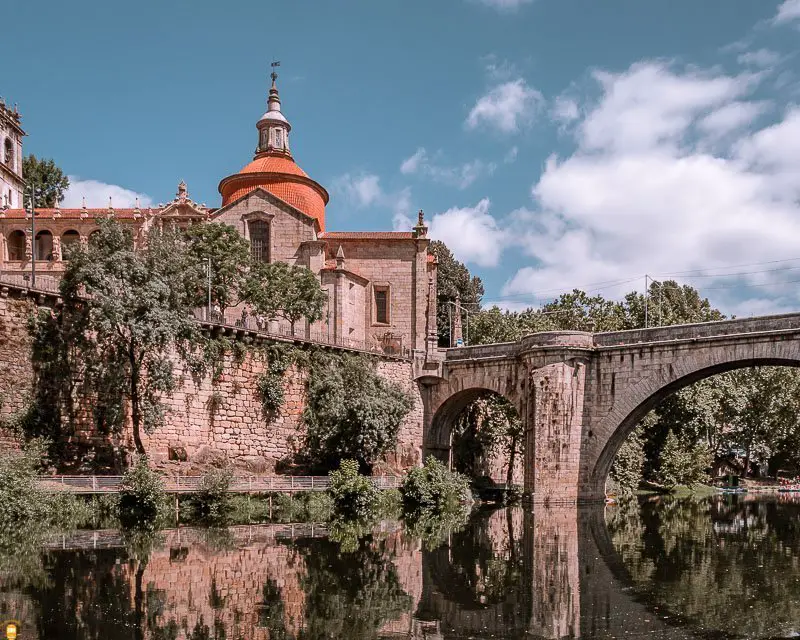
At this beautiful city, I suggest you take some time to explore the historic centre, as it is full of must-see places:
- São Gonçalo Church and Convent
- São Gonçalo Bridge
- Church of São Pedro
- Church of São Domingos
- City Museum of Amadeo de Souza-Cardoso
In addition to the places mentioned above, stroll through the alleys of the historic centre and take a walk along the Tâmega river; also enjoy the typical sweets of the region and enjoy a nice meal in one of the restaurants overlooking the river.
92. Parque Natural do Alvão
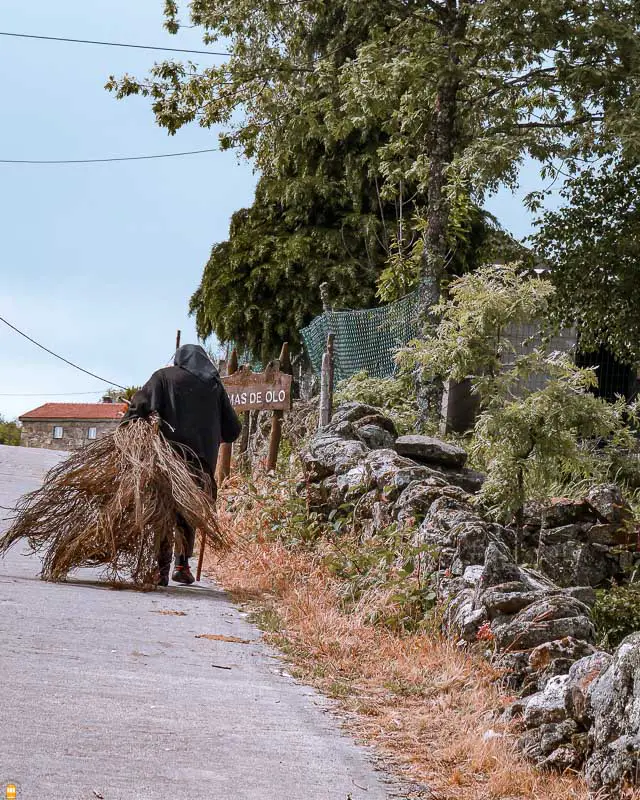
Located near the city of Vila Real and the famous palace Palácio de Mateus, the Alvão Natural Park is one of the smallest Portuguese natural parks (72.2 km2), but also one of the most authentic!
When exploring this site, take the opportunity to visit the villages of Ermelo and Lamas de Olo (located 1000 metres above sea level), which maintains an atmosphere of peace and simplicity, with its small traditional granite houses covered with culm.
The most famous place in the park is the Fisgas do Ermelo waterfall, located 6 km from the village of Ermelo. To admire this natural beauty, head to the Fisgas do Ermelo viewpoint.
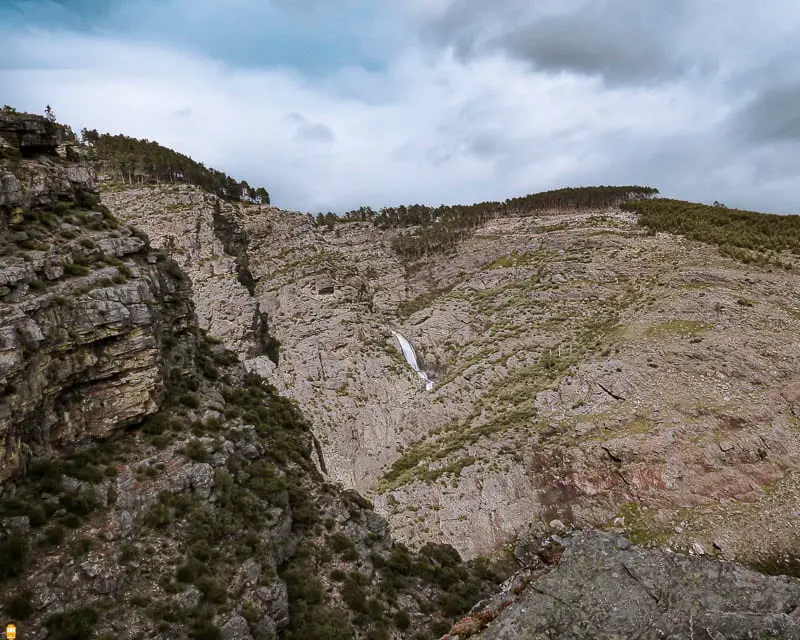
For those who like adventure and hiking, follow the 12 km circular route PR3 (4h30), which starts in the village of Ermelo and passes through the most beautiful places of the Olo river.
Departing from the natural park and to the next point, make a small detour and go to the sanctuary Santuário de Nossa Senhora da Graça in Mondim de Basto, more than 1000 metres above sea level, known for being one of the most difficult stages of the Volta a Portugal de Bicicleta (Portugal Bicycle Tour).
93. Guimarães

Known as the “birthplace of the Portuguese nation“, Guimarães is a city full of history that will surely surprise you!
Here, in 1128, there were some of the main political and military events that led to the independence and the birth of a new nation: Portugal.
Guimarães is one of the most important historic cities in the country, and its historic centre, listed a World Heritage Site by UNESCO, is one of the most beautiful in the whole country!
To discover the wonders of this city, read the article Top 10 of the best places to visit in Guimarães.
94. Braga
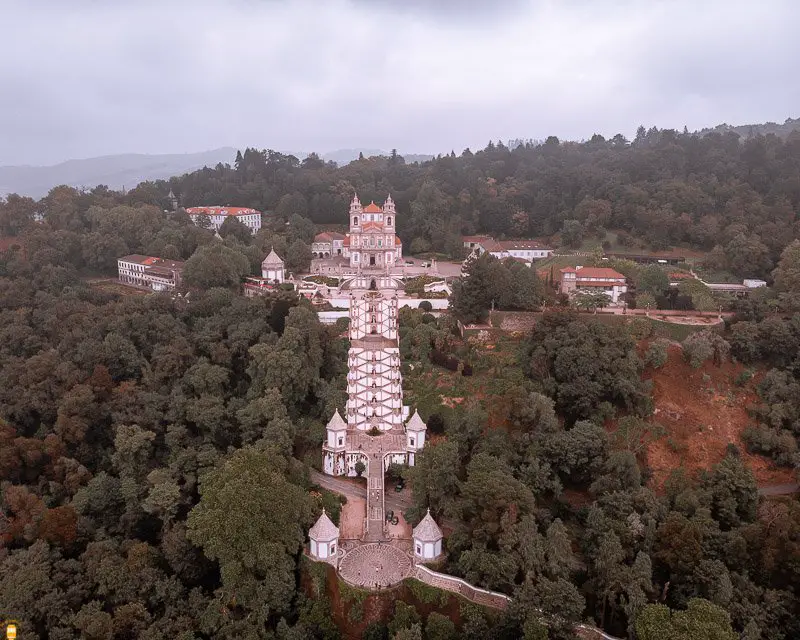
Braga was founded by the Romans over 2000 years ago, under the name Bracara Augusta. It is the oldest Portuguese city and one of the oldest Christian cities in the world.
Braga is known as the Portuguese Rome because of its many beautiful churches, but it hides other treasures that should not be missed, such as beautiful monuments, gastronomy, handicrafts, traditions and festivities.
During your visit to the third city of Portugal, do not miss the opportunity to explore the historic centre, the sanctuary Santuário Bom Jesus do Monte, listed in 2019 as a World Heritage Site by UNESCO, and the sanctuary Santuário do Sameiro.
For more information about Braga, read the article Top 20 of the best places to visit in Braga.
95. Parque Nacional da Peneda-Gerês
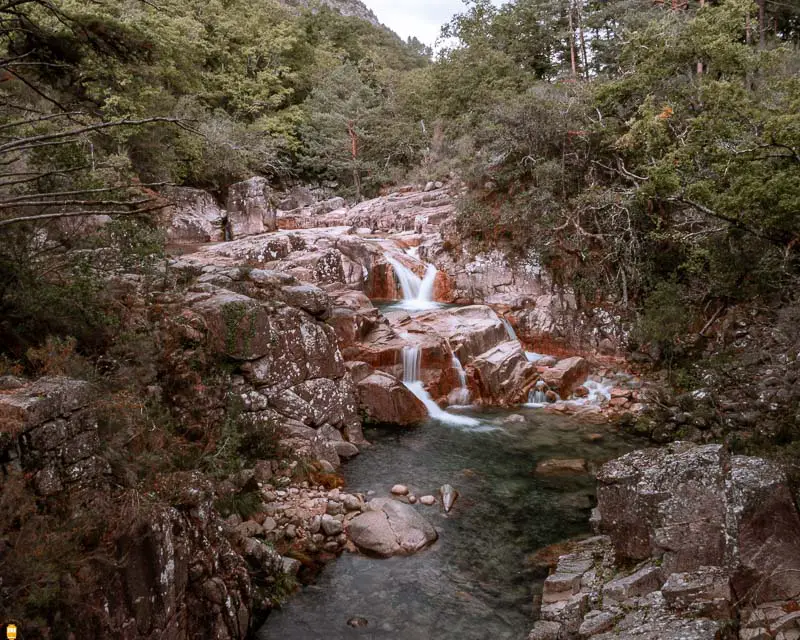
Created in 1971, the Peneda Gerês National Park is home to more than 100 granite villages that have changed little since the creation of Portugal in the 12th century.
Older villages remain isolated from modern life. Oxen are still taken through cobbled streets by women dressed in black, and shepherds still leave their herds grazing for long months.
In the most isolated areas of the park, you can still find wolves as well as wild boars, badgers, otters, deer and wild horses.
In addition to wild animals, you can also see domesticated species that are more easily observed, such as oxen with long horns, goats, sheep, as well as the rustic Castro Laboreiro, a sheepdog.
But you won’t find just villages frozen in time. When visiting the Peneda Gerês National Park, you can admire the magnificent landscapes, thanks to the many viewpoints, bathe in one of the many waterfalls, enjoy the different monuments with a long history of several centuries and you can even rest in a spa town!
If you like nature and authenticity, the Peneda-Gerês National Park is the place for you when you visit Portugal!
To discover the wonders and information necessary to visit this paradise, read the article Top of the best places to visit in the Peneda-Gerês National Park.
96. Sistelo
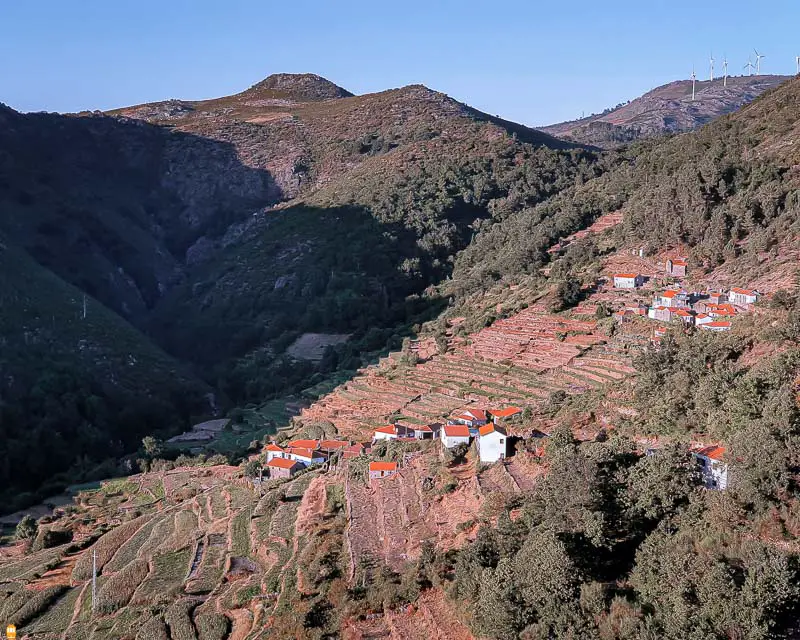
Very close to the Peneda-Gerês National Park, the village of Sistelo is one that you cannot miss during your visit to Portugal!
Located on the banks of the Vez river, at the bottom of the Peneda valley, the village has an exceptional landscape that was listed a national monument in 2017 by the President of the Portuguese Republic. This was the first landscape in Portugal to have this distinction (normally this title is only given to important monuments in the country).
There, you will have the opportunity to admire the terraced fields, known as the small Portuguese Tibet, where corn is produced, food for the livelihood of the inhabitants and grass for cows, which are the main source of income for the village (apart from tourism).
After admiring the landscapes from the Socalcos viewpoint, the granaries and the chapel Capela de Santo António, head to the centre of the village to see the castle of the viscount of Sistelo.
If you love hiking, know that Sistelo and its beautiful region have many walking routes. The best known is the Ecovia do Vez, that starts in the village and stretches along the Vez river for 32 km. A large part of the route is made on wooden walkways, which allow you to walk very close to the river.
There are several entrances along the way, so you can just hike part of the route. I suggest you do the part between the town of Arcos de Valdevez and Sistelo (20 km) or between the medieval bridge of Vilela and Sistelo (12 km). Finish your hike in the village to have the option of taking a taxi to get back to the starting point.
97. Branda da Aveleira

Right at the entrance to the Peneda-Gerês National Park, Branda da Aveleira is a small village that has been particularly inhabited for a long time, only 6 months a year.
In this mountainous region where it snows in winter, the inhabitants were forced to go down the valley to find food for the animals. They stayed there until spring in their second homes and then moved back to Branda da Aveleira, once the mountains were discovered again.
Information: the villages used in the summer are called “brandas” and those used in winter are called “inverneiras”.
During your visit, you can see the small granite houses, some of which have been restored for residential tourism where you can also sleep when you arrive in this authentic region of Portugal.
This village is just one example of the many villages used by the local population. Between Sistelo and Castro Laboreiro, in the Peneda-Gerês National Park, you will have the possibility to discover several.
98. Melgaço
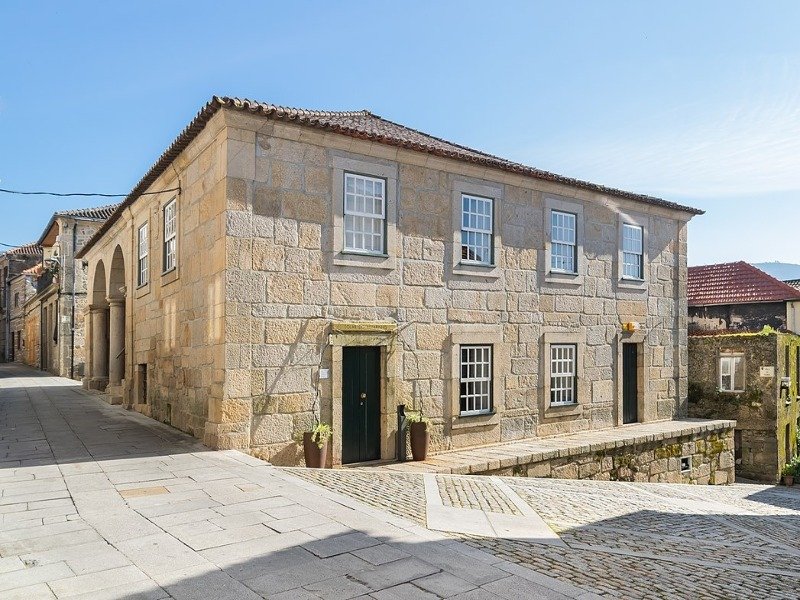
Melgaço is one of the most beautiful towns located on the banks of the Minho river and on the Spanish border. It is well known in Portugal for its delicious Alvarinho green wine, but the village is not just that!
During your visit, lose yourself in the alleys of the beautiful historic centre located around the 12th century castle, built to defend the city and the border against attacks from the Kingdom of León.
After admiring the view from the fortress, visit the Museum of Cinema, the church Igreja Matriz de Melgaço and the church Igreja da Misericórdia, and don’t leave without tasting the region’s wine at Solar do Alvarinho.
When you leave Melgaço, stop at the thermal park of Peso, created in the 19th century, after discovering the therapeutic properties of its waters.
There, you will find a beautiful garden, the river Peso, a spa and the beautiful pavilion in Art Nouveau, where you can find the main source of the park.
99. Valença
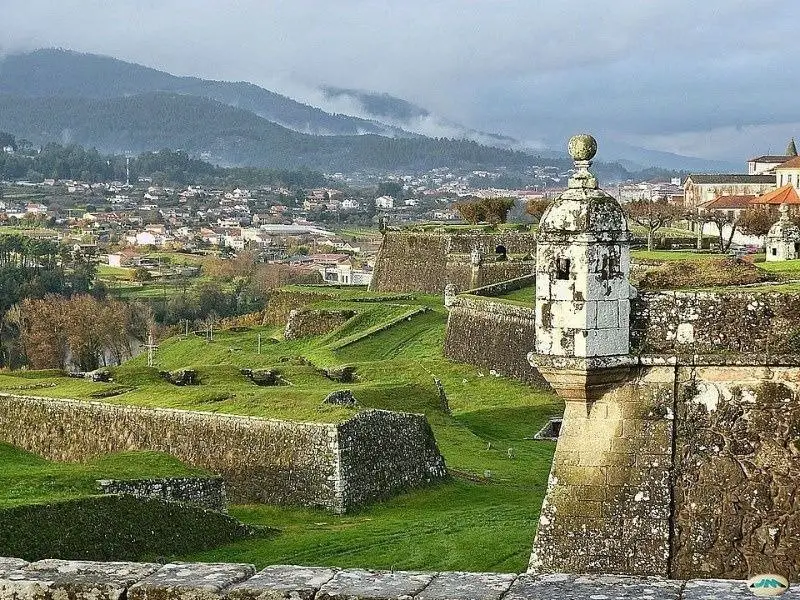
40 km from Melgaço, on the banks of the Minho river and on the border with Spain, there is another city worth visiting in the Alto Minho region.
Valença, also known as Valença do Minho, has the third largest fortress in Portugal. Within the 5.5 km of ramparts built from the 13th century onwards, is the beautiful historic centre, with many churches, museums and, of course, many shops.
Information: the Portuguese route of the Way of St. James (Santiago de Compostela) leaves Portugal through the city of Valença.
If you like walking or cycling while discovering beautiful landscapes, know that the old 16 km trail that connected Valença to Monção was transformed into a bike path (Ecopista do Minho).
Along the route accessible to all, you can admire the region’s vineyards, fields, river, old stations and villages, such as Lapela and its beautiful keep, from where you will have an excellent view of the Minho river, the village and Spain.
100. Ponte de Lima
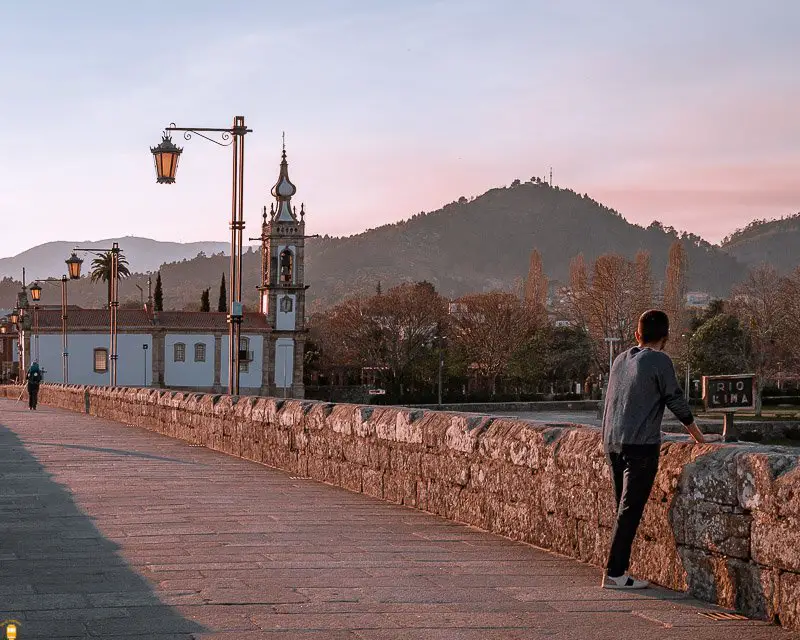
Founded in 1125 by Countess D. Teresa de Leão, mother of the first Portuguese king, Ponte de Lima is one of the oldest towns in Portugal and one of the most beautiful!
Fortified in the 14th century due to its strategic position, the medieval village was protected by ramparts with 9 towers and the entrance was made through one of the six gates.
In the 18th century, the town grew and a large part of the ramparts was destroyed. From this period, there is a gate, two towers, one of which served as a prison, but Ponte de Lima has retained its medieval charm and authenticity.
When visiting the north of Portugal, know that Ponte de Lima is a must-see for its history, beauty and incredible authenticity.
To discover the hidden gems of Ponte de Lima (my home town), read the article Top of the places to visit in Ponte de Lima.
Itinerary to visit the top 100 of the most beautiful places in Portugal
To help you prepare your itinerary, in this article I talked about the 100 places to visit in Portugal in the order I think it’s best.
The itinerary I present below is circular, which means that you can start in Viana do Castelo, as presented in this article, or in Porto, Lisbon or Faro, if you arrive in Portugal by plane or by one of the land borders.
To visit the 100 most beautiful places in Portugal, you need to travel just over 4300 km and a stay of at least 2 months.
If you cannot make a 2-month stay in Portugal all at once, you can divide this itinerary into several stays or create your own itinerary based on the number of days available and the places that interest you most.
In addition to this top 100, you can be inspired by other itineraries to visit Portugal for 2 to 15 days, which I created for you.
As you can imagine, in this article I did not present all the Portuguese beauties, but when visiting the 100 places mentioned above, you will discover more than 90% of the incredible places in Portugal (not to mention the Madeira archipelago and the Azores archipelago)!
Are you going to visit Portugal ? Then don’t hesitate to book your hotel room, your car or the best activities by clicking the links below. This way you are helping me in the development of my blog and I’ll be able to offer you free tips and travel guides so that you can better prepare your visit to Portugal. Thank you!
What will also interest you:
- Things to do in Portugal in 15 days
- Top 10 of the best beaches in Portugal
- Portugal in a new perspective: Portuguese customs and authenticity
- Discover the 7 Wonders of Portugal
- Best places to Stay in Portugal – discover amazing rooms and breathtaking views!
- Discover the beautiful Portuguese traditions and the culture of this amazing country
- The Best Locations to Welcome the New Year in Portugal
- Discover the 15 most beautiful villas in Portugal and plan your holidays!
- Discover the wonderful Portuguese festivities and pilgrimages
- Discover the best Portuguese summer festivals!
- Best golf courses in portugal – discover the world’s best golf destination!
- Discover here the best wine regions in Portugal!
- Discover the most beautiful cities in Portugal
- 15 Incredible pictures of Portugal that will amaze you!

